Aqua Net Hiroshima Co. Ltd.


Route / Fare
Enjoy beautiful Light-Up Miyajima O-torii Gate on board the ship. Shall we experience fantasic night landscape on the board?
- Cruising course(with 30minuite guide tour)
You need to make a reservation for Miyajima Light-up Cruise by 2hours before departure.
- One infant(under 5years old) who accompanied one adult has no charge.
- [email protected] Reservation for Miyajima Light-up Cruise and Inquiry.
- [email protected] Reservation for Miyajima Best View Cruise and inquiry.
大鳥居をナイトクルーズ! ご予約、お問い合わせはこちら
Teach Me, Captain
What's night Miyajima like?

In the daytime,there are many tourists, however, getting dark,it becomes quiet. And the Itsukushima Shrine and O-torii gate which are illuminated seems to be holy and mystic.
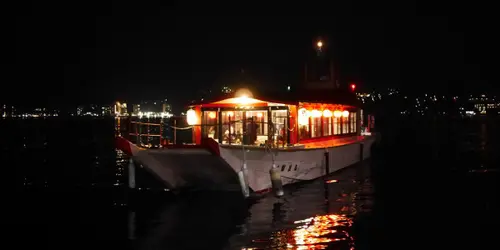
Miyajima Light-Up Cruise ©️Aqua-net Hiroshima
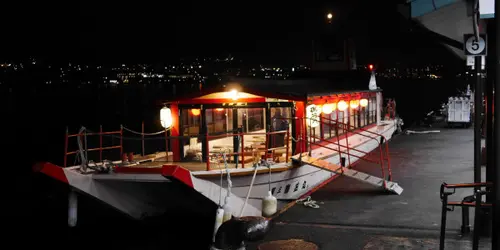
Miyajima Light-Up Cruise
- Hatsukaichi
- Add to favorites
The Miyajima Light-Up Cruise is the perfect evening activity if you are staying in Miyajima and want to enjoy the beauty of the shrine island.
A cruise to capture the beauty of Miyajima by night
This cruise takes you off Miyajima Island at night to enjoy the beauty of the illuminations. The Miyajima Torii (the gateway to the shrine), which stands majestically in the middle of the water, also called the "floating torii" , has become a symbolic image of Japan.
On this cruise, you will see the torii, if the tide allows, and the Itsukushima temple illuminated, and if the night is clear, the silhouette of the mountain in the centre of Miyajima Island.
Miyajima, the island sanctuary
Miyajima, or "Shrine Island", is an island off the city of Hiroshima which is so beautiful that in the Edo period, Shunsai Hayashi, a Confucian scholar, chose it to be one of Japan's three most beautiful landscapes, the Nihon Sankei.
Its real name is Itsukushima, and the island is home to the Ituskushima Shrine, a rare example of a shrine built on stilts, completely covered in vermilion (in Japanese shu-iro, the colour representative of Japan and with the particularity of expelling evil).
Ideal for an evening spent in Miyajima
On board, during the 10-minute cruise, you will be taught about the island, the temple, and their history.
This cruise is the perfect way to spend an evening in Miyajima.
Departure is from Miyajima's 3rd pier 6 times a day after 5:00 pm.
Choose your schedule and enjoy the scenery.
Please select your country on the list below:
- Switzerland
- United Kingdom
- Other countries
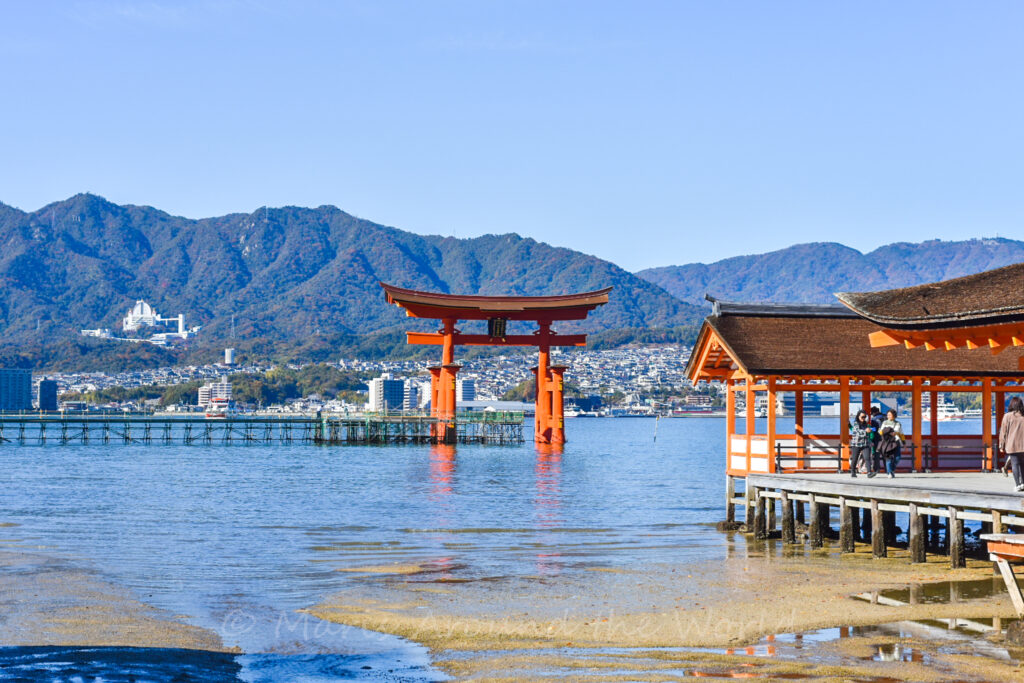
What to do on Miyajima – Overnight Stay and Day Trip Guide!
Just a ferry ride away from Hiroshima mainland is a small island known as Miyajima or Itsukushima. This peaceful piece of land is famous for its beautiful floating torii gate, nature spots (Mt. Misen and Momijidani Park ), seafood, and deer. Visitors flock to Miyajima to get away from the city bustle and experience luxurious ryokan stays and scenic views.
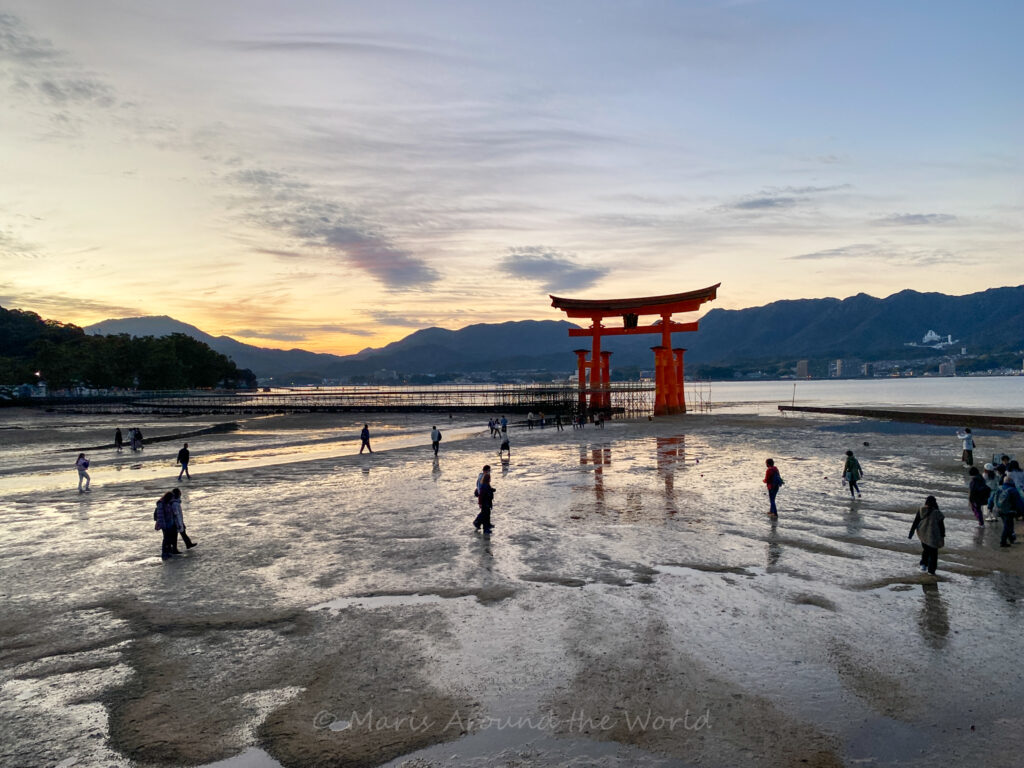
The area is easily accessible from central Hiroshima or Kyushu making it a great day trip destination or place for a weekend stay. For the most magical experience, I recommend booking a room and staying the night as the evening low tide with Itsukushima Shrine in the background is a sight that can’t be beaten.
For those traveling to Miyajima for the first time, here are some of the top things to do during your trip!
This post contains affiliate links, which means I may receive a commission if you purchase through my links, at no extra cost to you. Please read the full disclosure for more information.
Things to do on Miyajima Island
Visit itsukushima shrine (day and night).
- Hike Up Mt. Misen
Explore Daishoin Temple
Eat fresh oysters on omotesando street.
- Taste fried Momiji Manju
Stroll in Momijidani Park
Sip on miyajima craft beer.
- Eat in a hideaway restaurant
Relax in a Luxurious Ryokan
Miyajima is famous for its floating torii gate and sprawling vermillion shrine that kisses the water’s edge. The tori gate stands about 16 meters tall and is one of the biggest wooden torii gates in Japan. Itsukushima Shrine is a designated World Heritage site and offers iconic Japanese views of water, mountains, and shrine. There are several locations that are good for viewing the shrine, so spend some time walking along the water and soaking up the view.
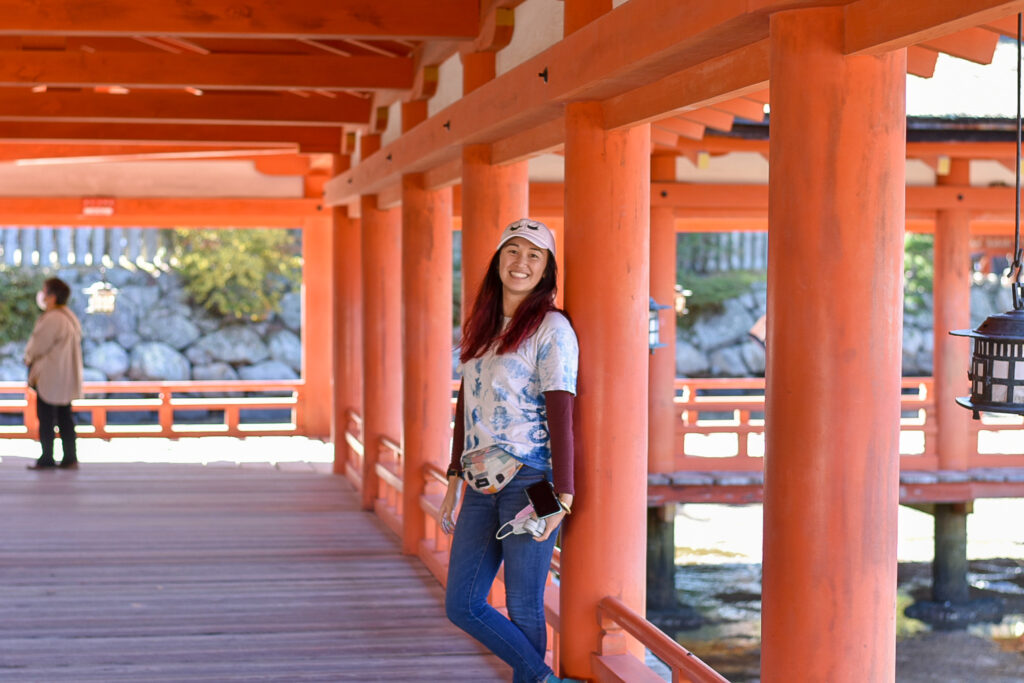
You can buy tickets to enter the shrine and see the floating tori gate straight on.
Most people visit Itsukushima Shrine during the daytime, but perhaps even more beautiful is the view at night once the water has receded. At this time, you can walk up to the torii gate as it is no longer surrounded by water. It’s rare to find a shrine like this in Japan so it’s my top reason for recommending travelers to stay the night!

Next to Itsukushima shrine on a hill is a five-storied pagoda that stretches 27 meters into the air. Unfortunately, it is just for viewing as it is closed to the public.
Hike up Mt. Misen
For energetic nature lovers, a hike up Mt. Misen is a must. There are several paths that lead to the top of the mountain, one located by Momijidani Park, another by Daishoin Temple, and the last further away on the island. (I recommend hikers take the path up by Daishoin Temple as it has a nicer elevation gain and views compared to the other trials.

It takes about an hour to climb to the top – maybe more if you stop often to take in the views.
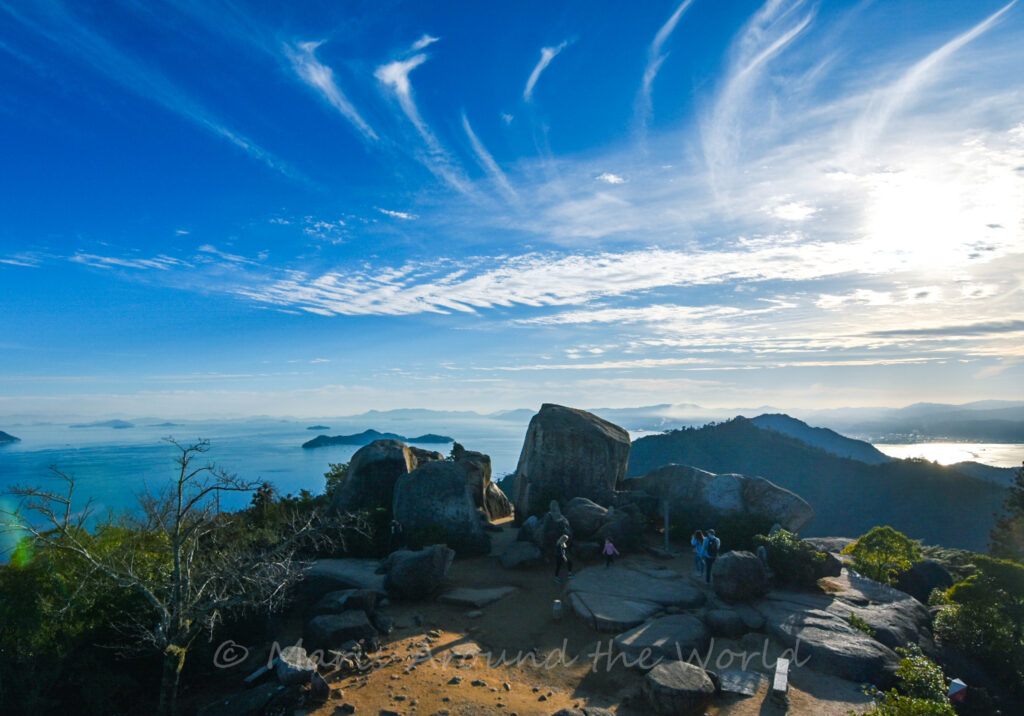
Close to the summit, you will be able to see important Buddhist structures including Misenhondo and Reikado which holds the Eternal Flame. At the top of the mountain, you will be rewarded with views of the water below and Hiroshima mainland sprawled out in front of you. The observatory at the top closes at 4 pm so place your hike accordingly.
Ropeway to Mt. Misen
If you want to get to the top without hiking, you can take the ropeway up most of the way. The ropeway entrance is located near Momijidani Park. Oneway fares are around ¥1,100 for adults and ¥550 for children. Read more information about taking the ropeway here .
Daishoin Temple is an important temple belonging to the Shingon Buddhism sect. It is located at the base of Mt. Misen and is home to over 500 buddha sculptures on the grounds. Climb the steps up this sacred temple and spin the cylinders that are inscribed with Buddhist scriptures.
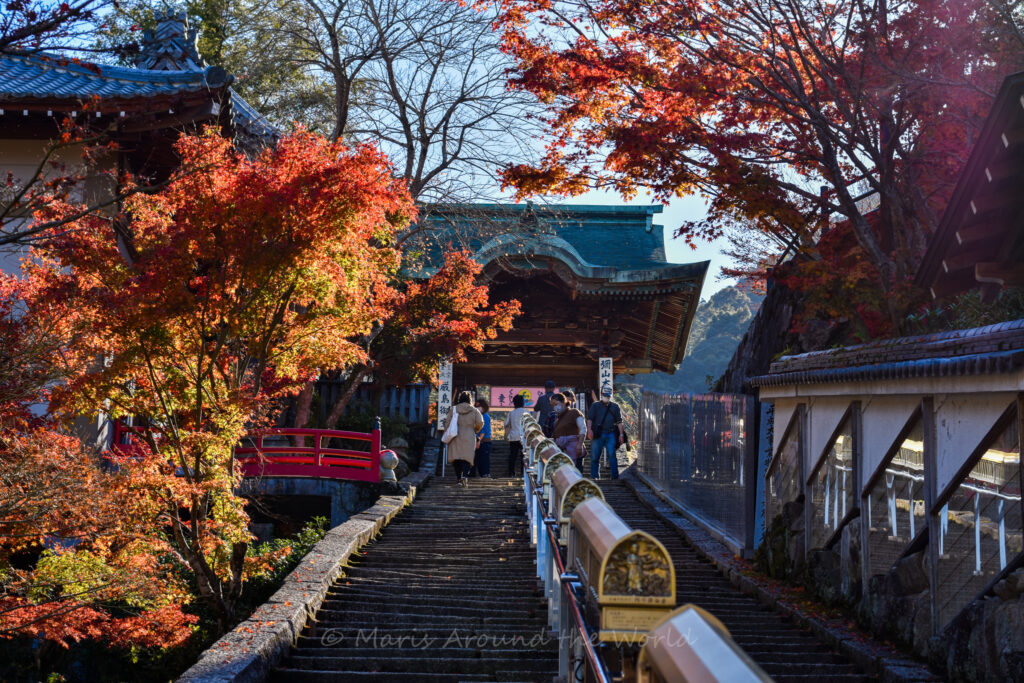
Ring the massive bell and view the Henjokutsu Cave where hanging lanterns shine an eerie light on hundreds of small statues.
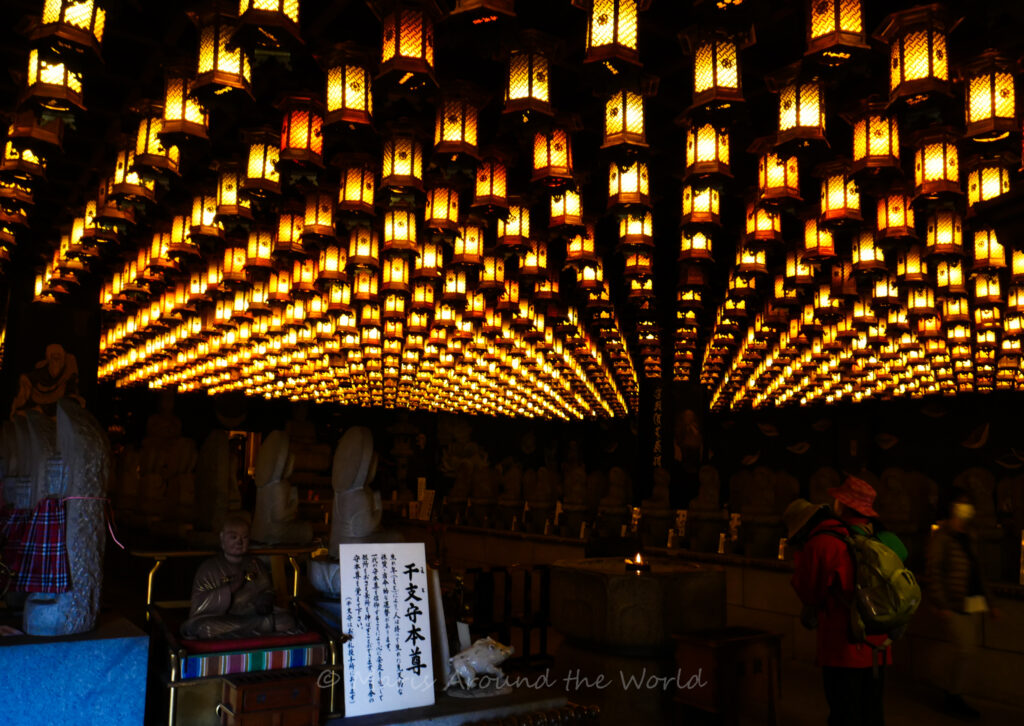
Daishoin Temple is a beautiful temple that is intertwined with the nature around it and has many small spaces to discover.
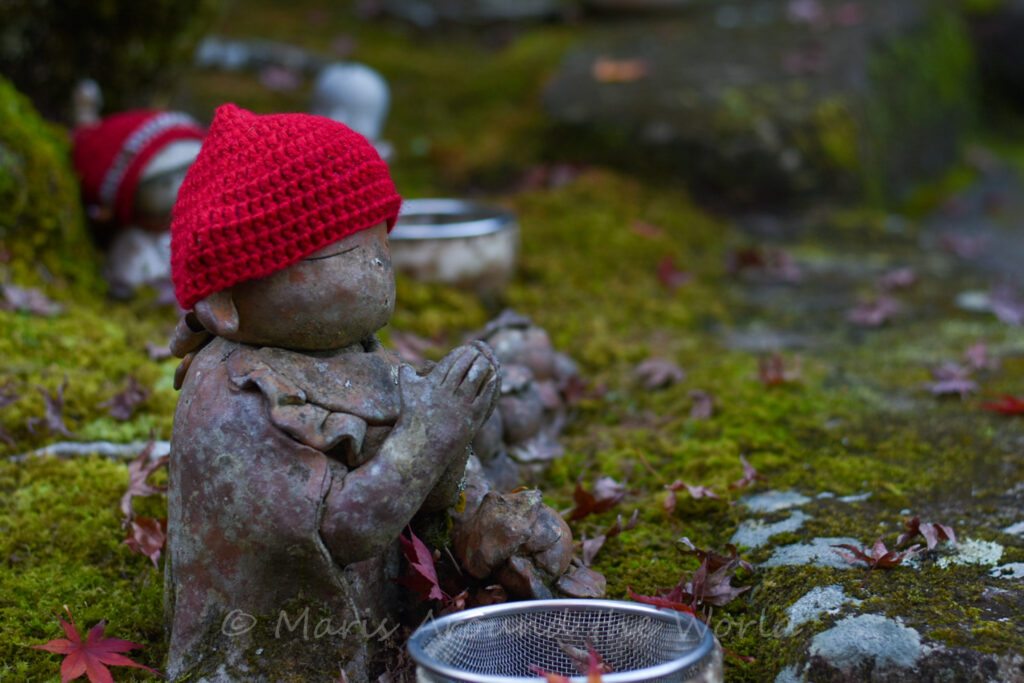
After wandering around the precincts, you take the nearby trail leading up to the top of Mt. Misen for a wonderful view of the area around Miyajima.
If you’ve come all the way to Miyajima Island, you will want to try some of the island fare. Prices are a bit on the expensive side – it is a popular vacation/tourist destination even for Japanese people – but make sure you still try an oyster or two.
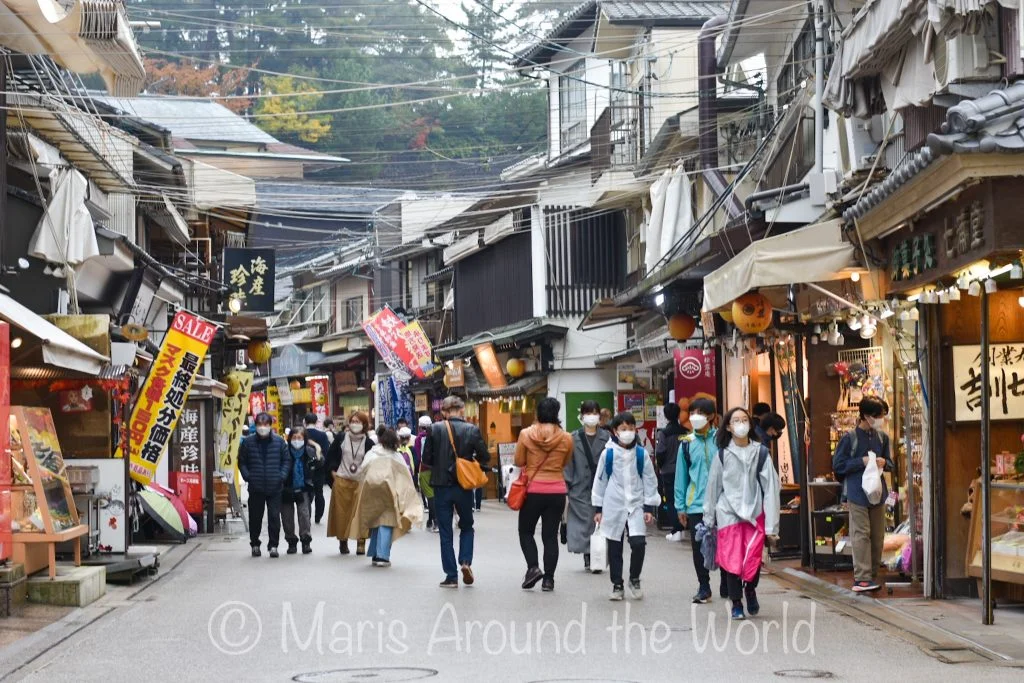
Yakigaki no Hiyashi – 焼がきのはやし
Restaurants on Miyajima serve oysters in a variety of ways: fried, boiled, over rice, raw. etc. On the main street, Omotesando Shopping Street, you will find an island favorite, Yakigaki no Hiyashi , ( 焼がきのはやし).
This restaurant is known for its high-quality grilled oysters which are grown until they are at least three years old.
As a specialty seafood restaurant located in the heart of a tourist destination, prices here are unsurprisingly high. However, the exciting thing is that the lunch sets allow you to enjoy oysters prepared in various ways, all in one meal.
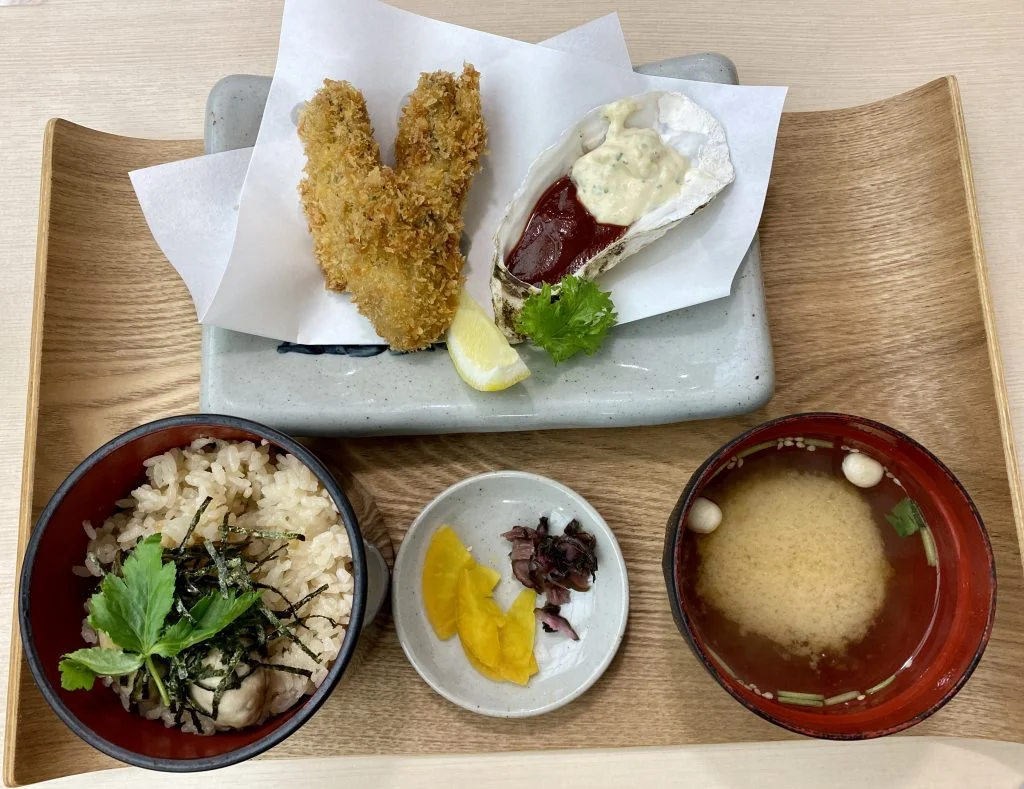
For example, one of the sets comes with two raw oysters, two grilled oysters, three fried oysters, oyster rice, miso soup, and pickled veggies for ¥3,000 (~$27). It wasn’t the most filling of meals (I guess I’m used to eating lots of oysters), but I found everything to still be delightfully tasty. Read more about Yakigaki no Hiyashi.
Kaki Fuku Maru (かきふくまる)
For a no-fuss oyster meal, head over to Kaki Fuku Maru . This little oyster shop is small and can only seat about six customers at a time. Since you have to order a drink to sit, most customers just stand outside and eat. Kaki Fuku Maru’s specialty is grilled oysters with a variety of toppings. Butter garlic is one of my favorites, but I also enjoy the spicy oil, and miso flavors.
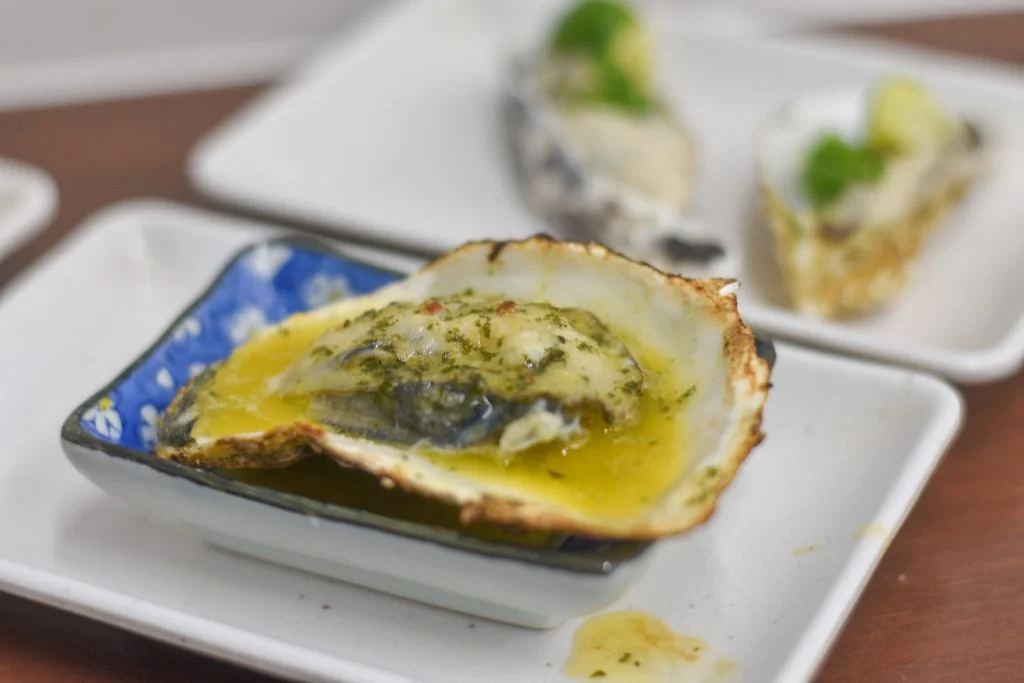
Compared to the oyster huts in Itoshima where you can get ~12 oysters for ¥1,000, the prices on Miyajima are unfortunately much, much higher. Nevertheless, if you are on the island, I still recommend grabbing an oyster or two and enjoying their salty freshness.
Oysters aren’t really your thing? Check out this guide for other foods to eat on Miyajima!
Taste Fried Momiji Manju
Momiji Manju is Miyajima’s famous confectionery that is shaped like a maple leaf (which is called momiji in Japanese). This cake-like dessert is traditionally made with a red bean paste filling, but many stores sell an assortment of other fillings like custard, apple, chocolate, and chestnut.

Hakataya on Omotesando Shopping Street takes the traditional Momiji Manju one step further by serving it deep-fried! They call this version Miyajima Jakee .
The added crunchy exterior and steaming filling make for a snack that is better than the original in my opinion. Warning: Be VERY careful when eating as the insides come piping hot.
If you are looking for a great place to see fall foliage in Japan, look no further than Momijidani Park on Miyajima Island. Around November, the park sparks to life with trees blanketed in vibrant hues of yellow, orange, and red. Even if you plan your visit outside of Momiji season, Momijidani Park is still a nice place to take a stroll in. If you are headed to Mt. Misen, the cable car entrance and one of the hiking paths are both located near the park.

Finding yourself craving a cool drink while walking around? Not to worry, Miyajima Brewery has you covered. This brewery specializes in craft beer.

The first floor has a small space for standing and drinking, while the 3rd floor has a great view and offers more of a restaurant vibe.
Small, regular, and large drink sizes are available, but for those who are indecisive, (or just excited to try more than one beer), you can enjoy a flight of any three pours.
Eat in a Hideaway Restaurant
On my latest trip, I found a lovely restaurant hidden away from the busyness of the main street. Niwa Cafe Miyama is tucked so far back that before I found the entrance, I was sure I was in the wrong location.

Few restaurants are open late on Miyajima so I was especially happy to have found such a nice place. The portions are a bit small, but the food I had: sashimi, fried squid legs, okonomiyaki, chicken wings, Miyajima sake, and beer were delicious.
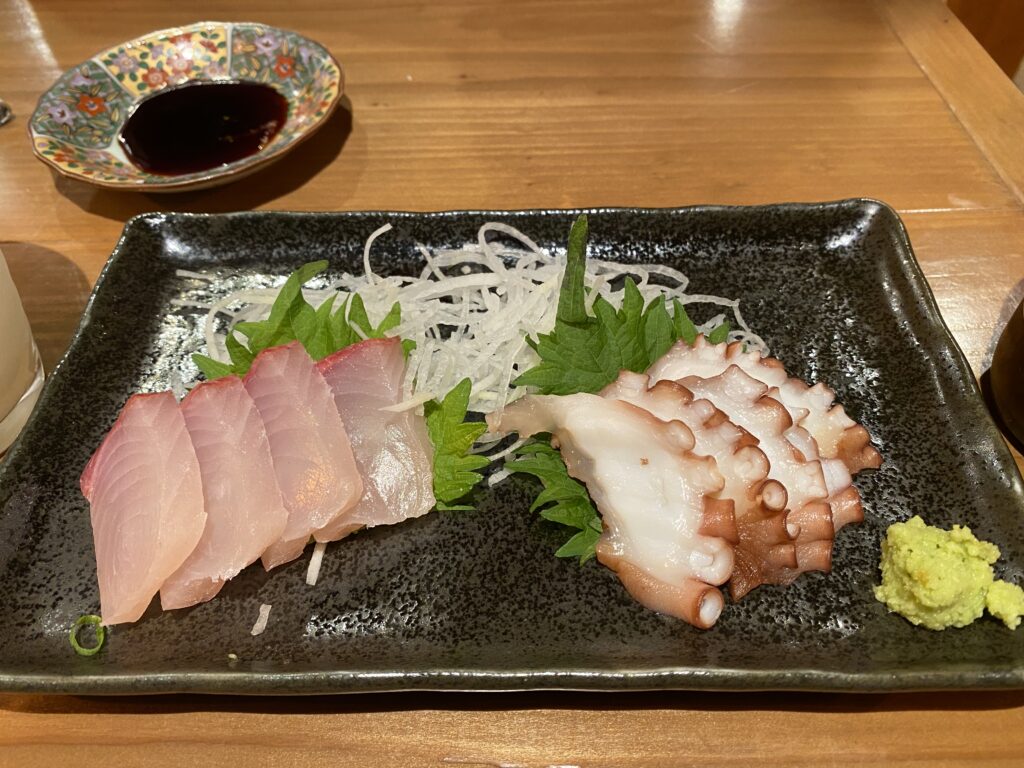
For the ultimate luxury experience, you will want to stay at a ryokan (Japanese-style inn) which comes with beautiful Japanese rooms, full-course meals, and attached bathing facilities. I stayed at the Miyajima Grand Hotel Arimoto the first time I visited the island and was not disappointed in the least. Staying at a ryokan is unlike staying at a normal western hotel and is something you should definitely experience once while traveling in Japan.
There are other more affordable options on Miyajima if you are looking for a simpler place to stay. I have stayed at Sakuraya multiple times and while it’s not fancy, it is located super conveniently by the water near the ferry port. It has Japanese-style rooms and a small public bath you can enjoy during your stay. (Meals are not provided at Sakuraya).

Visiting Miyajima Island
Hopefully, the above list has given you some ideas for how to plan your next trip to Miyajima. Enjoy the fantastic scenery the area has to offer and remember to keep your food away from the deer!
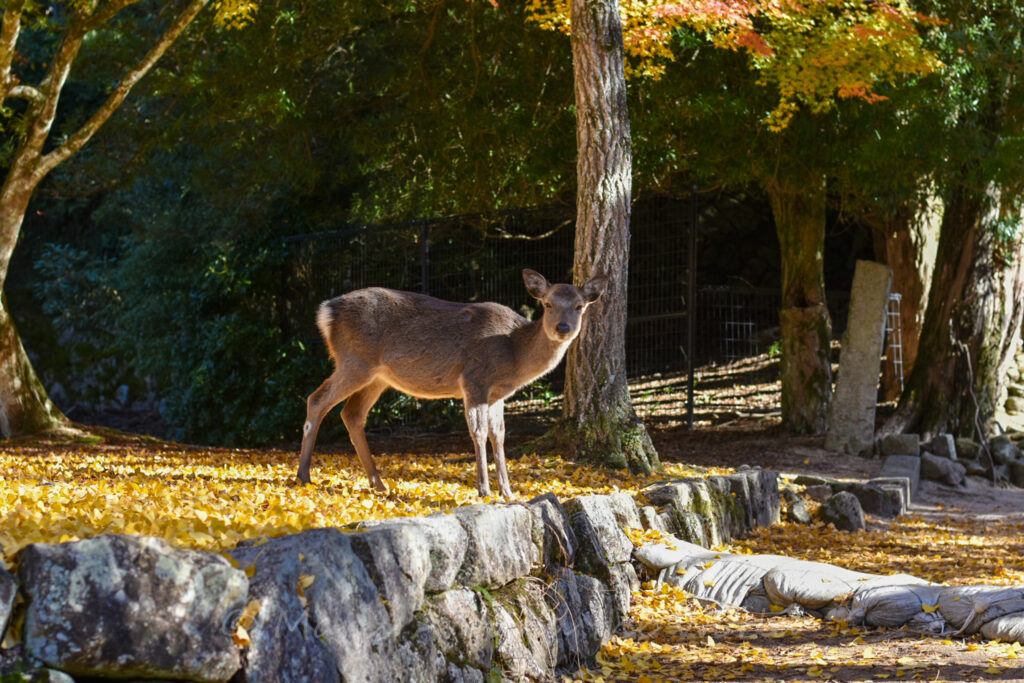
For more about Miyajima Island, check out these posts!
- Miyajima Island’s Momijidani Park – An Amazing Place for Fall Foliage in Japan
- Best Food to Eat on Itsukushima Island (Miyajima)
Nearby Miyajima Island
Wondering what to do after your trip to Miyajima Island? If you’re on your way to Hiroshima, be sure to visit Hiroshima Peace Park, Hiroshima castle, and feast on the region’s famous okonomiyaki. From Miyajima island, you can take a special ferry that drops you off right at the Hiroshima Peace Park.

If you want to explore an entirely different region of Japan, then hop on a Shinkansen and continue south to Kyushu. In Kyushu, you can find cozy onsen towns, places with beautiful beaches and bike routes, and delicious food galore. Check out more Kyushu adventures below!
- Craft Inn 手 [té]: An Immersive Art Experience in Yame, Fukuoka – Stay in a beautiful traditional inn surrounded by art.
- Day Trip to Dazaifu Tenmangu Shrine from Central Fukuoka
- Herbal Steam Bath Detox -Kannawa Mushiyu in Beppu, Oita
- Children’s Day Carp Festival (Koinobori, 鯉のぼり) at Tsuetate Onsen
Share this:
Share your thoughts here cancel reply.
- Joy in HIROSHIMA
100 STORIES
MIYAJIMA NIGHT CRUISE – Beautiful Torii Gate Light Up Seen From The Water
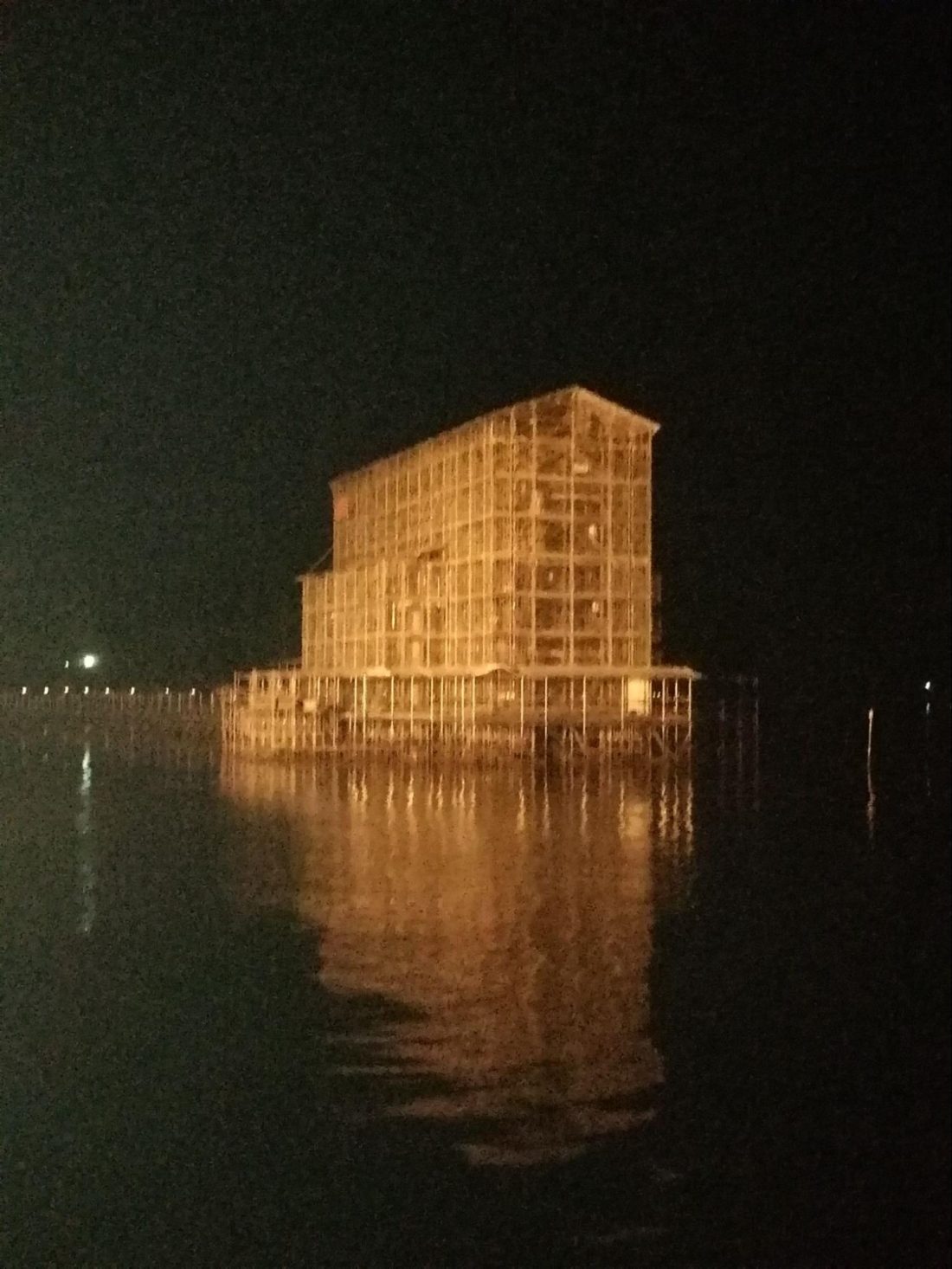
The Red Torii Gate is the symbol of Hiroshima, and one of the three most beautiful spots in Japan, officially. Even now, under repair and renovation as it is, it is still one of the major tourist draws of the region. So finding new, unique and special ways to view it is also one of the best ways to get the most out of any visit to Hiroshima.
- 01. THE BOAT AND THE BACKGROUND
- 02. THE SUPPLICANT’S JOURNEY
- 03. THE GATE
- 04. MOMENT OF JOY
- 05. FINAL PRO TIPS
Getting a local guide won’t always help there. Those of us who have lived here a long time sometimes tend to just go to our familiar spots for views of the Torii. Really, if you look at your own photos and postcards of the area, you’ll see many or most of the angles are similar. The prime viewing points are well known to all.
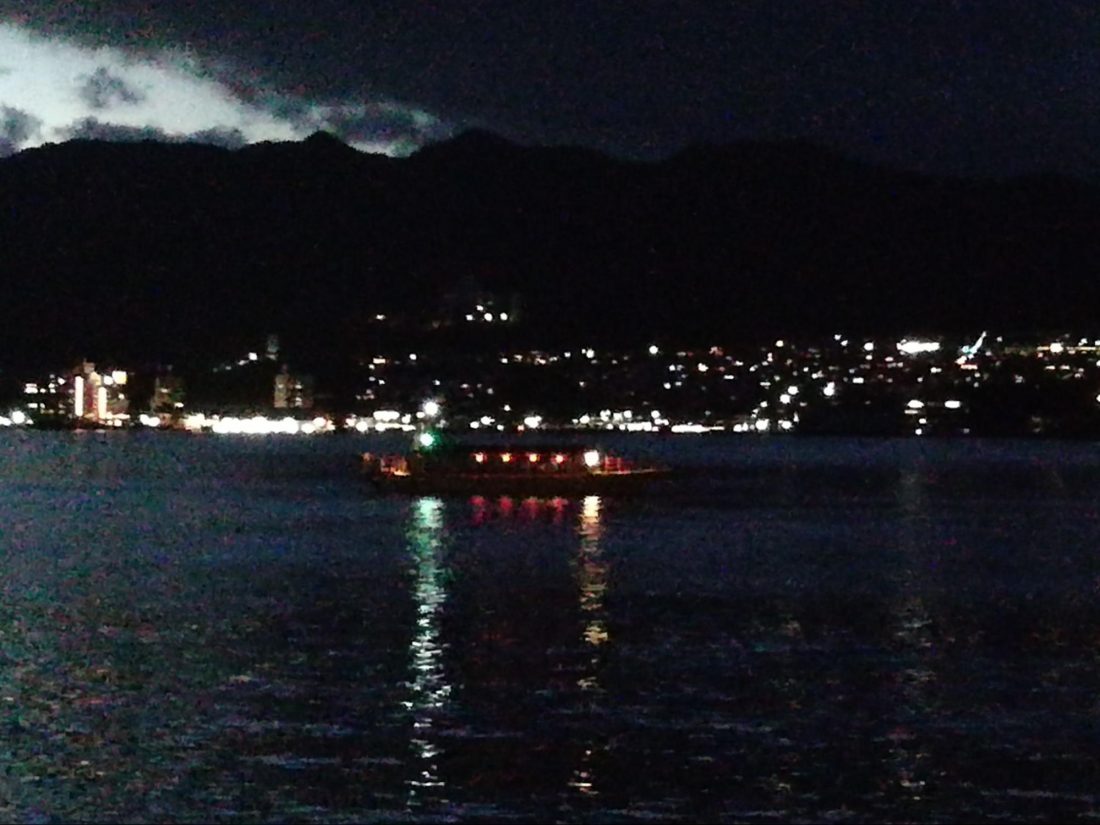
THE BOAT AND THE BACKGROUND
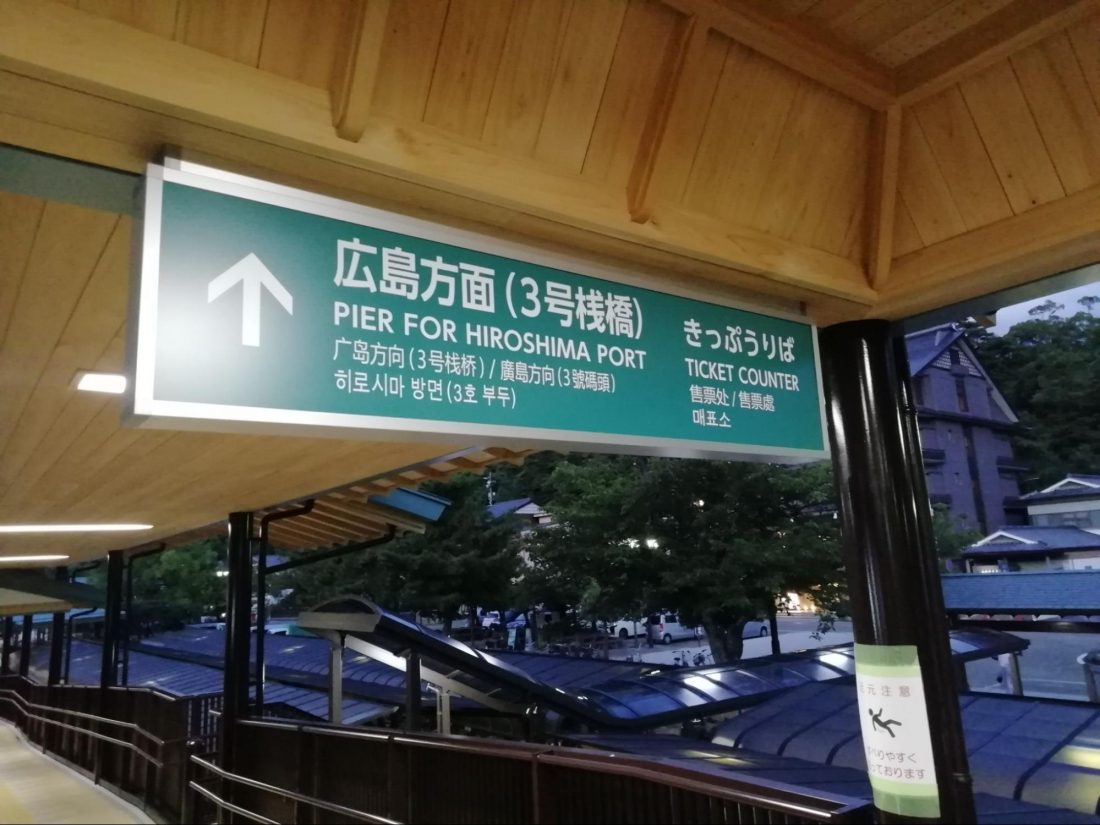
It turns out that Pier 3 is a separate dock here at the same port, but not sharing the same terminal building. Instead you make a short walk down a lovely wooden platform, walk past a parking lot full of cars, and then turn left toward the water to find a small wooden building that acts as a separate ticket office, another building that is a waiting room, and then Pier 3. This pier is used during the day for the ferry that runs to Ujina port, not Miyajiamaguchi. At night, a smaller boat uses it for these night cruises.
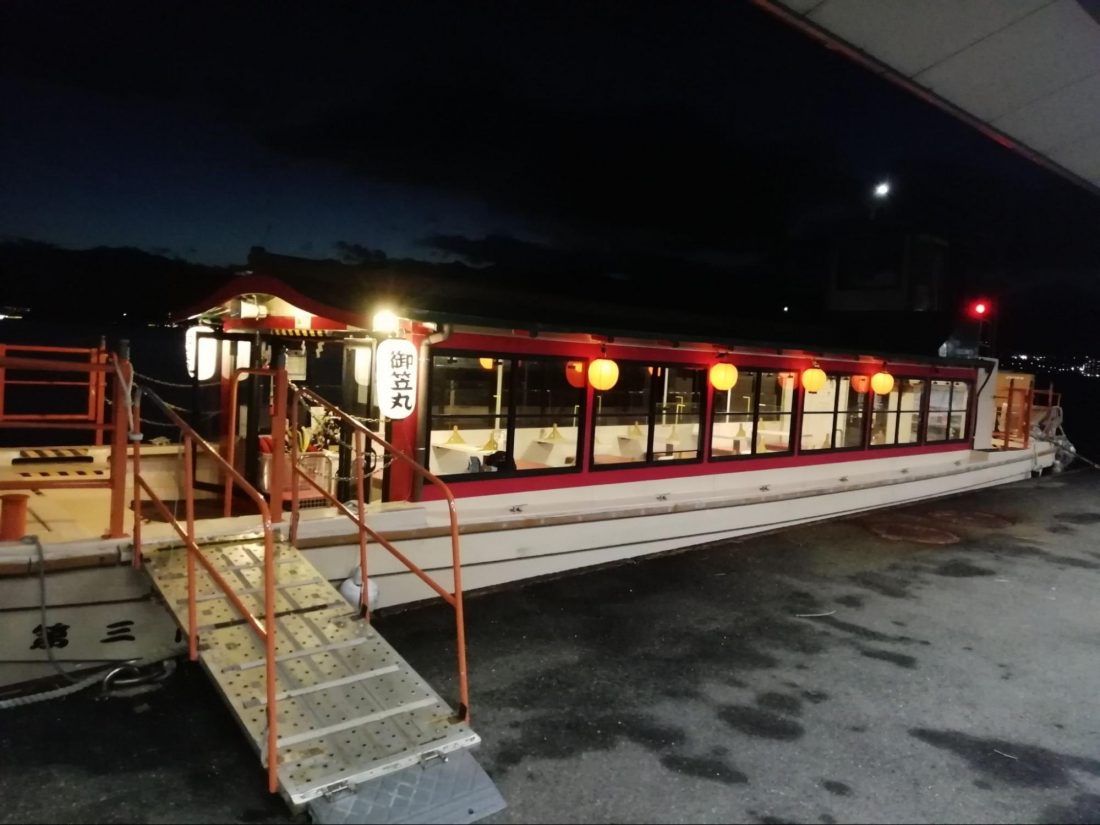
In the past there were no hospitals of any kind, either. Today, there is one. However, even that one closes at night, necessitating a trip to the mainland. And since the ferries stop around 10 p.m., that usually means an overnight on the mainland. Thus, my guide explained, many people on the island are said to just tough it out when they feel sick in the evening, rather than go to the mainland overnight. Also, leftover from the centuries of religious tradition, there is still to this date no convenience store on the island, and also no burials. Yes, even the residents here now will eventually be buried on the mainland out of respect to Miyajima.
Our guide also explained about the history of the name of the shrine on the island. Centuries ago it was ItsuKIshima, and now it is ItsuKUshima. While the change seems relatively minor, owing to kanji (Chinese characters), in fact it’s a large change. From three kanji down to one. The meaning, now, is literally “island of the gods”. The shrine was built on the coast, and the great gate is out in the water because the island itself was sacred, so approach should be by water only. This explains the iconic image of the great floating “torii.” The guide explained that our boat then would mimic the approach of a supplicant to the shrine.
Nearly all of this explanation came before we even departed, though disseminated rapidly. I filled in some of the gaps when talking to the guide throughout the trip. I checked, as well, about non-Japanese speaking tourists. The guide said that a video is played in the cabin with English subtitles, but with the sound turned off so that her own voice doesn’t have to compete with the video. Once underway, it’s mostly an issue of smiles and gestures, though some of the guides have learned a little English. I explained as much as I did above largely because it might not be clear when on board. But let’s set off.
THE SUPPLICANT’S JOURNEY
First, it was fascinating to see the sleeping “kannon” or deity soon after the ship pulled out. I had long known that the island itself was sacred. I had also known it was home to a female deity. I had never heard it said that the island itself LOOKED like a female before, until the guide’s speech in the cabin. But once she told me, and showed the sketch of what to look for, it was clear as a bell. My jaw dropped. It was so easy to spot it is really quite remarkable. Sadly, my phone’s night lens is weak. I don’t think you can see it well in the photos I was taking. Pro Tip: look for it in the daytime for the photos to impress your friends. If doing a night cruise like me, at least be sure your camera or smartphone has a really good night setting. My photos simply don’t live up to what I was seeing with my eyes. I tried enhancing my photos, but though it was clear to my eye even through my camera lens, I don’t have a good enough photo for here. It truly is easily spotted, however.
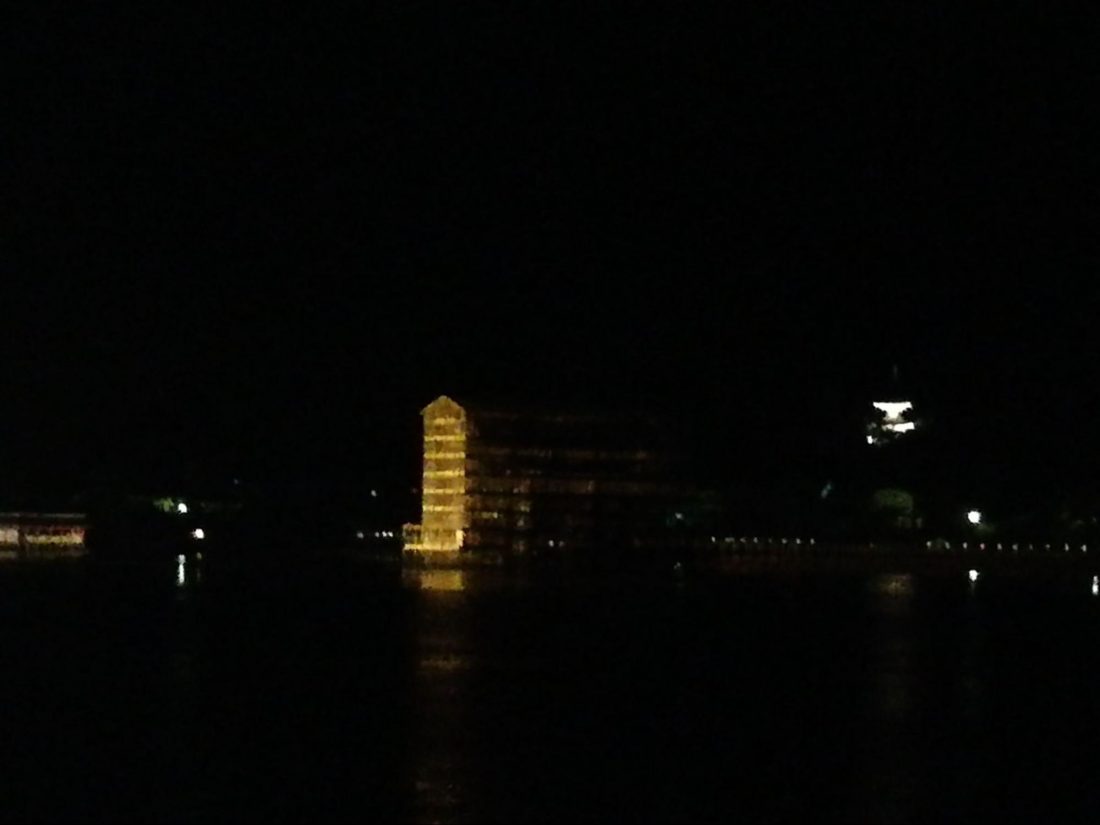
Once the gate was in sight the guide explained more details about the gate floating because approach to the shrine meant approach to the entire island, and thus from the sea. She explained more, too, that supplicants approaching, as with all mainland shrines, are truly meant to approach through the torii. Since in the past no one lived on the island, and there were no ferries, all boats approaching the shrine, though smaller and not engine-powered like ours, made a similar approach as ours.
First, it is important to get lined up squarely with the gate and the shrine. Then one is to turn around three times before proceeding forward. Our boat thus mimicked this. After heading across the bay from the pier, it turned to face the gate, and then proceeded to make a graceful, slow 360 degree turn. In deference to modern times, it only turns once, the guide laughingly explained. Turn complete and squared up again the boat pauses, and then slowly proceeds right up to the gate.
As frustrating as it is that the gate is fully scaffolded and has had its paint removed during the renovation process, there is still a massive spotlight shining on the gate, and honestly, with the shape of the gate thus penetrating the scaffolding as a kind of spooky shadow, it was still quite alluring and fascinating to see. Especially as the boat creeps more and more forward and the gate just grows and grows in front of you. When the scaffolding is gone, the new red paint shining in the spotlight, and the boat actually passing through torii it’s going to be mind-blowingly amazing. I can’t wait!
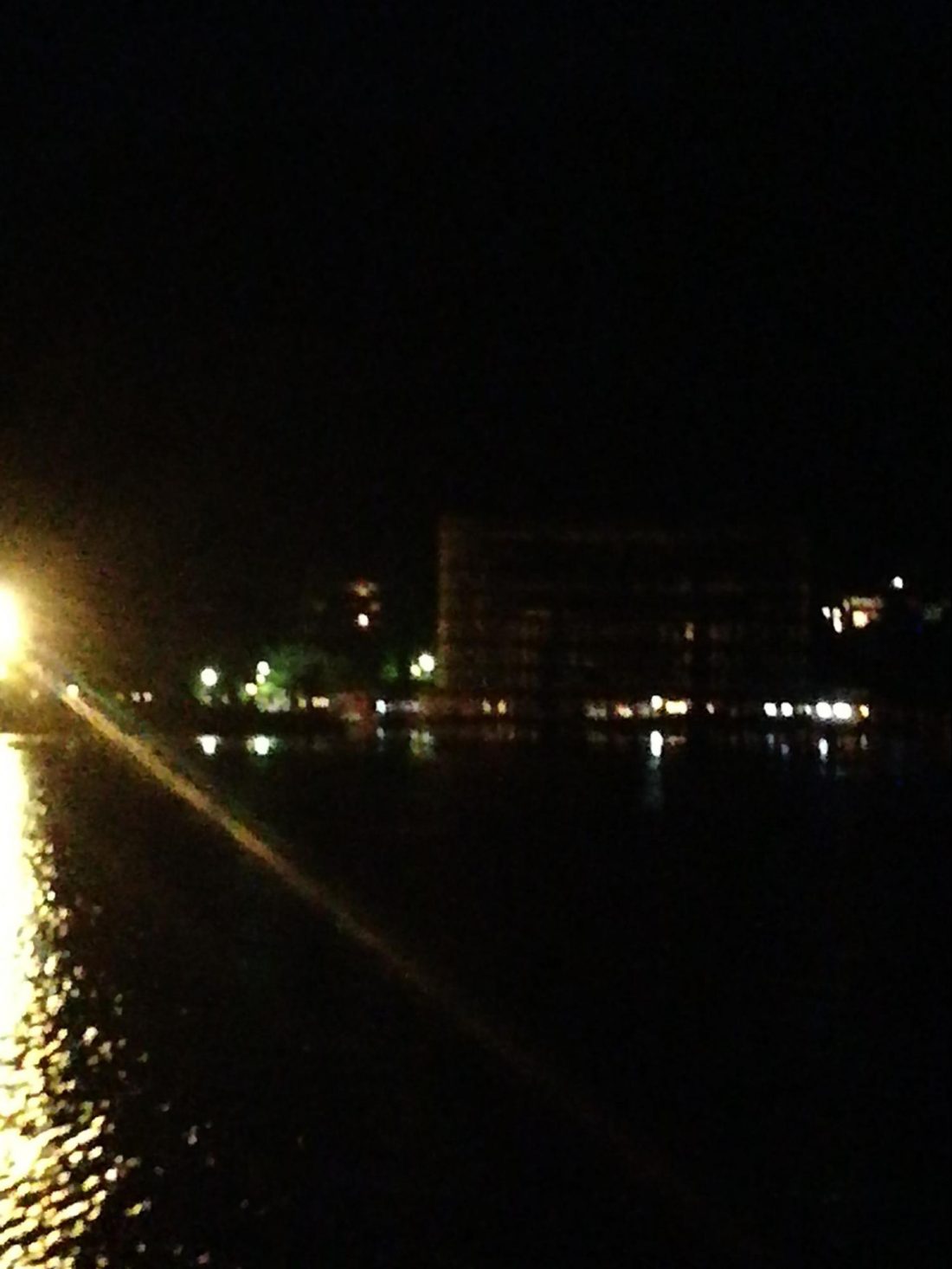
MOMENT OF JOY
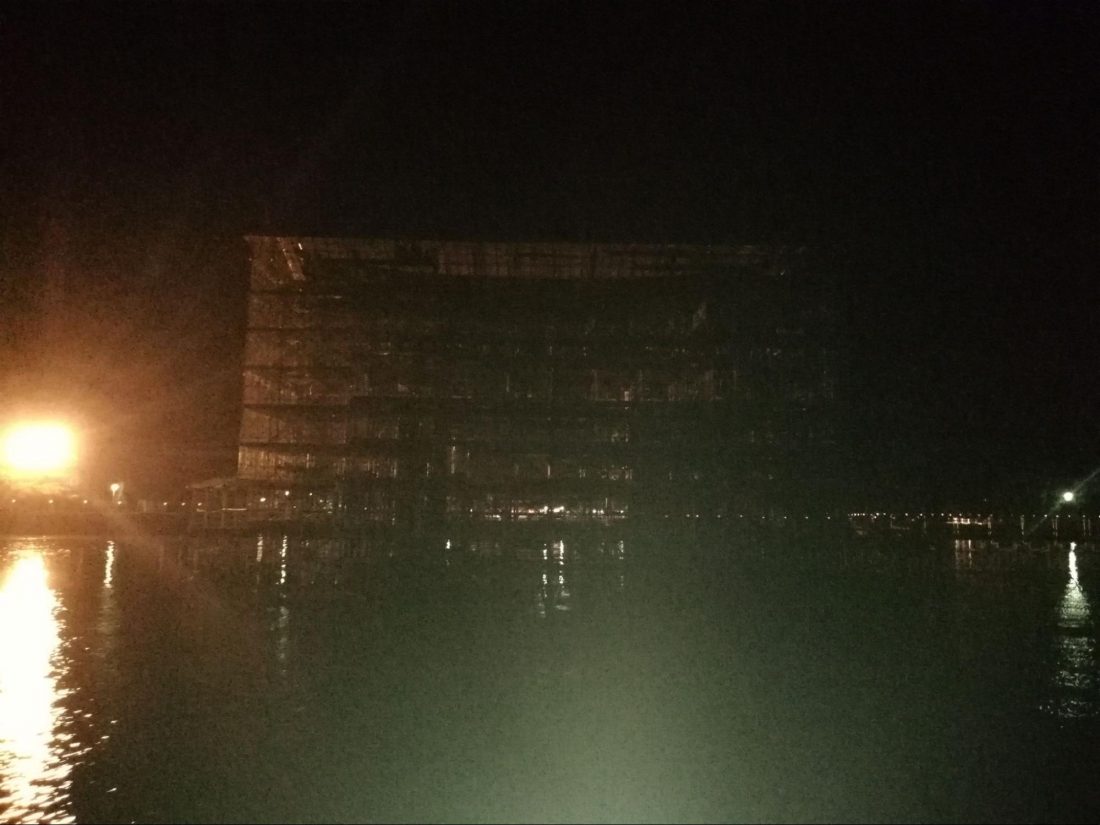
FINAL PRO TIPS
* It’s possible to phone in a reservation, but not really necessary. There is a little ticket office by Pier 3, and you can go directly there and make a reservation which saves any hassle of trying to deal with language over the phone. There are six different cruises every night. You pay in advance for the cruise that you want, write your name on a provided paper, and then go out and explore or eat or find some deer to photo, just being sure to be back 10 minutes before your departure.
* This is a night cruise. Go AFTER sunset. I went on the fourth cruise, the 7:55 p.m. departure. The cruise just before, at 7:15 had six passengers. My cruise was only me. (The cruise after had at least 10 that I saw when departing, including some wearing the complementary hotel yukatas). My guide and I commented on the shame of those six
passengers on the cruise before; the torii was not really visible through the scaffolding because it wasn’t dark enough for the spotlight to penetrate and illuminate. She wanted to tell those passengers to come back on a later cruise. So time it right. It’s worth it to wait. If you are not staying on the island, as I wasn’t, my cruise finished around 8:25, and there is an 8:40 ferry back to the mainland. The last ferry back is actually 10:14 if you want the blackest night possible, but really the fourth or fifth cruise times are your best options. Enjoy!

- The Ultimate Day Trip to Hiroshima and Miyajima
by Julie Jan 13, 2019 Itinerary , Japan , Travel

Remember the first time you heard those two names?
For me, 5th or 6th grade. I can’t remember which grade exactly, but I remember which part of the school my classroom was in, so it must have been one of those two grades.
I even remember where I was sitting: round table in the back of the classroom.
My classmates and I were shown a film about the dropping of the first atomic bomb. Thank goodness the film did not spare any of the gory details: charred bodies, burned victims, and radiation poisoned survivors. I’ll never forget the shadow of a person that had been permanently imprinted on a wall. It left an indelible impression on me. Human beings are cruel. Governments are cruel. And from that moment on, I strongly believed that the United States had been wrong to have used a nuclear weapon on Japan.
I even remember the first time I met someone from Hiroshima. I was living in China, and I was having lunch with some Japanese classmates from my Chinese class at the university. When my classmate told me she was from Hiroshima, I immediately felt ashamed and embarrassed. She must really hate me I thought. I wanted to apologize to her. However, since I’m really bad at expressing my emotions, I said nothing.
And then I decided to go to Japan. Like I always do, I downloaded tons of books onto my Kindle and borrowed even more from the library.
I’m a nerd and what nerds do is they do a lot of research. And so I read and read as much as I could about Japan.
And the more I read, the more I became uncertain about the bomb. Was it really necessary? Maybe it was, or maybe it wasn’t. I just wasn’t sure anymore. Was the U.S. justified?
From 1937 to 1945, 24 to 32 million died in Asia. 10 to 20 million of those people were from China. 1 to 2 million were from Vietnam, Cambodia, and Laos. 3 million were Japanese. Comfort women. Nanking. Sook Ching. But a nuclear weapon? That is the worst cruelty of them all, isn’t it?
I had to go to Hiroshima and see for myself. Maybe the city would have some answers for me. And so I embarked on a trip to Hiroshima in search of the answer to this burning question: to end the war, was it necessary for America to drop an atomic bomb on not one but two Japanese cities killing between 100,000 and 200,000 people?
I found that as I toured the one remaining building, a park and a museum, my views changed in a surprising way from the beginning of my visit to the end.
Here are some of the books that I have read as I searched for answers. Following that, is a 1-day itinerary for both Hiroshima and Miyajima. Sprinkled in between the itinerary are my thoughts and feelings and a bit of history.
Disclosure: This post may contain affiliate links. As an Amazon Associate and a Bookshop.org Associate, I earn from qualifying purchases. Please see this website's Disclosure for more info.
In This Post, You'll Find...
- 7:00 am – Leave Kyoto
- 9:00 am – Arrive in Hiroshima
- 10:00 am – Atomic Bomb Dome
- 10:20 am – Peace Memorial Park
- 11:00 am – Hiroshima Peace Museum
- 1:00 pm – Lunch
- 2:00 pm – Travel to Miyajima
- 3:00 pm – Arrive in Miyajima
- 5:00 pm – Leave Miyajima
- 6:00 pm – Dinner
- 7:00 pm – Leave Hiroshima
Hiroshima is located about two hours by train from Kyoto and an hour and a half by train from Osaka, making it an easy day trip from either city.
Hiroshima is such a nice city that one would be hard-pressed to associate it with the dropping of the first atomic bomb. The only real reminders of that event are a park, a museum, and the remains of one building.
The city, though, is more than just this tragedy. For foodies, Hiroshima is famous for its okonomiyaki, a Japanese version of a pancake. It’s super unhealthy but very delicious! It’s also different from other versions of okonomiyaki. And Hiroshima is famous for oysters. You can have okonomiyaki with oysters.
There are several museums and a castle in the city as well. However, since the museums are not as good as those in other cities and the castle is a complete replica, I think a Hiroshima 1-day itinerary is enough.
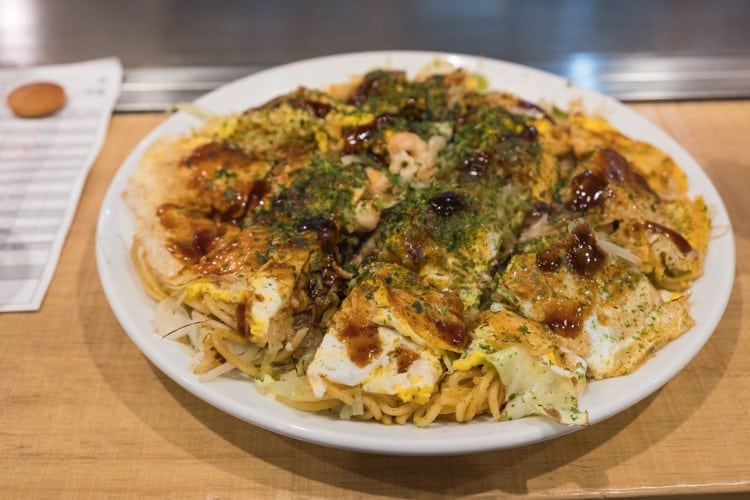
The other part of your journey is a trip to Miyajima. Miyajima is a small island that is around 45 minutes by train and ferry from Hiroshima. It’s famous for being one of the top three most scenic spots in Japan with its iconic floating torii gate . .

If you’re short on time, you can easily make a Hiroshima and Miyajima itinerary into a day trip from Kyoto or Osaka. I’ve outlined the perfect Hiroshima and Miyajima 1-day itinerary from Kyoto , but you can do this trip even more easily from Osaka. I’ve outlined how you can turn your Hiroshima and Miyajima visit into a day trip.
You can tour these two places by touring Hiroshima in the morning and visiting Miyajima in the afternoon or vice versa and see Miyajima in the morning and Hiroshima in the afternoon.
BONUS: I've created a FREE detailed PDF version of this 3-week Japan itinerary. The guide also includes step-by-step instructions for buying and using your Japan Rail Pass.
Click here to get lots of great tips for traveling around Asia as well as this FREE 3-week Japan itinerary guide.
Hiroshima + Miyajima Itinerary
7:00 am – leave kyoto or osaka by train.
To complete a Hiroshima and Miyajima itinerary in one day, you’ll need to start out early in the morning from Kyoto (or Osaka). As of January 2019, the Shinkansen (bullet train) Hikari train departs Kyoto at 7:20 am and arrives in Kyoto at 9:05 am. You can use your Japan Rail (JR) pass for this train. If you don’t have a JR pass, it’ll cost you ¥6,480 (US$61 / €52 / £47) from Kyoto .
⇒ Please check the train times on Hyperdia .
9:05 am – Arrive at Hiroshima JR Train Station
Once you arrive at the Hiroshima JR Train Station, go immediately to the tourist information center inside the station. Ask for all maps of Hiroshima, transportation information, a free Hiroshima sightseeing guide called Seeking Hiroshima, and the train schedule to Miyajimaguchi , where you get the ferry to Miyajima.
Make sure to ask them where to catch the bus for the Atomic-Bomb Dome.
Getting to the Atomic Bomb Dome and the Peace Park
Hiroshima has 3 sightseeing buses that are free for Japan Rail pass holders . If you don’t have a JR Pass, it’s ¥200 (US$1.85 / €1.60 / £1.45) per ride or ¥400 (US$3.70 / €3.20 / £2.90) for a day pass. You can catch these buses from the train station outside the Shinkansen entrance. The tourist information center will point the way.
The buses are the Green Route, the Lemon Route, and the Orange Route . Unfortunately, the names of the buses have nothing to do with the colors of the buses. They only correspond to the colors of the routes on the map.
- Green Route : Runs every 30 minutes. It starts at 9:00 am until 5:45 pm.
- Lemon Route: Runs every 20 to 30 minutes. It starts at 9:30 am until 5:30 pm.
- Orange Route : Runs every hour. It starts at 9:00 am until 5:00 pm.
All loop sightseeing buses start and stop at the JR Hiroshima Train Station and all of them pass by the A-Bomb Dome, the Peace Memorial Park, and the Peace Memorial Museum. The only difference is that they take different routes and times to get there. They are the perfect way to get around during your Hiroshima itinerary.
To the A-Bomb Dome and Peace Museum, the Green Route is the fastest . It goes directly to the A-Bomb Dome and gets you there in 3 stops. In 2018, the bus left at 9:45 and took about 15 minutes to get to the Atomic Bomb Dome.
(COST: Free; OPEN: 24/7)
Start your Hiroshima 1 day itinerary at a place that perfectly exemplifies the power of human beings to destroy each other. Situated on the bank where the Honkawa River splits into two, stands the remains of the Hiroshima Prefectural Industrial Promotion Hall which had been designed by a Czech architect. The bomb exploded pretty much directly above the dome killing everyone inside.
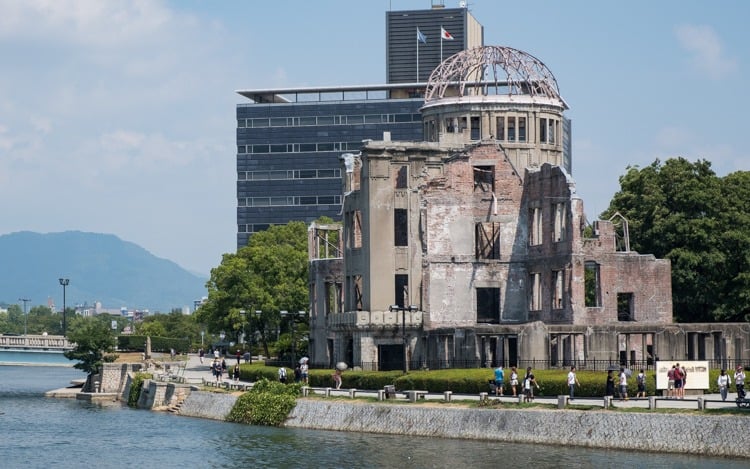
In early 1945, the United States started conducting incendiary bombing raids on Japanese cities, indiscriminately killing tens of thousands of people per raid. It was easy for the buildings to catch fire and for the fires to spread since Japanese buildings at that time were predominately built out of wood.
By the end of the war, 50% of Tokyo had been destroyed and over 100,000 Tokyo civilians had died.
To give you more of an idea of how much Japan lost from the war, 26% of Osaka, 31% of Nagoya, 44% of Yokohama, and 51% of Kobe had also been destroyed.
Hiroshima had been one of the few major cities (Kyoto and another city) that hadn’t been bombed by the Americans.
Not having been attacked yet, Hiroshima turned out to be the perfect testing ground for the atomic bomb as the Americans could thus get “an unbiased assessment” of its power ( History of Japan podcast ).
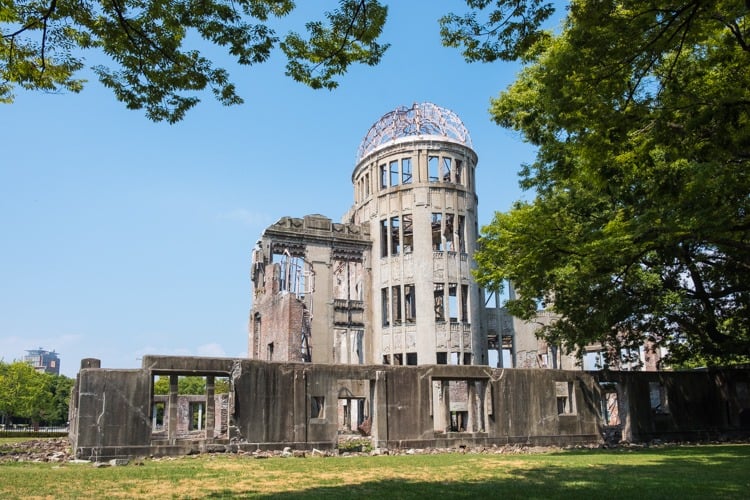
The Prefectural Hall was not the only building still standing after the bomb fell. 62,000 of 90,000 buildings were destroyed and 6,000 became unrepairable. However, the Hall was the last building that was set to be demolished in the 1950s. Instead, it was decided to preserve it as a reminder of the consequences of war. In 1996 it became a UNESCO World Heritage Site.
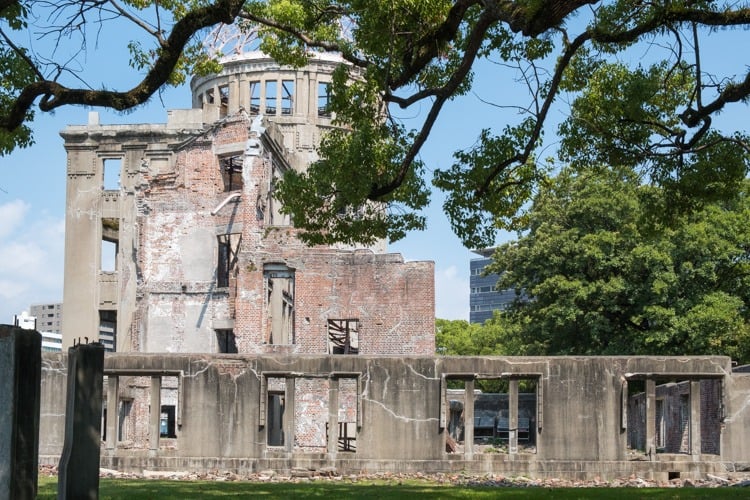
I was quite moved by the site of this building. It really hits home how futile war is. Why did the Japanese start this war? Why did the people go along with it for so long? Was it really necessary to drop the atomic bomb on innocent civilians?
You might be interested in these Japan travel posts:
- Kyoto Itinerary 4 Days: A City of a Million Temples
- The Best Ever Guide to the Tateyama Kurobe Alpine Route
- Kamikochi Hiking: A Perfect Day Trip from Takayama
10:30 – Peace Memorial Park
After walking around the dome and contemplating what it means, continue your Hiroshima itinerary by crossing the bridge to the Peace Memorial Park.
There are tons of monuments throughout the park to honor the victims of the atomic bomb. If you’re going to make this visit a day trip, there just isn’t time to see them all. Look at your map and the list of monuments and decide which ones you’d like to see. I wanted to see the Monument Dedicated to Korean Survivors and Victims, but I couldn’t find it.
However, there are a few Must-Sees in the park that you should include in your Hiroshima 1-day itinerary.
1. Peace Bell
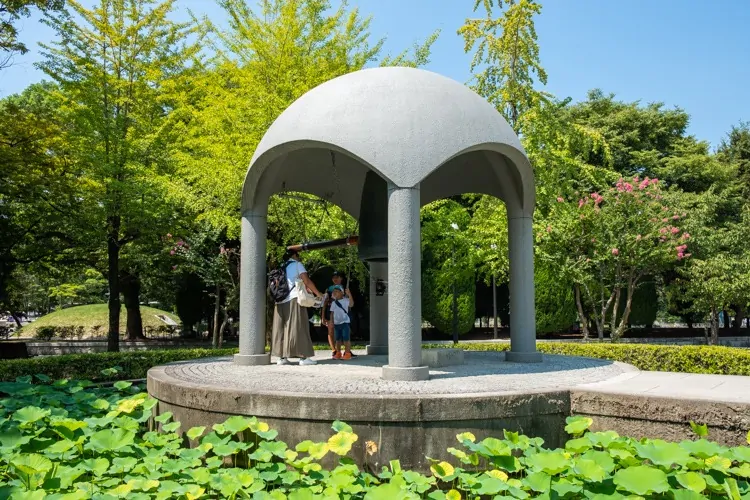
2. Children’s Peace Monument
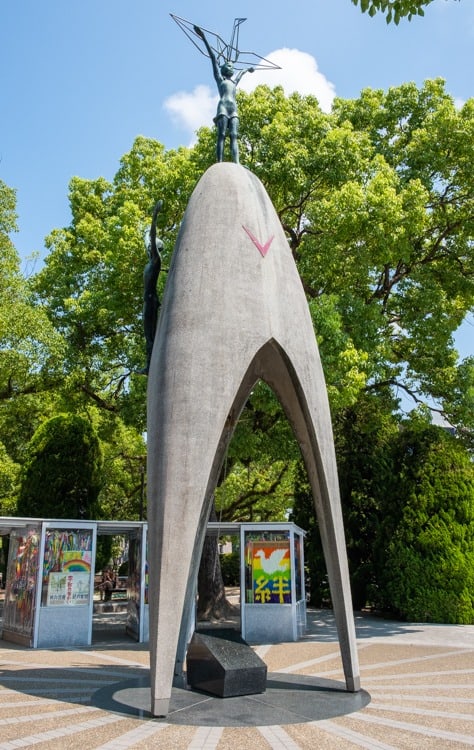
Sadako Sasaki was 2 years old when the bomb was dropped. At the age of 11, she got leukemia. She decided to make 1,000 paper cranes, which means longevity and happiness in Japanese. She thought that if she could make them all, she would get better. She didn’t make it. But her classmates folded the rest. This statue was built in her honor.
At the top, you can see a statue of a girl. There are also colored paper cranes made by school children from Japan and the world in glass cases at the back of the statue.
How many people died from the bomb and how did they die?
We are not sure of the exact number, but it’s estimated that between 90,000 and 140,000 died out of the 245,000 people who were in Hiroshima at the time of the bomb.
25% died from direct burns, 50% from other injuries, and 25% from radiation.
I don’t know if these numbers include those people who got cancer years later.
Would Sadako have gotten leukemia if she hadn’t been in Hiroshima at the time the bomb was dropped?
It is true that people who were in Hiroshima during the bomb had higher rates of cancer, especially leukemia, than normal. If a survivor were less than one kilometer from the epicenter, they had a 10-50 times greater chance of getting cancer than those further away.
Other effects of the bomb included higher rates of cataracts, anemia, liver dysfunction, sexual problems, and endocrine disorders. Survivors also aged faster.
Children tended to grow up stunted. If they were in their mother’s womb at the time of the explosion, they were more likely to be born with smaller heads.
Chromosome aberrations were also found in the DNA of survivors.
You might be interested in these posts:
- Japan Itinerary: How to Spend 3 Perfect Weeks in Japan
- Tokyo Itinerary: 4 Days in the Greatest City in the World
- Hakone Itinerary: A Guide for 2 Fabulous Days in Hakone
3. The Flame of Peace
Next, continue your Hiroshima itinerary by visiting the Flame of Peace. The Flame of Peace has been burning since August 1st, 1964, and it will not be extinguished until all nuclear bombs are destroyed.
If you’re seeing this flame in the daytime with blue skies, it’s not very visible.
The base of the monument looks like hands spread out facing the sky.
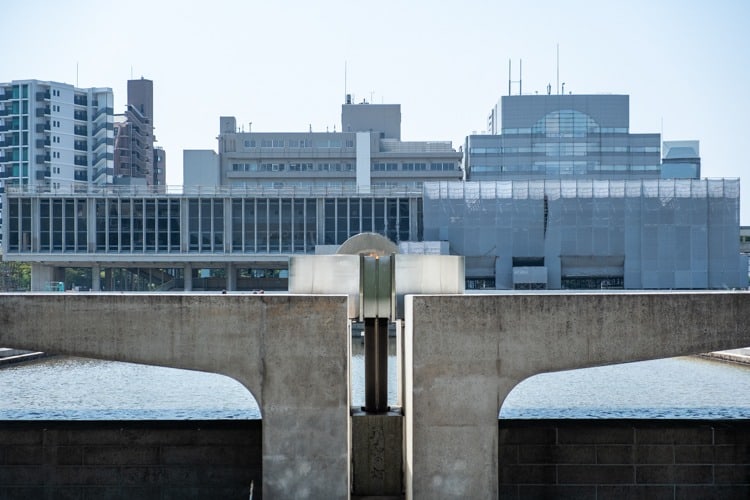
4. Cenotaph for the A-Bomb Victims
The next stop in your Hiroshima 1 day itinerary should be a stop at the Cenotaph for the A-Bomb Victims.
The stone tomb underneath the arch holds the names of all the victims of bombs. If you look through the gap underneath the arch of the Cenotaph, you can see the A-Bomb Dome.
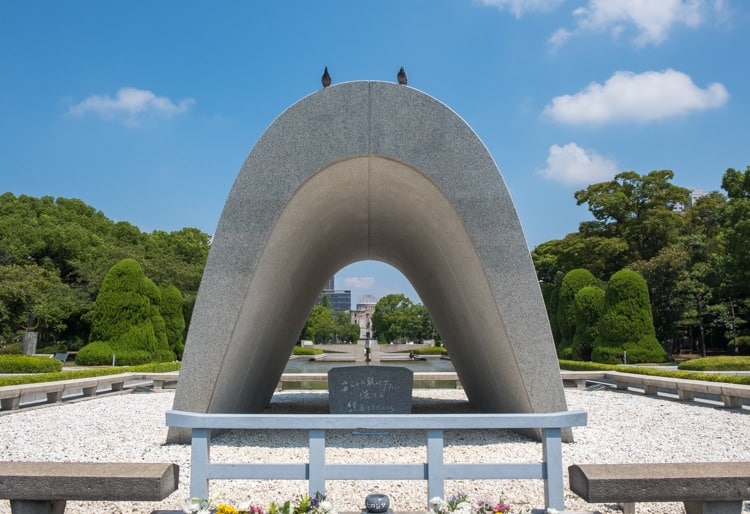
The arch is shaped like a haniwa , which was used on tombs in prehistoric Japan.
5. Hiroshima National Peace Memorial Hall for the Atomic Bomb Victims
(COST: Free; OPEN: 8:30 am – 6:00 pm; Aug – 8:30 – 7:00 pm)
A short distance from the Cenotaph is an underground hall called the National Peace Memorial Hall for the Atomic Bomb Victims. There is a panoramic view of Hiroshima inside.
(COST: ¥200 (US$1.85 / €1.60 / £1.45) for adults; ¥100 for high school students; junior high and younger: free; OPEN: Mar-July 8:30-18:00; Aug: 8:30-19:00; Sep-Nov: 8:30-18:00; Dec-Feb: 8:30-17:00)
The most important stop on your Hiroshima itinerary will probably be the Hiroshima Peace Museum.
The museum is part of a very large 3-building structure. The museum is usually located in the Main building and the East building. However, when I was there, the Main building was under renovation, so everything had been moved to the East building. The west side is the International Conference Center, Hiroshima, which you can ignore.
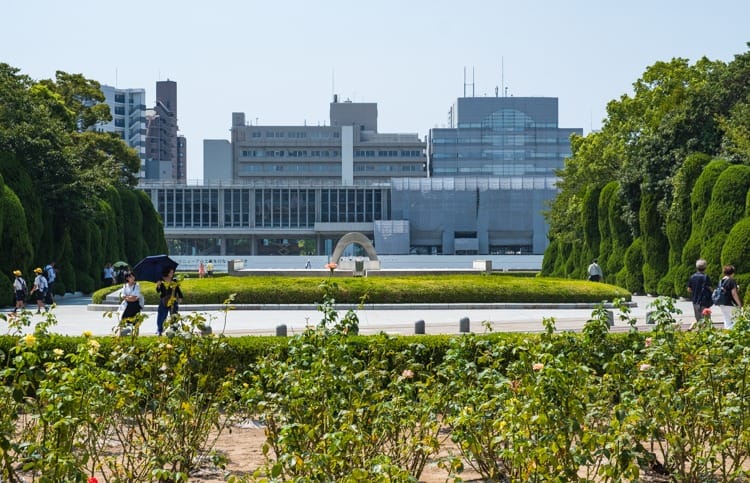
An audio guide in English costs ¥200 (US$1.85 / €1.60 / £1.45), but you’ll find that what is on the audio is the same as what is written on the exhibits.
There are coin lockers to store your bags.
The permanent exhibits begin on the 3 rd floor. Make sure to follow the numbers on the map so that you don’t miss anything good. I missed the individual video booths.
Exhibit #1: A Lost Way of Life, 3rd Floor
Not to be missed is an amazing video display of Hiroshima before and after the bomb.
I found seeing the instant obliteration of Hiroshima to be fascinating and moving. Nuclear bombs make war too easy and with too little consequences for the aggressor.
Exhibit #2: A-bomb Survivors Video Testimony (Third Floor)
After the video display, you can head to the A-bomb Survivor Video Testimony. There is a large room with seating to watch interviews of survivors of Hiroshima. These interviews are quite moving.
There are also individual video booths, but I, unfortunately, overlooked them.
Japan has a special word to describe those who survived the Hiroshima and Nagasaki bombs: hibakushas , which is translated as “explosion-affected person.”
Hibakushas did not receive any aid from the government until 1954 when the Japanese people became outraged that 23 crew members of a Japanese fishing boat had become poisoned with radiation from a nuclear weapons test by the United States at Bikini Atoll. As a result of this anger toward the U.S., the government finally passed a law giving Hibakushas free medical treatment and a monthly allowance. In 1975, a law was passed to increase the allowance.
Hibakushas were often discriminated against. They sometimes had trouble finding work because employers thought they would miss work too often from illnesses due to the bomb.
Although the primary symptoms of radiation poisoning like vomiting, diarrhea, and hemorrhaging of blood vessels would wear off after a while, many did have health problems their whole lives. They suffered from “weakness, weariness, dizziness, digestive problems, and feelings of oppression and doom.”
Exhibit #3: The Dangers of Nuclear Weapons (Third Floor)
In this part of the museum, there are exhibits along a wall telling the history of the development and dropping of the atomic bomb on Hiroshima.
There is also a really cool interactive media table in the center of the room. I couldn’t tell if all of the monitors showed the same thing or were different.
Exhibit #4: Hiroshima History (Second Floor)
On the second floor is another exhibit on the history of Hiroshima during and after the war.
Exhibit #5: Outline of Atomic Bomb Damage (First Floor)
This is a fascinating exhibit with clothing and items from people who had died and oral histories from people who survived in the beginning.
I’ll be honest with you that although I was deeply moved to tears during the video testimonies, by the end of my visit I was annoyed for a number of reasons.
First of all, the museum got some of their facts wrong and second, they presented the bomb without the context of the whole war.
What did the museum get wrong? I had planned to tell you what they got wrong in this section, but as I did more research and learned more about the bomb and the war, my explanation grew and grew and became too long to properly fit in this space. I’ve included my explanation and my conclusion about whether the bomb was necessary in the conclusion of this post.
Check Out These Hidden Gems:
- Takayama Itinerary: How to Spend 2 Days in Japan's "Little Kyoto"
- Travel Guide to Shirakawago: Enter a Japanese Fairy Tale
- Day Trip to Nara: A Suggested Itinerary
1:00 – Have Lunch
Once you leave the museum, you can head to the bus stop on the other side of the museum to stop #7, Peace Memorial Park, and catch the bus back to the train station. The Lemon Route is the fastest.
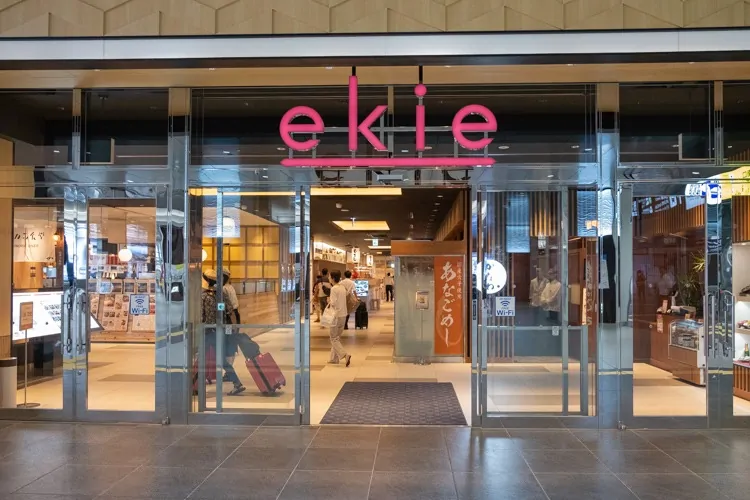
I went to this food arcade place at the train station called Ekie . There are several nice restaurants at the train station serving a variety of different foods. I chose one that served okonomiyaki. You can sit at a bar around the griddle watching the chefs cook the okonomiyaki. It’s kind of cool and fun!
I’m sure there are better and more famous restaurants in Hiroshima, but the restaurants at the train station are super convenient. If you’re going to really do this Hiroshima and Miyajima itinerary in a day, time is gonna be precious.
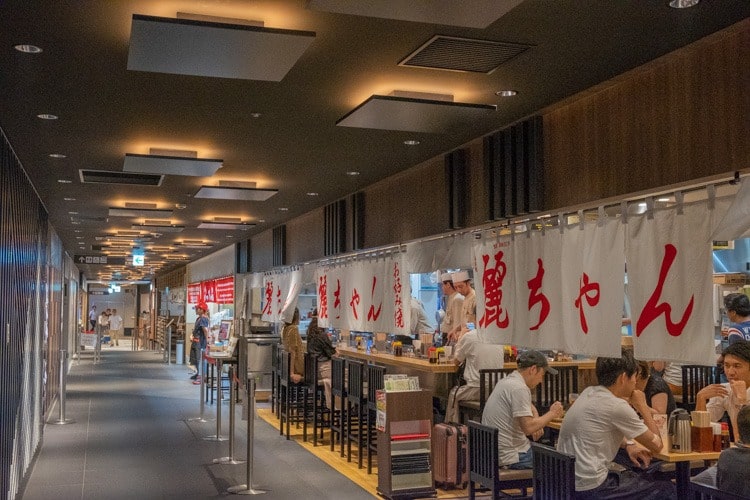
Hiroshima is famous for its okonomiyaki, which consists of layers of batter, noodles, cabbage, vegetables, and seafood or meat. Make sure to try them with oysters as Hiroshima is also famous for them. You can also get the okonomiyaki with cheese. I didn’t try the cheese one, but a traveler I met along the way who I had dinner with had it and said it was delicious.
2:00 pm – Take the Train and Ferry to Miyajima
Miyajima is a small island located so close to Hiroshima that you can easily make a day trip out of your Hiroshima 1 day itinerary. Miyajima is famous for the iconic torii gate floating in the water.
How to Get to Miyajima
Getting to Miyajima is easy as pie. In fact, there are 3 different ways to get there:
1. JR Train + JR Ferry
2. World Heritage Sea Route Ferry from Hiroshima Peace Park
3. Streetcar + JR Ferry
I’ll explain each of the ways below:
The train and ferry are free with your JR Pass.
Without a JR Pass, the total cost would be ¥600 (US$5.50 /€4.80 /£4.30) one way.
This method involves a 30-minute train ride, a 5-minute walk, and a 10-minute ferry ride. It doesn’t include wait times. All times are approximate.
Here are the steps in more detail:
STEP 1: JR Train
Take a local JR train (Sanyo Line) from Hiroshima station to Miyajimaguchi. It takes 30 minutes, and it’s free with your JR Pass .
If you don’t have a JR Pass, it costs ¥400 (US$3.67 / €3.21 / £2.88).
Below is the train schedule from August 2018. Stop by the Tourist Information Center at the train station for a more up-to-date schedule.
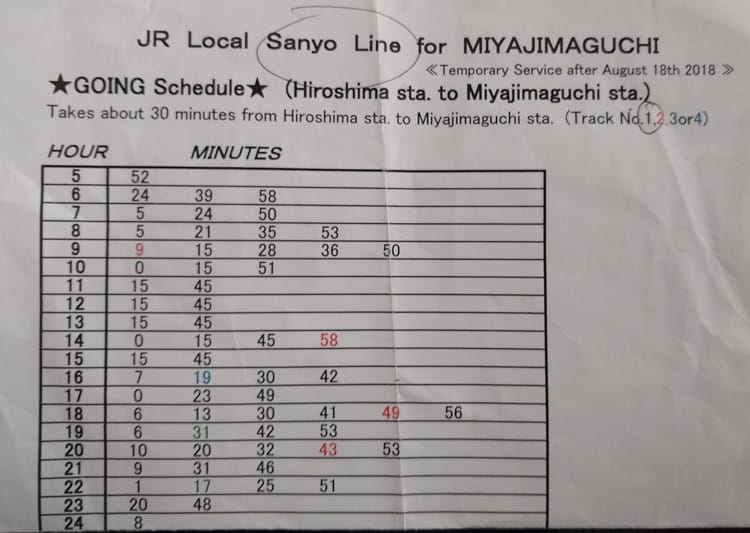
It’s a local commuter train so it’s going to stop at every single station along the way. Be patient and take a seat.
Just an FYI, some of the stations that the train stops at are not listed on the map that you get from the tourist center. While on the train, keep an eye out for the Miyajimaguchi sign on the station platform to tell you when to get off.
STEP 2: Walk
Walk about 2 blocks or 5 minutes to the ferry terminal.
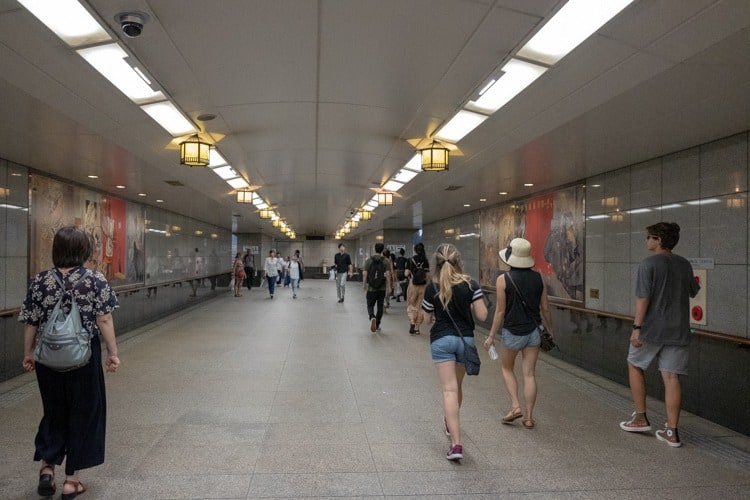
There are signs pointing the way to the terminal. You won’t get lost.
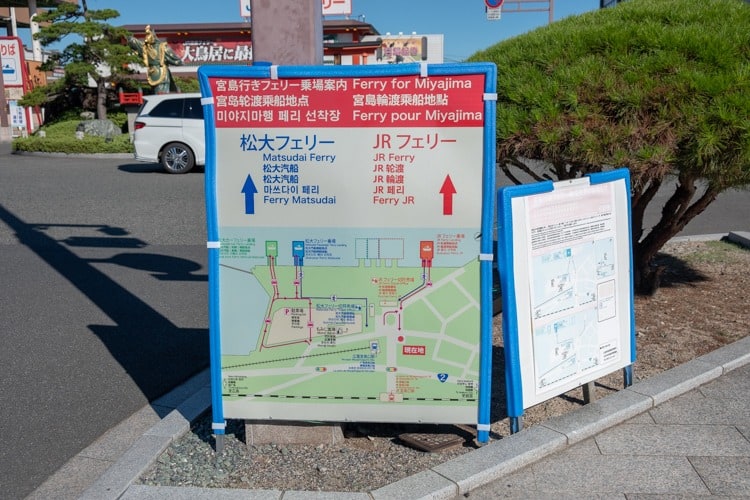
STEP 3: Ferry
Take the ferry to Miyajima island. There are two ferry companies that cover this route: Japan Rail and Matsudai. Only the ferry ride with Japan Rail is covered under your JR Pass. It takes 10 minutes. If you don’t have a JR Pass, it costs ¥180 (US$1.65 / €1.44 / £1.30) one way for adults and 90 one way for children. You can use your Plasmo or Suica to pay.
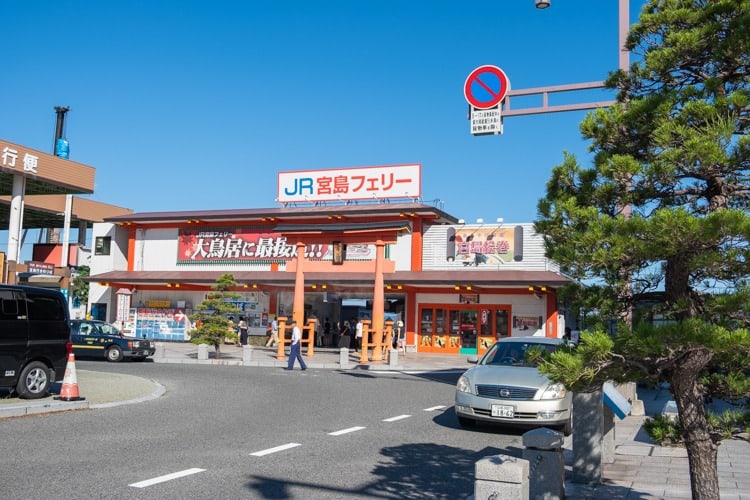
According to the ferry schedule as of December 30, 2018, ferries from Miyajimaguchi to Miyajima run from 6:25 am to 10:45 pm usually every 15 minutes. From Miyajima to Miyajimaguchi, they run from 5:45 am to 10:14 pm.
⇒ You can find the timetable for the JR Miyajima Ferry here .
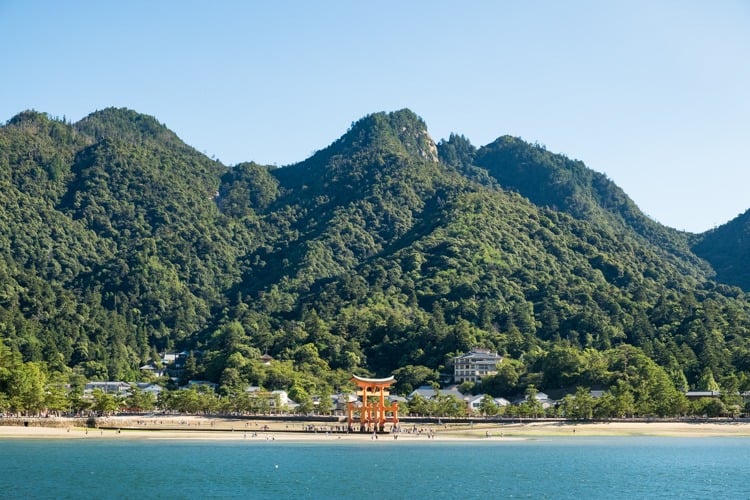
Don’t worry. You won’t get lost. Just follow the crowds and signs to the ferry.
2. World Heritage Sea Route Ferry from the Peace Park
There is also a direct ferry to Miyajima from Hiroshima Peace Park called the Hiroshima World Heritage Sea Route.
It costs ¥2,000 (US$18.37/€16/£14.42) one way and ¥3,600 (US$33 /€29/£26) round-trip.
It takes 45 minutes and leaves every 30 minutes.
⇒Click here for the website with timetable :
You can also take a streetcar (¥280/US$2.57/ €2.25/£2 one-way) to Miyajimaguchi. This is the most expensive.
From the Atomic Bomb Dome to Hiroden Miyajimaguchi, the streetcar takes around 55 minutes.
From the train station to Hiroden Miyajimaguchi, the streetcar takes around 75 minutes.
Then take the JR ferry from the Miyajimaguchi Pier, which is another 10 minutes.
When you get off the ferry, grab a free map from the tourist information center at the ferry terminal.
You’ve already seen the torii gate from the ferry, so it’s not rocket science that you need to turn right and walk along the water to get to it. It takes 12 minutes to get to the torii gate.
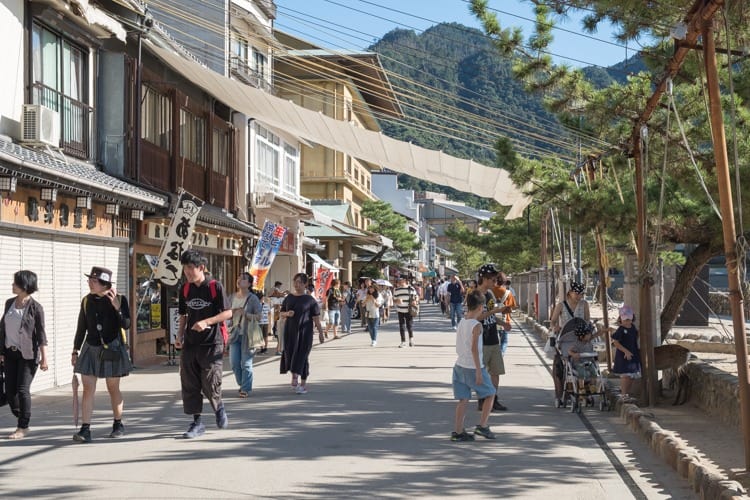
There are two roads that you can take to get to the torii gate. There is one footpath that goes right along the water. The other is along Omotesando street, one block from the footpath. Souvenir shops and restaurants line this street.
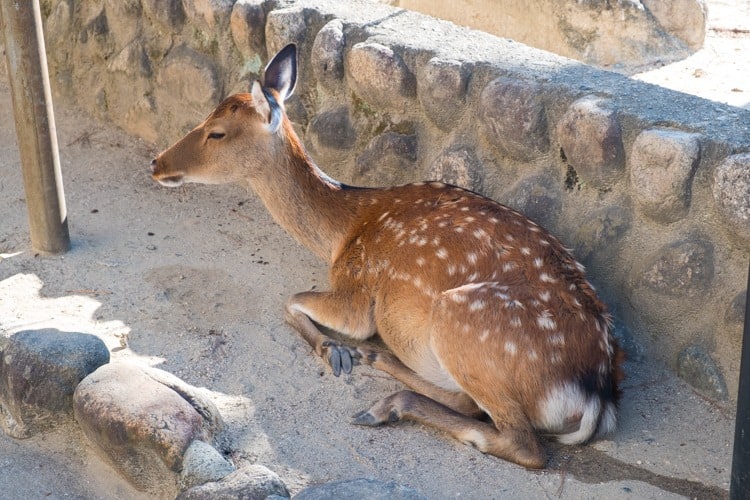
As you walk to the torii gate, you’ll notice lots of overly friendly and hungry deer just like in Nara. Just a warning: if you have some paper in your hand or pocket and it’s visible to the deer, they won’t ask before taking it to eat. While I was looking at a map, one deer came over to me and took it right out of my hand and started chewing on it.
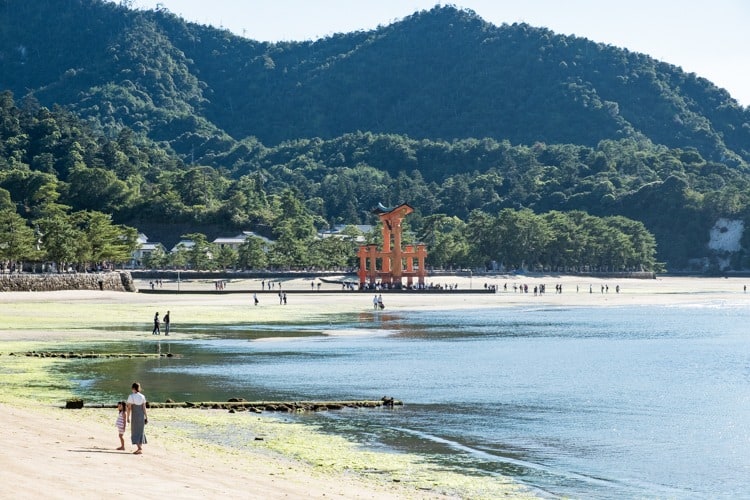
Unlike in Nara, there are signs asking people not to feed the deer as it has made the deer dependent on handouts from food, upsetting its natural eating habits. I agree.
Miyajima is also famous for oysters, so if you’re hungry and eat seafood, you can grab some from restaurants along the way to the torii gate.
Torii Gate of Itsukushima-jinja Shrine
The floating torii gate is a vermillion-colored gate that sits out in the ocean. It is actually the entrance to the Itsukushima Shrine.
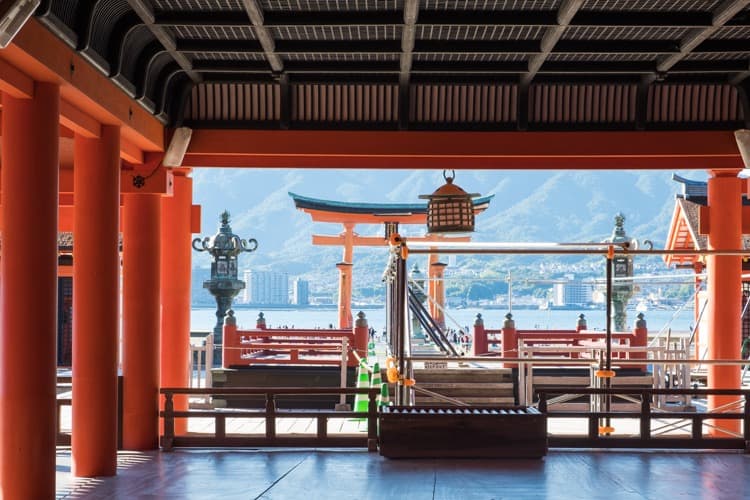
Why is it in the ocean?
According to Lonely Planet Japan, long ago people were not allowed to set foot on Miyajima, so if they wanted to enter the Itsukushima Shrine, they had to enter from the ocean; hence, the torii gate, which is how you enter all shrines, was built out into the sea.
Pay attention to whether the tide is low or high. If the tide is high, the sea will be surrounding the torii gate like above. If it’s low, it will be like the pictures below.
⇒ You can check out this website, Get Hiroshima, for all of the tide times for 2019 !
⇒ There’s another website that gives more information on tide times for Miyajima.

I went when the tide was low and well, you can see from my picture what it looked like when I was there.
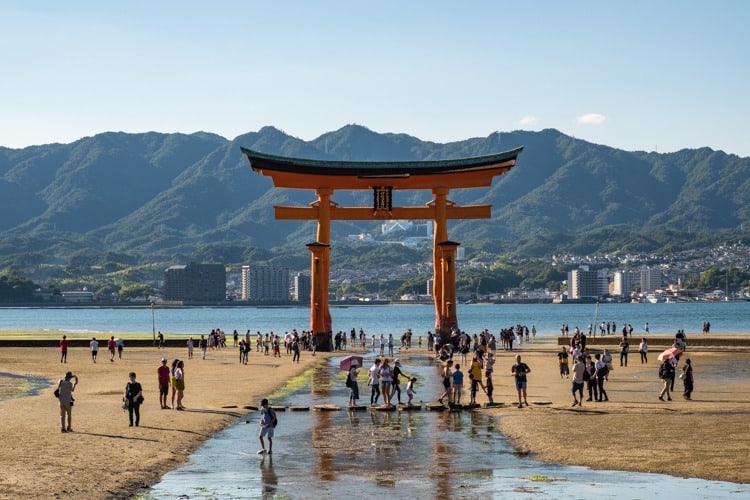
Lots of people told me how spectacular the view of this torii gate is, but I wasn’t all that impressed and I think it was because it was low tide.
If the tide is low, you can get to it from the beach and you don’t need to go through the shrine; thus, you avoid paying the entrance fee. The shrine is nothing special, and if you’ve seen lots of shrines already, you won’t be sad to miss this one.
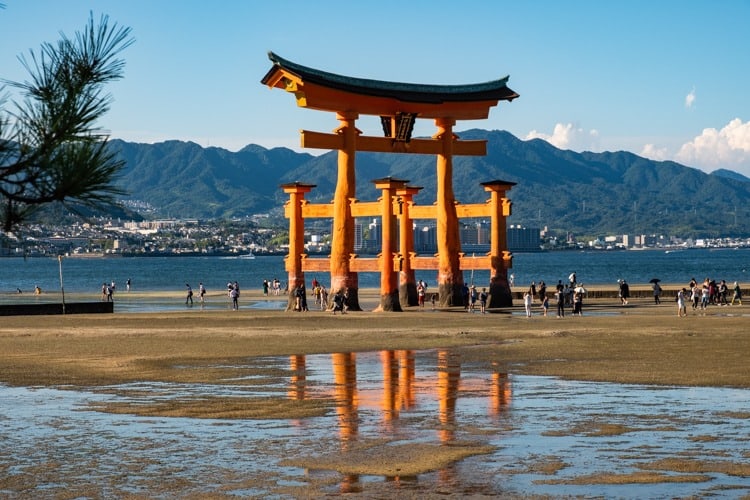
Night views of the torii are supposed to be spectacular. Of course, the sun sets at different times depending on the time of year, so if it sets before you need to leave to make the last train back to Kyoto or Osaka, you can stick around and take some awesome photos of the torii gate with the setting sun behind it.
Miyajima Light-up Night Cruise: You can also take a night cruise to Miyajima and see the torii gate all lit up. The cost is ¥1,600 (US$15/€13/£12) but I don’t know if that is one way or round trip. The first cruise leaves at 5:55 pm arriving at 6:25, and the last cruise leaves at 9:15 pm arriving at 9:45
⇒Click here for the website with a timetable
Looking for Travel Info on Tokyo?
- Where to Stay in Tokyo
- 4 Best Day Trips from Tokyo
- Tokyo Itinerary: How to Spend 4 Days in Tokyo
Getting Back to Kyoto or Osaka
What time you leave Miyajima depends on what time you want to get back to Kyoto or Osaka.
4:55 pm or 5:10 pm – Ferry from Miyajima to Miyajimaguchi
I would leave Miyajima at 4:55 or 5:10 pm in order to have dinner in Hiroshima.
⇒ Click here for the JR ferry schedule .
5:30 or 5:39 – Train from Miyamiguchi to Hiroshima
For those needing to leave Hiroshima at 7:22 pm, take the 5:30 pm or 5:39 pm train back to Hiroshima station. It should take 30 minutes. Here is the train schedule from 2018:
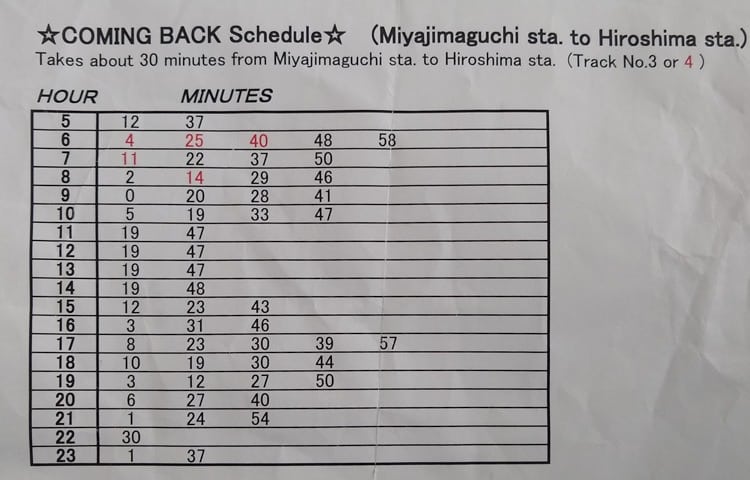
6:00 pm or 6:10 pm – Dinner in Hiroshima
You can easily have dinner again at Ekie or another place inside the train station. That’s what I did.
According to Inside Kyoto blog, when locals eat around the station area, they go to one of the many restaurants inside the station. Although there are English menus, there’s often no English name outside of these restaurants, so my advice is to just choose one with lots of Japanese people inside. If anyone would know what’s good, they would know.
7:00ish pm (or later) – Take a train back to Kyot o or Osaka
As a solo traveler, I’d take the 7:22 pm train getting into Kyoto at 9:20 pm. Then I could catch the bus back to my hotel.
If I were traveling with someone else, I’d perhaps stay late later and see the torii gate at night or the Atomic-Bomb Dome at night.
In Kyoto buses usually stop running at 11:00 pm and the subway at 11:30 pm.
Here was the train schedule from Hiroshima to Kyoto on January 17, 2019 :
- 7:17 pm –8:54 pm – direct – Nozomi line (no JR pass)
- 7:22 pm – 9: 20 pm – indirect through Osaka – Sakura line (JR pass)
- 8:01 pm – 10:36 pm – direct – Nozomi line (no JR pass)
- 8:52 pm – 11:09 pm – indirect through Osaka – Sakura line (JR pass)
- 9:03 pm – 10:45 pm – direct – Nozomi line (no JR pass)
- 9:58 pm – 12:09 am – indirect through Osaka – Hiraki line (JR Pass)
⇒ Check Hyperdia for train times for your date of travel.
Where to find more information
- Hiroshima Official Tourism Website
- Miyajima Official Tourism Website
- Train schedules – Hyperdia
- Restaurants at Hiroshima Train Station
- JR West Miyajima Ferry
- Hiroshima Peace Memorial Museum
- Embracing Defeat , by John Dower
- Hiroshima , by John Hershey
- Downfall , by Richard Frank
Final Thoughts: Hiroshima & Miyajima Itinerary
I came to Hiroshima with a burning question: was it necessary to drop a nuclear bomb on Nagasaki and Hiroshima? I had originally said, “no.” But I wanted to see what Hiroshima had to say. Seeing the Atomic Bomb Dome and hearing the survivors’ stories moved me deeply.
However, after touring all of the exhibits at the Peace Museum, I felt disappointed and a bit annoyed at the Hiroshima Peace Museum. Thus, I became less certain about my initial feelings that the bomb was wrong. But I didn’t know enough about the history of World War II in Asia to really answer this question.
Since that visit, I’ve read a number of books on the decision to bomb the two cities and the aftermath of the bomb. I’ve also read some books on what happened in Southeast Asia. The visit and my research have finally given me an answer to this burning question.
One of the things that bothered me in the museum was what they said about why the United States dropped the bomb. They mention only one reason: to prevent the Soviet Union from entering the war. In other words, the museum infers that the reason was purely political. No other reason was mentioned.
However, this is simply not true at all. The main reason why the United States dropped the atomic bomb was that the alternative would have been a land invasion, and this would have resulted in more lives being lost, a longer drawn-out war, and a more uncertain outcome.
Another reason is that Japan showed no intention of surrendering unconditionally any time soon even though at that point in the war, they were losing. Instead, they were trying to give themselves a better bargaining position when the time would come to negotiate for peace.
The United States had originally planned to invade Japan in November 1945. Through the codebreaking of Japanese communications, the U.S. found out that Japan was preparing to defend against the invasion with 900,000 soldiers and thousands of planes ready to conduct suicide attacks. It was estimated that total losses from trying to conquer Japan by land would have been 5 to 10 million Japanese deaths and 400,000 to 800,000 American deaths (Frank, page 340).
Not only that, it has been estimated that in 1945, 100,000 to over 250,000 Asian non-military people were dying each month from the Japanese occupation of their country. To carry the war into another year would have resulted in over a million more Chinese, Korean, and other Asian people dying.
This doesn’t even include the deaths of POWs who Japan notoriously mistreated (35% of POWs under the Japanese died while less than 1% of the POWs died under the Germans!)
Few people are aware of the experiments Japanese scientists were conducting in northeastern China, Burma, Thailand, and Singapore on the effects of biological weapons on thousands of men, women, children, and infants. Sadly, after the war, instead of charging these same scientists with war crimes, the U.S. hired them to continue testing biological weapons.
Another little known bit of history that many don’t know about is that the Soviet Union did invade Manchuria in the summer of 1945. According to Frank, the Soviet Union captured about 2.7 million Japanese, only one-third of whom were actual soldiers. Most were sent to labor camps in Russia. 347,000 to 376,000 of those captured died! And it took years (the 1950s and even into the 1990s) for those who did live to actually be allowed to return to Japan. There’s an interesting article from the New York Times about a Japanese man who was not allowed to return until 1998 . How insane is that!
I do want to add that it is debatable that the war would have even lasted long enough to reach those numbers since any large losses on the American part would have resulted in the American public turning against continuing the war and instead, demanding Truman sue for peace. The Japanese would not have needed to surrender unconditionally and would have likely been able to keep the same fascist military government in power with the same racist ideology.
Would ending the war without unconditional surrender have been fair to the 10 to 20 million Chinese who had died during the war?
Or the comfort women who were forced into becoming sex slaves for the Japanese military?
Or those who died from being given deadly diseases or operated on in Japanese scientific experiments?
Nuclear weapons are wrong and should never be used, ever, for any reason whatsoever. The nuclear weapons that exist now are much more powerful than the two used on Japan. We know what one less powerful bomb can do to a large city, which is something we didn’t know before. In fact, the United States had originally estimated that 20,000 people would die from the bomb. They were wrong. Between 100,000 and 200,000 people did actually die.
I commend the Hiroshima Peace Museum for promoting peace and for striving to eliminate all nuclear weapons. I think we need to be aware of the terrible and inhumane consequences of using nuclear weapons.
However, I think the Hiroshima Peace Museum is forgetting something even more important: we need to be aware and reminded of the terrible consequences of war in general and not just of atomic weapons. Atomic or nuclear weapons are just tools. Even if they are not used ever again, other tools or devices can be used with just as devastating of consequences.
If the Hiroshima Peace Museum was really a museum about “peace,” then they should look more closely at why wars start in the first place. The atomic bomb was bad, horrible, awful, but what the Japanese did to the people of Asia, POWs and its own people, what the Soviet Union did to Japanese POWs, and what the Americans did when firebombing Japanese cities were also just as awful if not more so.
If we cover up the past and fail to teach our children the truth, are we doomed to repeat history? Will we see another world war in our lifetime? 70 to 80 million people died as a result of World War II. That was 3% of the world’s population. Mechanisms like the United States, the EU, NATO, the WTO, and other international organizations were put in place after the war to prevent nations to solve problems through diplomacy rather than war. However, in the past two years, these organizations are slowly being weakened by certain countries and certain people.
Countries are notorious for blaming others for their problems. But when the leader of a country blames the loudest, then these feelings of victimhood become stronger, more widespread, and more vocal throughout the population. Germany and Japan went through this victimhood in the 1920s and 30s. Germany beget Hitler and Japan the military.
If you’ve got any questions about your own trip to Hiroshima and Miyajima, I’d be more than happy to answer them. If you’ve already been there and you have a comment, correction, or question, please leave in the comment section below! And if you’ve found this article useful, please share on social media! Thank you!
Best Resources for Your Trip to Japan
Book your flights for japan.
Use Skyscanner to find the cheapest flights to Japan. They will turn up results for all airlines including major ones and local airlines. You’re going to find EVERYTHING that’s available and thus get the cheapest price.
Book Your Accommodations for Japan:
The best hotel booking sites for Japan are Booking.com and Agoda . They have the biggest selection, and they consistently churn out hotels and hostels at the lowest prices of any other booking site. Another website for backpackers and budget travelers is Hostel World .
Book Your Tours for Japan:
The three best tour booking sites for Japan are Viator , Get Your Guide , and Klook . Viator has the biggest selection. Get Your Guide has terrific customer service. Klook specializes in tours in Asia.
Get Connected when in Japan:
You’ve got 3 options for staying connected in Japan: a pocket WiFi (what I used), a physical SIM card , or an eSIM . Several companies offer eSIMs for Japan. I recommend getting one through Klook or Airalo .
Book your Japan Rail Passes:
Japan has many different types of passes. The JR Pass is one of the most popular passes. Buy them through Klook before your trip to Japan. There are other passes as well like the Hakone Freepass .
Get Your Rail Pass for Tokyo
Get an unlimited train pass for most metro lines in Tokyo. They’re good for 1, 2, or 3 days. I always get the 3-day pass.
Are you on Pinterest?
Hey! How about saving one of these pins to Pinterest to read for later?
And feel free to follow me on Pinterest, where you'll find lots of travel articles for everywhere around the world.

Looking for more on Japan? Check out these posts:
- Japan Itinerary: The Perfect 3 Weeks in Japan
- Tokyo Itinerary: How to Spend 4 Perfect Days in Tokyo
- Hakone Itinerary: How to Spend 2 Days in Hakone
- Kyoto Itinerary 4 Weeks: A City of a Million Temples
- Nara Itinerary: The Perfect Day Trip from Kyoto
- Matsumoto Itinerary: Exploring Japan's Coolest Castle
- Shirakawago Itinerary: Enter a Japanese Fairytale
- Kamikochi Hiking: The Perfect Day Trip from Takayama
- Takayama Itinerary: Travel Back in Time to Old Japan
- The Best Ever Guide to Japan's Tateyama Kurobe Alpine Route
- Top 10 Must-See Places to Visit in Kyoto
- 13 Things You Need to Know Before Going to Japan
- The 20 Best Novels to Read Before Visiting Japan
Hi, Thank you for this informative blog 🙂 I was thinking would it be possible to do this itinerary. We are coming from Osaka and plan to take the first train in the morning going to Hiroshima, then go to Miyajima first?
Osaka -> Miyajima -> Hiroshima -> Osaka (1 day tour? is it enough?)
Also I got confused on how to get to Miyajima, there are 3 ways but which would be the fastest way? 🙂 Thank You
Thank you! I’m glad that you found it informative!
Doing Miyajima first and Hiroshima second would definitely work.
The JR train + JR ferry would get you there fastest because when you arrive in the morning by train from Osaka, you can just hop on another JR train to Miyajima (30 minutes). Then walk to the ferry terminal (5 minutes) and get on a JR ferry to Miyajima (10 minutes). The train leaves pretty frequently.
The second fastest way would be the World Heritage Ferry that leaves from the Peace Park. That would mean taking a streetcar from the train station to the Atomic Bomb Dome (20 minutes) – walking to the ferry (perhaps 5-10 minutes) – taking the World Heritage ferry to Miyajima (45 minutes). The World Heritage Ferry leaves every 30 minutes.
I made changes to the post to make it clearer.
I wanted to commend you for final thoughts on this article. When you posed your initial questions, I thought of how quickly tourists tend to demonize one side over another when they visit monuments/museums like these.
I was not expecting you to research the Japanese involvement prior to and during WWII but I’m glad you did! I agree whole-heartedly with your views on nuclear weapons and hope more people understand holistically the true costs of war. The war crimes committed by the Japanese truly devastated the people of China and S.E. Asia (like Singapore) and remain a significant part of their history. This is often overlooked, in my opinion, in Western understandings of the Asia-Pacific theater but is important to understand as it shapes the cultural and political stances of these countries today.
Thank you, Becca! Most people from Europe, North America, and Australia who visit the Peace Museum know next to nothing on what the Japanese did during the war. What they learn, they get from the Peace Museum, which is very one-sided. The museum talks only about the bomb and they’re not completely truthful when they do talk about it. I wish more people in the West knew about how the Japanese treated the Chinese, Koreans, and the people of SE Asia.
Submit a Comment Cancel reply
Your email address will not be published. Required fields are marked *
Submit Comment
This site uses Akismet to reduce spam. Learn how your comment data is processed .

Grab a FREE Japan Itinerary Guide
Get all my great travel tips as well as this FREE Japan travel and itinerary guide sent to your email right away!
You have Successfully Subscribed!
What are you looking for, about the bamboo traveler.

Welcome to The Bamboo Traveler, a travel blog dedicated to helping those travelers who want to dig deeply into the history, heritage, and culture of a place. Whether it’s through the pages of your passport or the pages of a book, I’ll help you travel the world and uncover the history, culture, food, architecture, and natural beauty of some of the world’s most fascinating places.
Follow the Bamboo Traveler

Traveling to Japan soon?
Posts about japan.
- Japan Itinerary : The Perfect 3 Weeks in Japan
- Tokyo Itinerary : How to Spend 4 Perfect Days in Tokyo
- Kanazawa Itinerary: 2 Days in the Cit of Samurais
- Kyoto Itinerary 4 Weeks : A City of a Million Temples
- Nara Itinerary : The Perfect Day Trip from Kyoto
- Kamikochi Hiking : The Perfect Day Trip from Takayama
- Takayama Itinerary : Travel Back in Time to Old Japan
- Top 10 Must-See Sites in Kyoto
- Traveling Solo in Japan: The Good, the Bad, and the Ugly
Table of Contents
- 5:00 pm – Leave MIyajima

Get Your FREE Japan Itinerary Guide Here!
Subscribe to my newsletter to receive the latest travel tips for Asia and get a free 4-page PDF version of my 3-Week Japan Itinerary.
Pin It on Pinterest

There's still more! How to enjoy Miyajima

- # Recommendation
- # History/ Culture
- # World Heritages
- # Learning/ Experiencing
A trip to enjoy Miyajima more !

Miyajima is full of plans to feel the traditions and nature of Setouchi! We will introduce experience plans to thoroughly enjoy Miyajima and inns around Miyajima.
Heian costume/kimono experience

Stroll around the ancient Yukashiki Island wearing Heian costumes
Why don't you take a walk around Miyajima wearing the Heian period outing style “tsubo costume” (excluding inside Itsukushima Shrine)? The colorful Heian costumes will make you feel good too! Enjoy a photogenic experience!
Momiji manju hand-baked experience

Try making momiji manju!
At the Miyajima Traditional Crafts Center (Miyajiman Workshop), you can experience hand-baking momiji manju. Let's try the freshly made taste ! The taste of momiji manju baked by yourself is more than delicious.
Experience traditional Japanese culture at Daisho-in

A prestigious temple with the deepest history in the temple in Miyajima
Why don't you experience zazen and copying sutras at Daishoin, the oldest temple in Miyajima? You can also experience shinobue (bamboo flute), a Japanese classical musical instrument that is said to have been originally used to call gods, and Japanese traditional play, and throwing fans. (Please use online reservations.) Enjoy a moment to immerse yourself in Japanese traditional culture.
Miyahama Onsen, the closest hot spring resort to Miyajima

Let's heal the tiredness of the trip with a superb view open-air bath
About 12 minutes by car from Miyajimaguchi, Miyahama Grand Hotel in Miyahama Onsen is the closest hot spring resort to Miyajima. It has an open-air bath overlooking the Seto Inland Sea ! Please enjoy the luxurious view as if it were integrated with the sea. You can also enjoy a day trip bath.
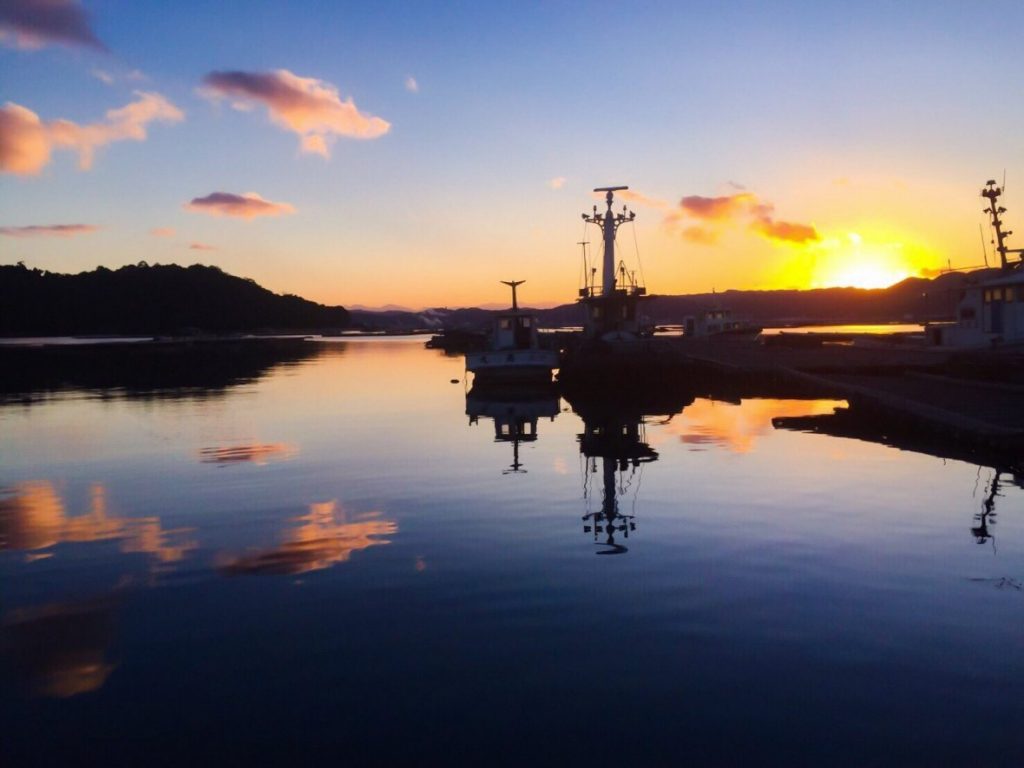
【Featured Column】 Miyajima Seascape Walk Mori Maru
The Miyajima Night Cruise, where you can see the light up of Miyajima's Otorii gates on the houseboat “Mori Maru,” and “Miyajima Morning Cruise,” which departs from the Miyahama Grand Hotel. With a sightseeing guide, you can enjoy plenty of scenery that can only be seen from the sea, centering on Miyajima. It is common to use a round-trip ferry to get to Miyajima, but we also recommend staying at Miyahama Onsen and heading to Miyajima using the “Miyajima Morning Cruise” the next morning.
Oyster landing tour and Itsukushima Shrine offshore tour

The landings you can see up close are impressive!
You can board a fishing boat with a fisherman and observe the landings of oysters up close. After observing the landing, visit Itsukushima Shrine by sea. Why don't you enjoy an experience unique to Hiroshima?
Related articles

“EDION PEACE WING HIROSHIMA” A new soccer stadium in downtown has opened!

Let's go on a pilgrimage to real-life “Slam Dank” locations in Hiroshima!

[G7 Hiroshima Summit] Special feature on local sake treated by prime ministers

[G7 Hiroshima Summit] Special Feature on Hiroshima's Traditional Culture Used the Partners Program
Share this article
Travel bookmarks.
All spots / experiences
This website stores cookies on your computer. nThis cookie is used by this site and other media to improve the website experience and to provide more personalized services. n For more information about our cookies, please see our Privacy Policy . This site does not track the personal information of visitors.
Miyajima Sanpai-yuran Cruise
Spot details.

Information Sources: NAVITIME JAPAN
Nearest spot
Related information.
インバウンド旅行者向け広告掲載について
- NEARBY ACTIVITY -
![night cruise miyajima [Hiroshima/Miyajima] First time SUP half-day plan (from Miyajima Island)](https://img.activityjapan.com/10/18552/10000001855201_141jb6Jo_4.jpg?version=1634221204)
Share this spot

Copy to clipboard completed.
プライバシーポリシー ・ 利用規約 に同意の上、ボタンを押してください。
ログイン(無料)すると より便利に利用できます
Change password
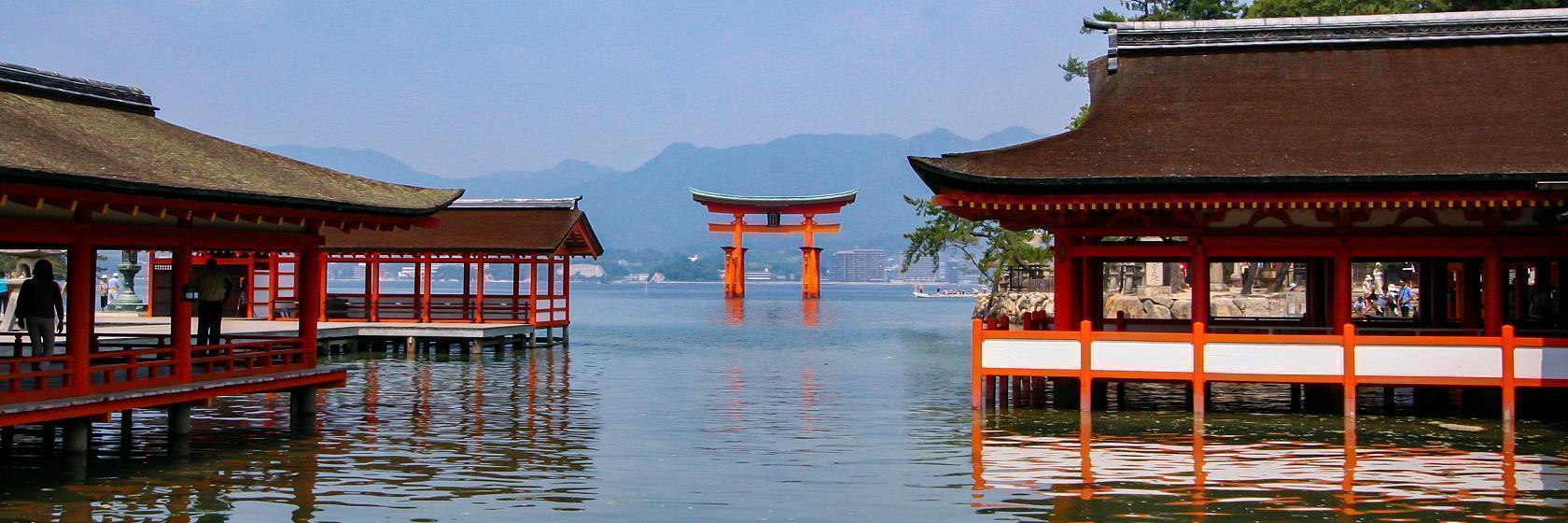
Miyajima (�{��) is a small island less than an hour outside the city of Hiroshima . It is most famous for its giant torii gate , which at high tide seems to float on the water. The sight is ranked as one of Japan's three best views .
While officially named Itsukushima, the island is more commonly referred to as Miyajima, Japanese for "shrine island". This is because the island is so closely related to its key shrine, Itsukushima Shrine . Like the torii gate, the shrine's main buildings are built over water.
Miyajima is a romantic place, best enjoyed by staying overnight at one of the island's ryokan . While there are usually many daytime tourists, in the evening the area becomes much quieter and more peaceful. There are also wild deer on the island that have become accustomed to people. In the day the deer wander around the same sites as the tourists, and in the evening they sleep along the walking paths . Unlike in Nara , the deer on Miyajima must not be fed.
Top attractions in Miyajima
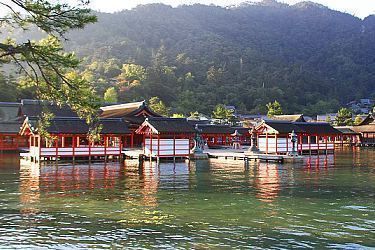
Itsukushima Shrine •••
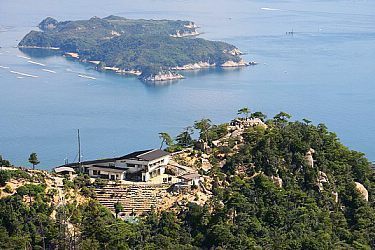
Mount Misen •
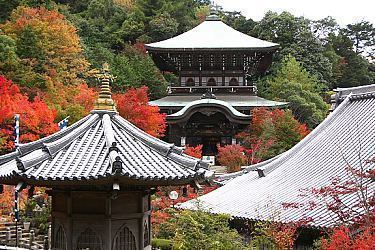
Daisho-in Temple •
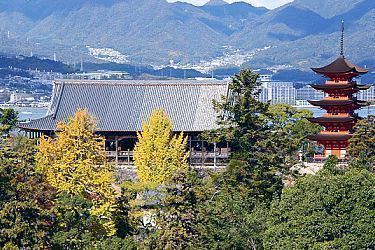
Senjokaku •
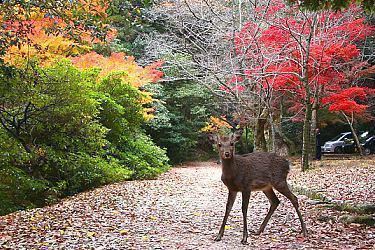
Walking Trails
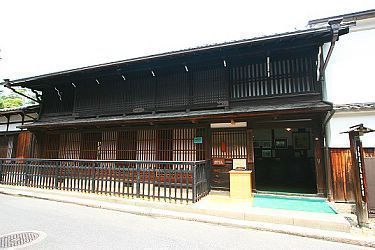
Museum of History
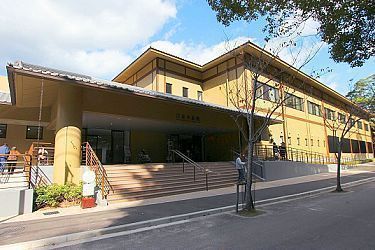
Miyajima Aquarium
Getting there and around, itinerary ideas.
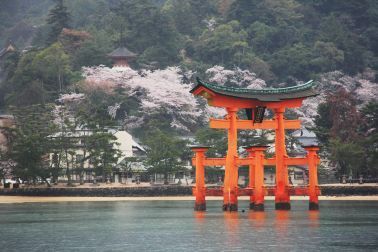
- Historic Itsukushima Shrine
- Ocean views from Mount Misen
- Peaceful Momijidani Park
Questions? Ask in our forum .
Links and Resources
Hatsukaichi city, hotels around miyajima.

Experiences around Miyajima
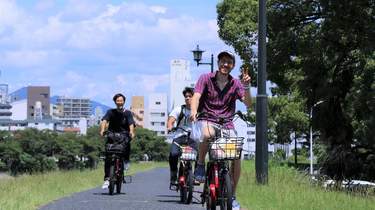

Japan Travel Tips & Hidden Gems
Overnighting on Miyajima | How to Best Experience the Island
- December 1, 2017
- Area Guides

The island of Miyajima is one of the most popular attractions in all of Japan. Located to the west of Hiroshima city, the island welcomes boatloads of tourists every day (and even its own Starbucks as of 2017). The island was listed as a UNESCO World Heritage Site in 1996 and its iconic “floating” torii is one of the most picturesque views of Japan. In fact, Miyajima is so striking that it has been often ranked as one of the three best views in all of Japan. Hell, even those who haven’t even been to Japan are able to identify the sacred island from time to time!
While Miyajima is firmly located “on the beaten path,” few foreign tourists are aware of a little-known secret about the island. You see, Miyajima is actually home many traditional Japanese ryokan and these make for the perfect overnight experience. The area takes on a relaxed and almost otherworldly vibe after the sun goes down and the tour groups depart. Furthermore, Miyajima is home to so many awesome adventures and venues that it just isn’t possible to do it all without the early start that a stay allows.
Before we continue, you should know that Miyajima is actually the island’s nickname. The official name of the island is Itsukushima. The colloquial title came about due to the island being so closely related to its star attraction, Itsukushima Shrine. Over time, people just started calling it Miyajima which literally translates to “Shrine Island.” This might seem a little confusing at first but the two names are used interchangeably. For simplicity sake, I’ll be sticking with the vernacular nomenclature throughout this piece.
Oh and one last thing! Hold on for the ride; this is going to be another very long piece. I recommend that you grab a cup of joe and set aside some time before beginning. In this article I’ll be covering an entire two day itinerary in great detail. That said, those who read all the way through will know how to avoid the crowds and get the most out of their experience on Miyajima.
How to Get There

Miyajima is located less than an hour outside of Hiroshima city. For the majority of tourists, this means that a visit will need to fit into an itinerary that takes this into consideration. Hiroshima is home to the infamous Peace Memorial Park and it would be a real shame to miss the memorial due to poor planning. Do your homework here and budget enough time. If you’re interested in the full Miyajima itinerary that I’ll be proposing today, know that you’re going to need a full one-and-a-half days to cover all the bases.
While it is possible to fly, the easiest option is always the bullet train. If you’re coming from Tokyo, you can make it all the way down to Hiroshima in just under four hours. Alternatively, those starting in either Kyoto or Osaka can cut this travel time in half. Like always, refer to Jorudan or a similar service to figure out the best trains for you. I’d suggest that you add Hiroshima either before or after a visit to Kyoto and/or Osaka as this will allow you to halve the travel time.
Once you’re in Hiroshima, there are several options for getting to Miyajima. While there are direct boats from the city, the easiest way is to just hop on the JR Sanyo Line bound for Iwakuni. Once you arrive at Miyajimaguchi Station, simply get off and walk a few minutes to the harbor. Here you’ll find two competing companies offering ferries out to Miyajima. It doesn’t matter which you choose so just opt for whichever has the next departure. The ferries cost 180 yen and reach the island in just about 10 minutes.
Accommodation on Miyajima

I’ll be frank; there’s a hell of a lot of things to do on Miyajima. Unfortunately though, there’s equally as many tour groups congesting the island. Luckily though, after much personal experience, I’ve managed to come up with an itinerary that will help you avoid the worst of the madness. Since you’ll be overnighting on Miyajima, you’ll have the privilege of visiting many of the best locations well before the hordes arrive.
When it comes to accommodations, Miyajima has a wide variety of options to choose from. The island can cater to all budgets and has lodging ranging from hostels with bunk beds to luxury ryokan. Wikitravel has done a great job of sourcing most of the listings on the island so rather than reinvent the wheel, I’ll direct you instead to their page.
A Safety Disclaimer for Wildlife

Before diving into the details of my proposed itinerary, I want to take a second for a quick warning. Honestly, this shouldn’t even need to be said but alas I’ve seen my fair share of moronic tourists over the years. Anyway, much like Nara, tame deer amble about Miyajima. While the deer are somewhat more restrained than their Nara counterparts, they’re still just as eager for treats. Expect to have these critters rummaging around in bags, purses or backpacks for food.
As you might imagine, visibly holding food is a sure fire way to make a friend for life. These deer are persistent and will stalk you until the end of time if given the opportunity. Also, don’t expect that woofing down your edibles will make them go away either! They are just as happy to chew on your shirttails or pamphlets protruding from your pockets. Heck, I even had one deer friend (get it?) gently chomp away on my finger for a few seconds!
Indeed, the deer on Miyajima are adorably cute (and sometimes adorably stupid) but they are WILD ANIMALS after all. While these buggers are familiar with humans, they are not domesticated like your neighbor’s dog. Be sure to keep this in mind and respect their space. Most of the male deer who wander around the populated areas of Miyajima have had their antlers removed. Nevertheless, there are still a few spirited deer sporting a full rack, especially around Mt. Misen (more on this next).
Day One: Mt. Misen

Since we’re going to be overnighting on Miyajima, I’ve curated the following two day itinerary that will allow you to skip the majority of the tour groups. While you won’t have some of the more popular spots ALL to yourself, they should be largely devoid of the hordes. As always, you’re free to skip at leisure but I’d suggest that you maintain the order proposed as I’ve created it with walking distances in mind.
Make a point to arrive on Miyajima no later than 12:30 or 1:00 PM. Getting there any later will leave you rushed and pressed for time. Like many destinations outside of major metropolitan areas, the shops and attractions start closing up around 5:30 PM. If you’re traveling from Tokyo you will need to hop on a 7:00 AM bullet train bound for Hakata in order to arrive early in the day. Spend the time to do your research here!
First-up, you’re going to want to make a beeline past all of Miyajima’s attractions and head straight for Mt. Misen. This mountain is the most sacred site on the island and is home to an amazing collection of ancient Buddhist sites. If the vague historical records are to be believed, Buddhism was first practiced here by the legendary engineer-monk Kukai in 806. Since then, it has been patronized by some of Japanese history’s most prominent figures.
Gluttons for punishment will rejoice to know that you can actually hike to the summit of Mt. Misen via any one of three routes to the top. In the interest of time however I recommend that you take the ropeway instead. Even with the help of modern transportation, there will still be a twenty to thirty minute climb waiting for you once you reach the top. Be wise and save your energy for that portion of the trail which the ropeway does not cover.

The fee for the ropeway is priced rather steeply at 1,000 yen each way. But, you can save a few hundred yen by buying round trip tickets. You’ll find the the base station for the ropeway located in the middle of Miyajima’s Momiji Valley Park (here’s a link to a Google Map ). This area is home to thousands of Japanese maple trees and is a popular hangout for the island’s wild deer. As can be seen in the shot above though, the park truly comes alive in autumn when the trees change to vibrant hues of red and yellow.
Coming back to the ropeway though, know that the journey up is divided into two sections. You’ll start the ascent at the Momijidani Station and transfer halfway up at Kayatani Station. There isn’t really an opportunity to wander off at any point so this is all rather straightforward. Just kick back and enjoy the breathtaking scenery of Miyajima and the Seto Inland Sea . Especially during autumn, the spectacular view is to die for.

Not including wait times (which can get downright ugly on weekends), the journey up the mountainside takes a combined 15 minutes. The ropeway will leave you off at Shishi Iwa Station (picture above) which is 443 meters above sea level. Thereafter, you’ll need to resort to hoofing it for the remaining 150 meters to the summit. While the climb should be feasible for those of varying fitness levels, it is by no means easy. There are no vending machines at the top so be sure to grab a water at Shishi Iwa Station while you’re at it.
The upper areas of Mt. Misen are also home to seven wonders. Many of these are en route to the summit and are worth keeping an eye out for. These intriguing spots are as follows:
- The Eternal Flame This spiritual flame has been kept burning for more than 1200 years since Kukai originally lit it as part of his training. Today, you’ll find the flame located in Reika Hall which you’ll encounter about five minutes before reaching the summit. What’s more, this flame was actually used to light the “Flame of Peace” in Hiroshima’s Peace Memorial Park.
- Plum of the Crosier As the legend holds, the crosier that Kukai rested upon is said to have taken root and blossomed into a plum tree. Folklore tells the tree never blossoms when there are ominous happenings in the world.
- The-Ebb-and-Flow Rock This boulder has a tiny hole which fills with water when the tides flows in. Given it’s located 500 meters up on Mt. Misen, this is rather peculiar indeed.
- Mandara-iwa While no longer open to the public, this spot has the handwriting of Kukai engraved into the bedrock. Seeing as Kukai basically invented the modern Japanese system of writing, this is a majorly historical spot!
- Wooden Clappers Local folklore asserts that the occasional audible sounds of wooden clappers at night originates from a tengu . It is said that the long-nosed goblin prowls the mountain at night doling out curses to all.
- Moist Sakura Tree OK, this one baffles my mind. This cherry blossom tree remains seemingly wet to the touch all year round, even when there hasn’t been rain for weeks…

From the list above it’s obvious that there’s some supernatural phenomenon happening on Mt. Misen. Take your time exploring. In addition to the above list, there are also a number of smaller structures like the Misen Hondo that warrant a quick peek. Most of these officially belong to Daisho-in Temple which you’ll visit on day two. Be sure to keep an eye out for the adobe Jizo-san statues that adorn the landscape. Many of them are hilariously cute like the one pictured above.
Once you’ve had your fill of Mt. Misen’s spiritual happenings and attractions, continue on to the summit. Here, you’ll find a small modern pavilion with a 360 degree view of Miyajima and the Seto Inland Sea. It is said that on a clear day you can see as far as Shikoku , another one of Japan’s four major islands. I don’t want to spoil the breathtaking scenery by inserting an iPhone photo so you’ll just need to trust me here.
After taking in the magnificent view, prepare to head back down the mountain. While I’d encourage you to take your time at the observatory, you should know that the final ropeway leaves Shishiiwa Station at 5:00 PM. Given the fact that it can take up to an hour in line during busy seasons, you’ll want to allow for plenty of time. After all, I don’t imagine you want to hike all the way back down to the base of Mt. Misen. Well… on second thought, this might actually be a faster option when the mountain and ropeway are crowded!
Day One: The Isle at Night

After descending Mt. Misen, it will likely be time to check into your hotel or ryokan. Typically, check-ins are not allowed until after 2:00 or 3:00 PM. However, many lodgings will allow you to store your bags beforehand. After a quick stop over in your room, you’ll want to get ready to head back out. Many of the tourists will start departing the island around this time meaning you’ll be able to enjoy the island’s iconic torii in peace without the crowds.
Be sure to also check the tides too. If you’re lucky, you’ll be able to walk out to the torii just as the sun is beginning to set. It’s a surreal experience that I highly encourage you to try if the timing works out. Once the sun falls below the horizon, a series of powerful lights will turn on and illuminate both the torii gate and the nearby Itsukushima Shrine. While the above photo certainly isn’t my best work, the illuminations are really a spectacular sight to behold.
For those staying overnight on Miyajima, a common nighttime tradition is to don a yukata and stroll around the island. Itsukushima Shrine is unfortunately not open at night but just seeing it lit up is enough of a treat. These amazing illuminations are a major attraction but just be mindful of possible encounters with the local wildlife. The deer are out in numbers at night hunting for any leftover scraps of food.

In addition to the shrine, there’s another spot that I recommend you check out. While not well known to visitors, there are some amazing lanterns on the island all meant for marveling. You’ll find these on the Machiya street that runs parallel to the main Omotesando shopping street. If this seems confusing, just follow this Google Map . It will lead you to a ryokan called Ryoso Kawaguchi that has called the Machiya street home for over 100 years.
Things to do at night aside, let’s talk dinner and drinks. Many ryokan will provide dining options for patrons but you’ll also have the option of eating out on the island. Keep in mind that most island venues tend to close on the early side. In fact, only a few Izakaya are open until 11:00PM. Should you be on the lookout for more then you’re only alternative is a single bar that is open until 1:00 AM. You’ll find this establishment located about halfway down the main shopping street.

You should also know that Miyajima and the Seto Inland Sea are famous for their oysters. It’s one of the island’s meibutsu and you’d do well to sample a few. You’ll find shops and restaurants featuring raw, grilled, and fried oysters all over the island. Just pick your favorite; you can’t go wrong! I’ve had my fair share of shellfish over the year and I must say that nothing compares to the freshness of Miyajima’s oysters.
Other than the above, there is not a lot to do at night on Miyajima per say. While this “chill time” can be charming in and of itself, I also suggest you consider getting to bed early. If you’re keen on avoiding the crowd, you’re going to need to get up rather early. I’d recommend that you have an early dinner and then investigate the shared bath or onsen at your ryokan (if available). Next, hit the hay by 11:00 PM and prepare for another long day.
Day Two: Itsukushima Shrine

The sheer number of tour groups passing through Itsukushima Shrine can be downright oppressive. During the early hours of the morning though, chances are quite high that you’ll have the shrine all to yourself. Miyajima’s iconic shrine is open from 6:00 AM and the earlier you can get there, the less people you’ll need to worry about. I would suggest you get there no later than 8:00 AM as that’s about the time the first tour groups start arriving on the island.
There’s plenty of information available online about Itsukushima Shrine. In the spirit of keeping things as brief as possible, allow me to quickly present the “Cliffs Notes” version. The present structures date back to the 16th century and models an earlier 12th century design. Though the shrine’s origins date back even further, Itsukushima Shrine, as we know it, was created in 1168 by the warlord Taira-no-Kiyomori .
The most iconic and defining feature of Itsukushima Shrine is the fact that it is built out on the water. The shrine was constructed on pier-like structures over the bay so that it would stand separately from the island itself. Miyajima and its major shrine are dedicated to the three daughters of Susanoo-no-Mikoto , the god of seas and storms. Historically because of this connection, only the devote were allowed to set foot on Miyajima to maintain its purity.
Itsukushima Shrine and its easily recognizable torii gate were built such that they appear to float on the surface of the water. In bygone days, commoners would need to steer their boats through the colossal archway before approaching the shrine. Over the years, there has been an immense importance placed upon maintaining the purity of the shrine. Since 1878, no births or deaths have been permitted near the shrine. Even today, burials on the island are forbidden.

When exploring Itsukushima Shrine, one thing you should keep an eye out for is the Noh theater pictured above. This was added in 1590 as a means of entertaining the gods enshrined on Miyajima. Much like the rest of the shrine, it too has been fashioned to appear to float upon water when the tides come in. You’ll find the theater just before exiting the shrine. I can only imagine how magical it must have been to see a live performance here in days of yore.
Lastly, before moving on, know that Itsukushima Shrine also has a sizable treasure hall. This is located here on the left hand side of the shrine’s exit and it will run you an additional few hundred yen to enter. The treasure hall has some interesting artifacts on display making it worth the price of entry. But if you’re off to a late start, it’s not what I’d consider a “must see.”
Day Two : Daigan-ji

After exiting Itsukushima Shrine you’ll find the aforementioned treasure hall on the left side and a small Buddhist temple on your right. This facility is called Daigan-ji and dates back to 1201. History indicates that the temple was actually once responsible for the maintenance of Itsukushima Shrine prior to Meiji government’s imperial decree that separated Buddhism and Shinto. Daigan-ji is home to four Buddha statues which have all been designated as National Important Cultural properties. One of these, the Medicine Buddha, is actually said to have been made by Kukai himself.
The entire Daigan-ji Temple complex is under the watch of Benzaiten, the goddess of eloquence, music, wisdom, and wealth. The temple is considered one of the most important monuments to Benzaiten in Japan. Along with Enoshima in Kanagawa Prefecture, and Chikubushima in Shiga Prefecture, Miyajima is often hailed as one of the three great islands dedicated to the goddess. All three of these areas claim that Benzaiten descended from the heavens there first, leading to a bit of contention of which is “correct.”
Day Two : Daisho-in

After visiting Itsukushima Shrine and Daigan-ji Temple, it will be time to make your way to Miyajima’s most prominent temple. Known as Daisho-in, this complex is more of a loose connection of many structures versus a single attraction. The temple was originally founded in the 12th century by Emperor Toba and has long maintained ties to the imperial line. As alluded to before, the buildings found on top of Mt. Misen officially belong to Daisho-in too. You’ll find the establishment at the end of a long street that starts to the left of the treasure hall.
Though not as well known as Itsukushima Shrine, Daisho-in is, at least in my eyes, far more interesting. The temple grounds are nestled among the trees of Mt. Misen and are less crowded than those of Miyajima’s premiere shrine. Furthermore, while the seaside Itsukushima Shrine is indeed visually stunning there’s actually a lot more to DO here at Daisho-in. Because of this, I find that the latter is far more entertaining.

So what’s Daisho-in got to offer? Well, immediately after passing the first point of entry, the Niomon gate, you’ll find yourself at the foot of a flight of stairs. Turn left and you’ll be greeted with a side path that is lined with 500 statues as can be seen above. Known as Rakan in Japanese, each of these represents a disciple of the Buddha and are uniquely hand carved. You’ll find the whole range of human emotions expressed across the collection. Keep your eyes out for some Jizo statues that sport animals from the Chinese zodiac.
At the end of the rakan path you’ll encounter Daisho-in’s belfry. Long ago the belfry rung out in the morning, afternoon, and evening as a means of keeping time. Today, it is used to signify the hour of worship. Unlike many temples, you are actually free to give it a ring so don’t pass on this rare opportunity! Next to the belfry you’ll also find a little game you can partake in. For 300 yen, you can purchase three balls. If you can throw any one of the balls successfully into a target receptacle then your wish is said to come true.
After taking in the belfry, you’ll come upon the main temple area. Here you will discover many Buddhist statues and iconography inside the various buildings. You’ll even find a sand mandala created by visiting monks from Tibet. To be honest, this section of Daisho-in can actually be a bit overwhelming so do take your time here. As you meander about be sure to refer to the temple’s pamphlet as it comes with a good map that explains everything in detail. While I’m typically not a fan of these handouts, the one for Daisho-in is very well done and provides some much needed context about Buddhist mythos.

Once you’ve thoroughly explored the central area, head deeper into the complex. Soon you’ll happen upon the Tengu statue pictured above. While I couldn’t happen upon a concrete answer, chances are high that this is symbolic of the Tengu with the wood clappers mentioned in the Mt. Misen section. Anyway, here the path forks and you’re going to want to take the right path up the flight of stairs. At the top, you’ll happen upon Maniden Hall which houses one-thousand images of the Buddha of Infinite Light.

Just past the Maniden call you’ll find a collection of more Buddhist statues and iconography. My favorite was the adorable collection of animal-sporting Jizo statues as seen above. Like with the Rakan path, there’s one for each of the Chinese zodiac but I found these to be much more intricately carved. Before visiting Daisho-in, look up your sign and be sure to find your animal. Here you’ll also find a monument dedicated to old kitchen knives that are no longer usable. Refer to the pamphlet for more information.
Moving on, at the very end of the precinct, you’ll find an underground cave. Unfortunately, my camera doesn’t perform well in low lighting settings but it’s absolutely stunning inside the cave. Furthermore, this dimly lit grotto is home to eighty-eight Buddha statues. These are said to represent the prestigious pilgrimage in Shikoku. Worshipers of Daisho-in believe that they can receive the same benefits of the arduous eighty-eight temple journey just by completing the short circuit in the cave. Talk about a life hack!

Before moving on, here’s an interesting little vignette. Throughout the Daisho-in complex you’ll see prayer wheels like the ones above. These actually have the sutras inscribed upon them and it is said that spinning one is equivalent to having chanted it. The practice emerged as a way for the illiterate to still be able to bask in the Buddha’s glory even though they couldn’t read the scriptures themselves.
Day Two: Senjokaku

At this point you’re likely feeling famished so head back towards the main shopping areas. Just know that most restaurants will be overflowing with both international and domestic tourists at this time so be prepared to wait. If you’re not blessed with an abundance of patience, I suggest making a detour and heading back through the Momiji Valley Park. Here you’ll find a few mom and pop shops selling old fashioned homemade food. If you’re feeling short on time, you’ll also find plenty of street vendors about the island. These will allow you to save time by eating on the go.
Our next and final stop will be Senjokaku (also called Toyokuni Shrine) and its neighboring five-story pagoda. After refueling, you’ll want to search the skyline for the towering structure and make your way over. For some reason if you can’t find it, refer to this Google Map . That said, you should have no trouble locating the pagoda. Situated high on a hill and standing 27.6 meters tall, the pagoda makes its presence known.

Senjokaku (pictured above) literally translates to “1,000 Tatami Mat Pavilion.” This is an apt description of the gargantuan wooden hall as it is easy to imagine so many mats fitting inside. The structure was originally built by Toyotomi Hideyoshi in 1587 and was intended to be a library housing Buddhist books and scriptures. Though the pavilion was never fully completed, it’s mammoth skeleton still adorns the island of Miyajima to this day. Entering will run you 100 yen.
Next to Senjokaku is a five-story pagoda that was first completed in 1407. In years gone by, the pagoda enshrined the Buddha of Medicine who was accompanied by the Buddhist saints Fugen and Monju. Today, these have been move to Daigan-ji following the separation of Buddhism and Shinto in the early Meiji Period (1868–1912). One of the unique structural features is the pagoda’s central pillar which extends from the peak of the roof only to the second story — instead of to the foundation. This structure is said to be one of only five examples in Japan.
Day Two: Getting Home

After checking out Senjokaku and the pagoda, it will be time to wind down your visit. If you haven’t already, be sure to hit up the Omotesando shopping street for some goodies to bring home with you. In addition to oysters, Momiji Manju cakes are also another one of Miyajima’s meibutsu. These come filled with a variety of things ranging from cream to red bean paste. You can even get them fried on a stick but expect to wait in a very long line; these things are as good as they are popular.
Once you’re finished with Miyajima, all that is left to do is head back toward the ferry terminal. Those heading back to Tokyo will need to get off the island no later than around 5:00 PM to catch the last bullet trains from Hiroshima. Should you have other arrangements and opt to eat dinner on Miyajima, just be mindful of the time. The final ferries are pretty early by Japan’s standards so don’t get stuck out on the island. Here are the schedule s for reference.
Until next time travelers…
Subscribe to My Newsletter
Donny Kimball
I'm a travel writer and freelance digital marketer who blogs about the sides of Japan that you can't find in the mainstream media.

Home » Asia » Japan » Miyajima Itinerary – Your Guide to a fantastic Miyajima Day Trip from Hiroshima
Miyajima Itinerary – Your Guide to a fantastic Miyajima Day Trip from Hiroshima
Let’s play a game. Think about a typical landmark in Japan…Many of you have just thought about this typical orange Torii (Japanese gate) that seems to be floating in the water. Does it ring a bell? Well, this Torii is part of the Itsukushima Shrine and is located on Miyajima Island right outside the city gates of Hiroshima.
In this article, you can read our comprehensive Miyajima Itinerary, including the best places to visit on Miyajima and a bunch of helpful travel tips. In this Miyajima 1-day itinerary, you can find all information you need for your Miyajima Day trip from Hiroshima.
What to find out in this post
- 1 Quick info about Miyajima, Japan
- 2 Where is Miyajima?
- 3 How to get to Miyajima?
- 4 A comprehensive Miyajima Itinerary for an Amazing Day Trip
- 5 The orange “floating” Torii
- 6.1 Itsukushima Shrine Treasure Hall
- 7 Goju-no-to – the 5-storied pagoda of Miyajima
- 8 Senjokaku – The Hall of a Thousand Tatami Mats
- 9 Daisho-in Temple
- 10 Mount Misen
- 11 The Deer of Miyajima
- 12 Omotesando Street
- 13 Miyajima Public Aquarium
- 14 Miyajima Day Trip or Overnight Stay?
- 15.1 Mizuhasou Ryokan
- 15.2 Would you rather stay in Hiroshima?
- 16 FAQ about traveling to Miyajima
- 17.1 About the AuthorVicki
Quick info about Miyajima, Japan

- The real name of this island is “ Itsukushima.”
- Island around 20 km South of Hiroshima
- The size of the island is 30.33 km²
- The name Miyajima means “Shrine Island.”
- The Itsukushima-Shrine and its famous orange torii have belonged to the UNESCO World Heritage since 1996
- Deer is walking around the island freely
- On the island, you might find snow monkeys
- A typical souvenir of this island is a wooden rice spoon
MIYAJIMA INFOBOX
Where to stay in Miyajima: Mizuhasou Ryokan (Great traditional Japanese ryokan in the central part of Miyajima)
The most popular activities & tours in Miyajima
Water torii during different tides
Miyajima Cultural Experience with Kimono
Try the delicious Momiji Manju on Omotesando Street
Discover Hiroshima like a Local – Tour
Visit Hiroshima Tourist Pass
How to get there: Check and compare flights on sites like . From Hiroshima, take a train (30 minutes) and then the ferry (about 10 minutes ride).
Transport on-site: Walking
Miyajima Must-Have: Japan Travel Guide
Where is Miyajima?
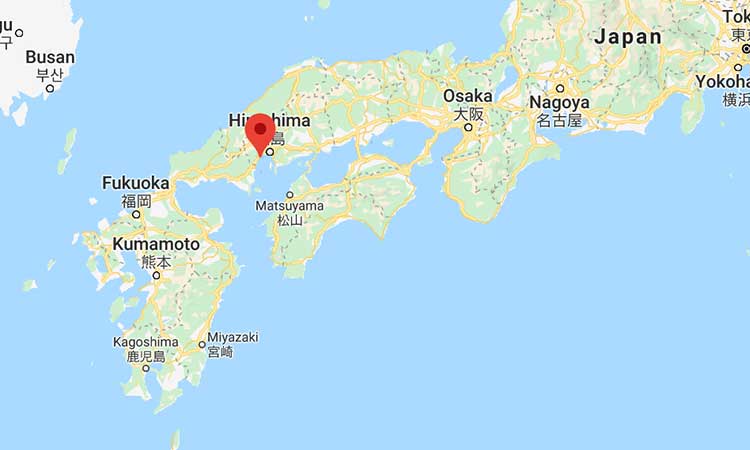
Miyajima is located at the gateway to the Japanese city of Hiroshima, around 20 km away. The small island belongs to the Hiroshima prefecture. Check our map above for its exact location in Japan.
How to get to Miyajima?
From Hiroshima Station (JR Hiroshima Station), you can take the train to Miyajimaguchi . The duration of the trip is around 30 Minuten and costs 420 Yen (ca. $ 3) . From there, you can find the port after a short walk.
Extra tip: Take the underpass because the road to the port can not be crossed on foot. Follow the signs to the port.
From Miyajimaguchi port, take a ferry. There are two companies which you can choose from. Each ticket costs 180 Yen (ca. $ 1.30). So economically speaking, it doesn’t matter which one you are choosing.
But we got recommended to use the JR Line as this one drives by nearer the orange torii. Thus, you get a better view of it.
Miyajima Extra tip: If you are traveling with a JR pass, you can take the JR Line ferry between Hiroshima and Miyajimaguchi free of charge.
A comprehensive Miyajima Itinerary for an Amazing Day Trip
The orange “floating” torii.

Important note: Construction work is currently taking place on the famous orange water torii. This work is expected to continue until the end of 2022. The torii may be covered at the time of your visit.
Miyajima is most famous for the Itsukushima Shrine with its orange torii. The unique thing about this torii is its location in the middle of the water. Because of its location, one could almost think that the torii would float in the water.
What many visitors do not know, however, is that the orange gate is not always in the water. Depending on whether the tide is high or low (depending on the time of day), you may simply walk to the torii in the dry.
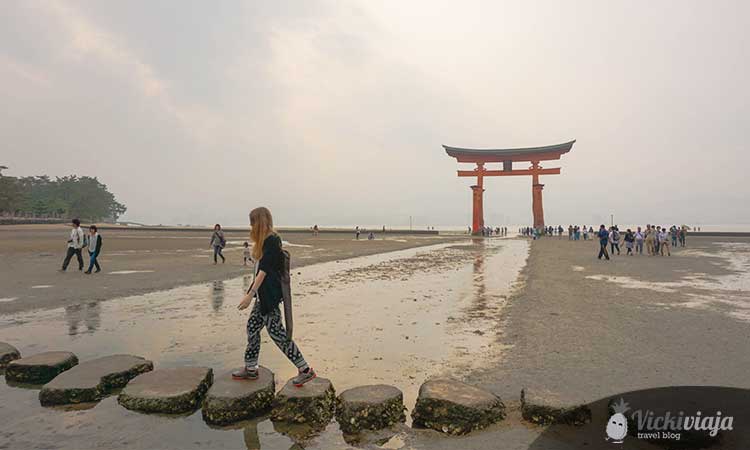
It is, therefore, worth asking about the current tides before you arrive. So, with a bit of luck, you can examine the Torii “floating in the water” but also at low tide. The advantage of low tide is that you can walk right up to the torii and see it up close.
Extra tip: A visit is also worthwhile in the evening. After a usually beautiful sunset (especially worthwhile at high tide), the Torii is illuminated daily until 11 pm.
Itsukushima-Shrine

Opening hours Itsukushima: 06.30 am – 6 pm (Opening hours may vary depending on the season. Check the current opening hours here)
Entrance fee Itsukushima: 300 Yen (approx. $ 2) or 500 Yen (approx. $ 3.50) for a comb ticket with Treasure Hall
As early as the 6th century, this impressive shrine was built, which is still considered one of the most popular sights in Japan. The shrine has looked the way it does today already since the 12th century – 1168, to be exact. Since that year, also stands the famous 16-meter high torii, which had once been the gateway to the sacred island.
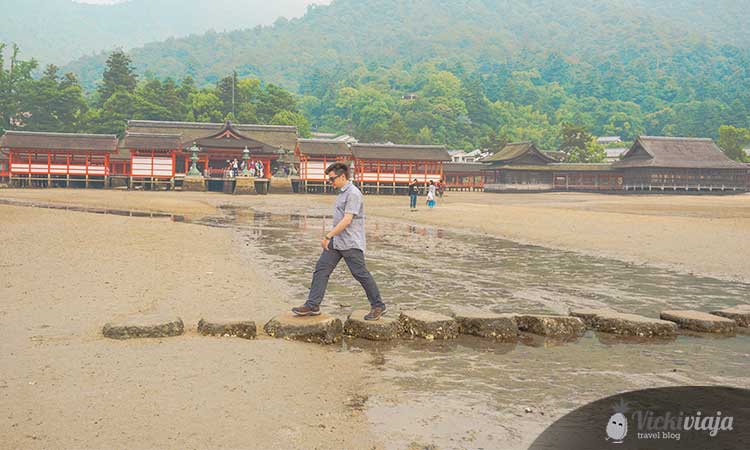
But not only the famous water torii of Miyajima make the Itsukushima shrine a unique sight. After all, the imposing shrine is built on logs. Thus, the religious complex also seems to float on the water at high tide. Because at this time of day, the temple is surrounded by water.
The shrine can be reached during high tide (and, of course, during low tide) via wooden bridges. Wooden walkways also connect the different parts of the complex.
Itsukushima Shrine Treasure Hall
Öffnungszeiten Itsukushima Treasure Hall: 08 – 17 Uhr
Entrance fee Itsukushima Treasure Hall: 300 yen (approx. $ 2) or 500 yen (approx. $ 3.50) for a combi ticket with Itsukushima Shrine
A visit to the Itsukushima Treasure Hall is also worthwhile. The hall houses an extensive collection of Buddhist art from Japan and China. This collection includes statues, paintings, and scrolls. Many of the valuable exhibits were donated by prominent figures from the surrounding cities of Japan.
Goju-no-to – the 5-storied pagoda of Miyajima
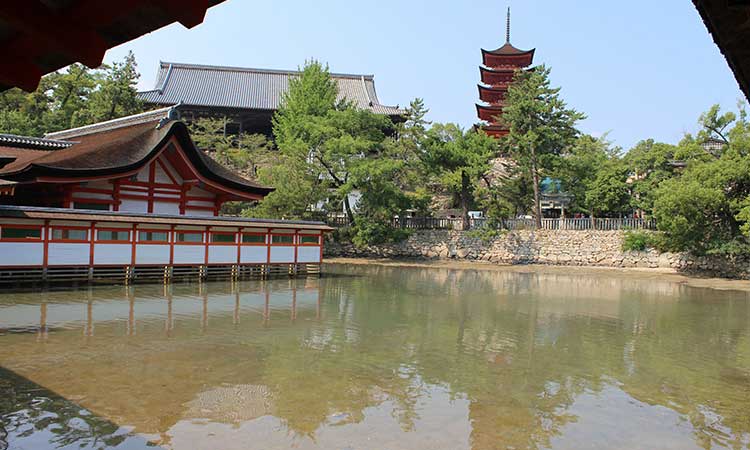
Opening Hours Goju-no-to: 08.30 am – 04.30 pm
Entrance Fee Goju-no-to: free of charge
Walking around the island, the sight of Miyajima’s 5-story pagoda (Gojunoto) will certainly not escape your attention. The vast pagoda stands on a small hill, which makes its impressive size even more prominent.
Architecture buffs will undoubtedly notice that this early 15th-century Japanese pagoda has distinct Chinese influences, which makes it quite unique. If you are less interested in architecture, you will indeed be enchanted by the beautiful view from here. However, the pagoda itself cannot be entered.
Senjokaku – The Hall of a Thousand Tatami Mats
Opening Hours: 08.30 am – 04.30 pm
Entrance Fee: free of charge
On the same complex of the 5-story pagoda, we can also find another interesting building, The Hall of a Thousand Tatami Mats. In fact, the actual name of the shrine is Kokoku Shrine. Despite this, the vast hall is usually referred to as the Hall of a Thousand Tatami Mats, as this gives an estimate of its approximate size.
The shrine was built under the order of the critical Japanese politician Toyotomi Hideyoshi and was never completely finished. Today the hall is also dedicated to him.
Daisho-in Temple

Opening Hours Daisho-in: 08 am – 05 pm
Entrance Fee Daisho-in: free of charge
In addition to the famous Itsukushima Shrine, there are other popular sights and temples to explore during your visit to Miyajima. One of them is the Daisho-in temple. This fantastic temple is only a 15-minute walk from the port. The temple was founded in 806 and is known for its gorgeous gardens. A variety of plants grow in the gardens, including Japanese maples, azaleas, and camellias.
Besides that, many Buddha statues in the temple can be found spread all over the temple complex. Another popular sight at the temple is a large bell every visitor can ring once. From the top, you also have a great view of the island down to the orange Torii.
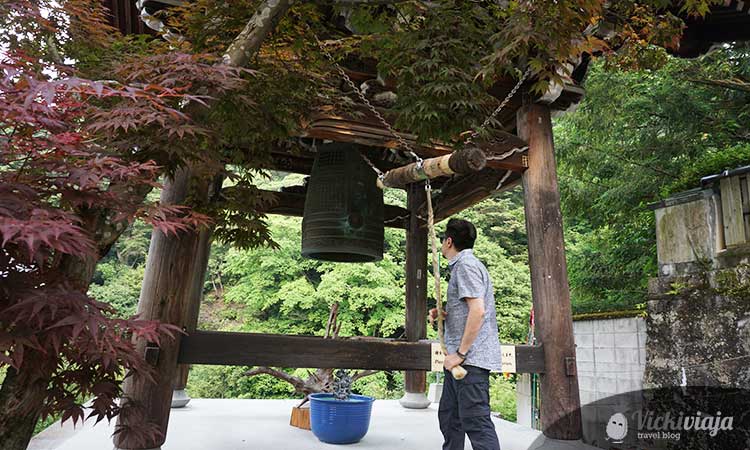
The Daisho-in Temple is considered one of the most important representatives of Shingon Buddhism in Japan. Other parts of the temple can be found on the top of Mount Misen, at the foot of which the temple is located.
Mount Misen
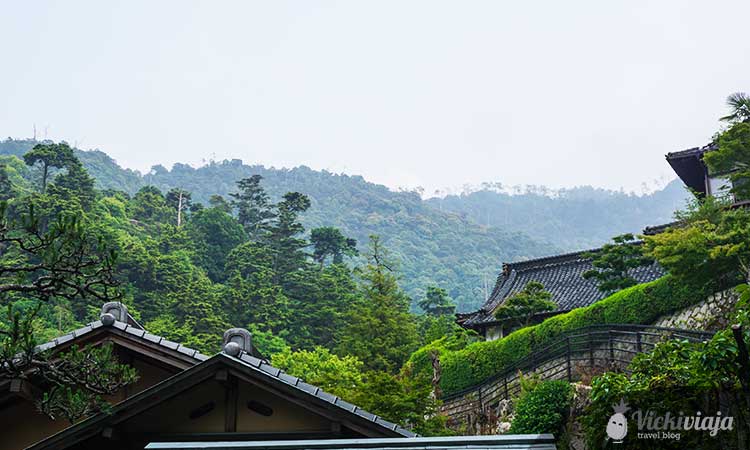
Mt. Misen, with its 500 meters height, is the highest mountain in the middle of the island. A visit here is ideal for a walk or hiking. But a cable car can also take you up to enjoy an incredible view of the island and its unique nature. On clear days you can even see as far as Hiroshima.
The ascent to the top takes about 1½ to 2 hours and is usually easy to do. There are three different hiking trails to reach the top of the mountain. It is only vital that you don’t walk up too late to be back down before dark.
If you visit Miyajima Island only on a day trip, you might want to take a shorter walk as your time might be a little too tight to see it all.
On your ascent, you will find impressive peaceful nature, incredible viewpoints, and some religious relics belonging to the Daisho-in temple, located at the foot of the mountain.
With some luck, you can even spot a few wild monkeys next to the little deer on the way up. However, many monkeys have been brought to surrounding monkey parks in recent years. A reason for this is that the population has grown too much.
Important: Even if you take the cable car up, you still have to walk at least 1 km to reach the top of the mountain. Access to the cable car is about a 10-minute walk from Itsukushima Shrine.
The Deer of Miyajima

Another reason that drives many visitors to the island is the free-roaming deer. Similar to Nara, deer can be found on Miyajima as far as you see. So you should take good care of your bags, especially if you carry food.
We were able to observe several deer who (more or less successfully) attacked visitors to steal their food. And when they are not after the visitors’ food, they stop at the street food stands. Because why not try?


Omotesando Street

Omotesando is the main visitor street of Miyajima. Here you will find restaurants, shops, and street food stands (and deer, of course).
There are a lot of delicious Japanese dishes and specialties to try on this street. It is hardly surprising that this street is considered the most famous street on the island.
When visiting Omotesando Street, you should definitely try Momiji Manju, which is so popular here. This is a pastry filled with red bean paste. A typical delicacy for the island, and it’s absolutely delicious.
Miyajima Public Aquarium
Opening Hours Aquarium Miyajima: 09 am – 05 pm
Entrance Fee Aquarium Miyajima: 1.420 Yen (ca. $ 10)
There is also an aquarium on the island. If you are interested in sea creatures or are traveling with children, you should definitely not miss this activity. In addition to much interesting fish and exotic marine life, special events every day await you. Among other things, seal feeding and Penguin Fun Times are events that are offered at the Miyajima Aquarium.
Miyajima Day Trip or Overnight Stay?
Miyajima is simply a great destination. Whether you choose a day trip or an overnight stay doesn’t really matter. Of course, it also depends on how much time you have at hand for your visit. In the following paragraph, you will find the advantages and disadvantages of a day trip to Miyajima and an overnight stay.
Benefits Miyajima Day trip
- Doesn’t take much time
- You can also visit the city from Kyoto or Osaka
Drawbacks Miyajima Day Trip
- not much time on the island, especially if you are arriving from Kyoto or Osaka ⇒ relatively long journey
- Often you only see the Torii at one time, i.e., either during the high tide or low tide
Benefits overnight stay in Miyajima
- More flexible regarding time
- You can experience the torii during different tides (low tide and high tide)
- You can discover the island with far fewer tourists around
- Miyajima is the perfect place for an overnight stay in a ryokan
Drawbacks overnight stay in Miyajima
- Takes more time than a day trip
- After 6 pm all shops and many restaurants close their doors
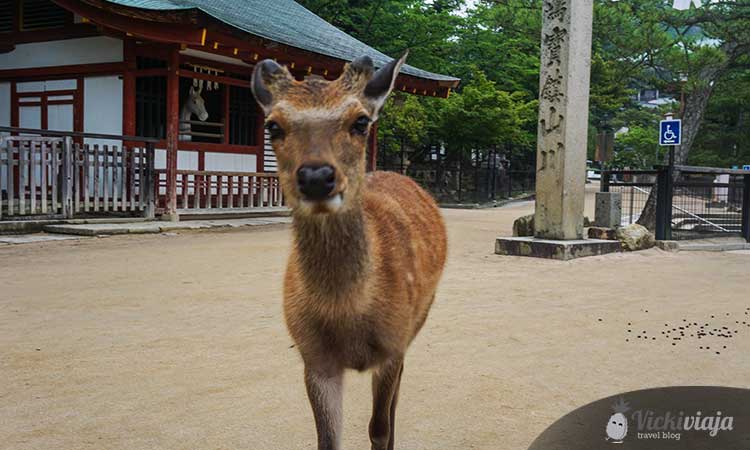
The best place to stay in Miyajima
If you decide to stay on this unique island, we strongly recommend you spend the night in a traditional Japanese ryokan. Even though such an overnight stay is not particularly cheap, it is still considered one of the most extraordinary experiences you will undoubtedly remember even a long time after your trip to Japan.
Mizuhasou Ryokan

This typically traditional 2-star ryokan is definitely one of the best and most popular accommodations on the island (so be sure to book in advance!). You can choose between a traditional Japanese room and a Western-style room (we definitely recommend the Japanese one to enjoy the whole experience).
The accommodation is within a short walk of Itsukushima Shrine and the Ferry Terminal.
Each room comes with a flat-screen TV. However, bathrooms are shared with other guests, as is customary in a traditional ryokan.
For the complete Japanese experience, yukata robes and house clothes are also available for all guests. The excellent breakfast is included in all reservations. Depending on the reservation, guests may also have a typical traditional Japanese dinner included in the price, where fish and seafood lovers, in particular, will get their money’s worth.
Check more info, prices, and availability of Mizuhasou Ryokan
Would you rather stay in Hiroshima?
To check all accommodations in Hiroshima, click here .
FAQ about traveling to Miyajima
We recommend spending at least one day on the island. If you also want to discover the nearby city of Hiroshima, you should plan a good 2-3 days if possible.
The ferry crossing from Miyajimaguchi to Miyajima only takes around 10 minutes. During the trip, you have a fantastic view of the island’s famous Torii.
After the tourists leave the island, it can become tranquil on the island. But if you always wanted to spend the night in a traditional ryokan, Miyajima is the perfect opportunity.
In theory, that is possible. To do this, you must start very early in the morning and probably be on your feet all day. We, therefore, recommend that you plan at least 2 days to explore these two great places in Japan.
Miyajima is especially famous for its Torii, which belongs to the Itsukushima shrine. Everyone has probably seen the picture of the famous “ Toriis floating in the water” before.
Yes, you can. You can take the JR Line ferry from Miyajimaguchi with the JR Pass for free. The same applies to the JR train between Hiroshima and Miyajimaguchi.
That is entirely up to you. Those who like it quietly will find excellent accommodation in Miyajima. If you prefer to stay in a city and want to go out in the evening, you are better off in Hiroshima.
Since the two Japanese cities of Osaka and Kyoto are very close together, the ride on the high-speed train only makes a difference of around 10 minutes. So it doesn’t matter which of the cities you come from.
Miyajima means “ shrine island.” The very name already refers to the Itsukushima shrine on the island, which is also the actual namesake of the island.
Read more of our Japan Travel Guides to plan your trip to Japan perfectly.
- Our ultimate two-week Japan itinerary
- Things you should definitely know before you travel to Japan
- How much does a trip to Japan cost? – All our Japan Travel costs at a glance
Have you ever been to Miyajima? What was your absolute highlight? Or do you have any questions about the island? Let us know in the comments below!

Interested in Japan?

About the Author Vicki
Hi, we are Vicki & Eduardo, an international travel couple on a mission to help you save money for priceless travel experience. Follow us through the miracles of this world and you will be rewarded with a bunch of practical travel tips.
Leave a Comment Cancel reply
This site uses Akismet to reduce spam. Learn how your comment data is processed .
JavaScript is disabled. Please enable.
Miyajima — Hiroshima Schedule and Price List
- Discounted Fares
- Steps to Take Before Boarding
- Ship Facilities, etc.
- Recommendations
- Information on Boarding Sites
■Please click here for the 2023-2024 year-end and new-year timetable.
Schedule *As of November 29, 2022
Regular schedule.
△→ Service only available on weekends and national holidays. However, there is no service on weekends and national holidays between December and February. *→ Sails to Hiroshima Port via Prince Hotel Port. ■ The ticket counter is some distance away from the boarding site. Please allow enough time to check in. ■ Cruise distance [Hiroshima — Prince Hotel 2.62km][Prince Hotel — Miyajima 15.05km] [Hiroshima — Miyajima 15.19km]
Price List *As of November 29, 2022
Passenger fare: one way per person (tax incl.) *april 1, 2023 revision of fares.
■ Junior high school students and older are charged the adult fare. The fare for children refers to elementary school children. ■ Infants (under age 1 year) are free. One preschool child (toddler) per adult sails for free. If an adult sails with more than 1 preschool child, each additional preschooler will be charged the children’s fare. ■ Passengers sailing round trip should purchase the “ 1-day Unlimited Pass ” (Adults 3,800 yen/Children 1,950 yen). One-day free pass includes 100 yen Miyajima visitator tax.
■Starting from October 1, 2023, an additional fee of 100 yen will be required for visiting Miyajima.For more details, please visit the website of Hatsukaichi City .
Passenger Fare: One way per person (tax incl.)
*The fare is after April 1, 2023.
■ Junior high school students and older are charged the adult fare. The fare for children refers to elementary school children. ■ Infants (under age 1 year) are free. One preschool child (toddler) per adult sails for free. If an adult sails with more than 1 preschool child, each additional preschooler will be charged the children’s fare. ■ Passengers sailing round trip should purchase the “ 1-day Unlimited Pass ” (Adults 3,400 yen/Children 1,700 yen).
Discounted Fares *As of November 29, 2022
Discounted fares: one way per person (tax incl.).
■ Reservations must be made in advance for groups of 15 persons or more. ■ The discount rate differs if an extra vessel is needed, so please inquire. ■Starting from October 1, 2023, an additional fee of 100 yen will be required for visiting Miyajima.For more details, please visit the website of Hatsukaichi City .
Steps to Take Before Boarding *As of November 29, 2022
Step 1 reservations (up to 17:00 the day before).
Please make a reservation by telephone. Persons without a reservation may board on the day of passage on a first-come, first-served basis.
STEP 2 Check-in Procedure (on the day of passage)
■ Persons who have purchased a voucher, etc. in advance must also check in. ■ Check-in begins 30 min. prior to departure. Please complete the check-in procedure at least 5 min. before departure.
STEP 3 Payment (on the day of passage)
Hiroshima Port Please pay at the counter on the day of passage. Payments cannot be made in advance. *Only cash is accepted at the ticket counter.
■ Prince Hotel Port On the day of passage, please pay at the Setonaikaikisen Travel Service counter next to the front desk.
Miyajima Port Only cash is accepted since Miyajima Port does not have a ticket machine. Please pay at the counter on the day of passage.
Setouchi Sea Line Head Office<
Setouchi Sea Line Miyajima Port
Ship Facilities, etc. *As of November 29, 2022
Persons using a wheelchair.
Information on boarding gangways for each port, onboard dimensions, and cruise ferry elevators are provided. Please check the details below before boarding.
Carry-on Baggage
■ Carry-on baggage is limited to items with length, width, and height totaling a maximum of 2m and weighing a maximum of 30kg. Each passenger is allowed up to 2 carry-ons. No fee is charged. ■ Bicycles are only allowed if they can be folded up and placed in a bicycle bag. ■ Small animals are treated as carry-on baggage. Passengers traveling with an animal must read the information below.
Recommendations *As of November 29, 2022
1-day unlimited pass.
This pass offers unlimited 1-day sailing for all Setouchi Sea Line cruise routes operating in Hiroshima Bay! Enjoy visiting Hiroshima, Miyajima, Etajima, and Kure.
Miyajimarine Package
This money-saving plan pairs tickets for the high-speed ship from Hiroshima/Prince Hotel Port to Miyajima with admission to “Miyajimarine”, the Miyajima Public Aquarium. You can use this package for either a round trip or a one-way trip, whichever your travel plans allow.
Matsuyama ⇔ Miyajima Cruise Pass
Save money traveling from Miyajima to Matsuyama! The pass combines Miyajima — Hiroshima high-speed ship tickets and Hiroshima — Matsuyama Super Jet tickets for super savings!
Information on Boarding Sites *As of November 29, 2022
Hiroshima port information, detailed information on hiroshima port, boarding site.
- High-speed ships to Miyajima depart from the No. 6 jetty in front of the terminal.
Nearby parking areas
Miyajima port information, detailed information on miyajima port.
- The ships sailing to Hiroshima/Prince Hotel depart from the No. 6 jetty on the No. 3 pier. *Please note the boarding site for ferries going to Miyajimaguchi is different.
Miyajima Sightseeing and Night Kagura in Hiroshima City
Have you ever wondered what makes Miyajima and Hiroshima City such captivating destinations for travelers?
The allure of the iconic floating torii gate and the mesmerizing Night Kagura performances under the night sky beckon visitors to explore the rich cultural tapestry of these Japanese gems.
As the sun sets over Miyajima and the city comes alive with traditional dance and music, a sense of wonder and culture awaits those who seek a truly unforgettable experience.
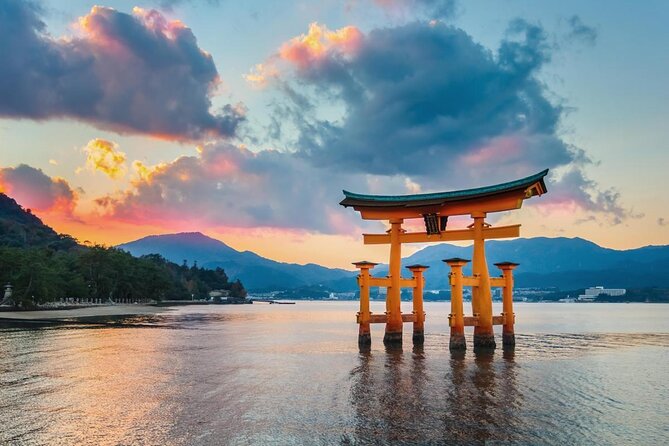
- Explore Miyajima’s iconic torii gate and natural beauty.
- Immerse in traditional Night Kagura performances in Hiroshima.
- Indulge in local cuisine and serene ferry rides.
- Gain insights into Japan’s culture and history through unique experiences.
Here's some more nearby activities we've reviewed
- Miyajima: Cultural Experience in a Kimono
- Hiroshima: City Reconstruction History E-Bike Tour
- Hiroshima: Traditional Japanese Archery Experience
- Hiroshima & Miyajima Island Private Guided Tour
Customer Support and Assistance
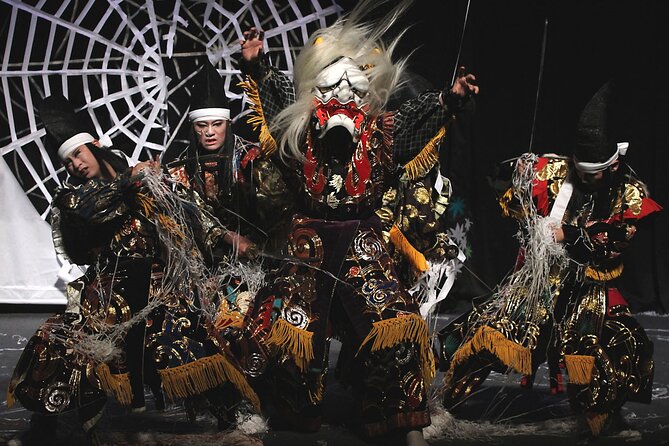
When seeking assistance with any inquiries or concerns, contacting customer support is the most efficient way to address questions related to your Viator experience.
Whether you need travel recommendations or information on local attractions like Miyajima Sightseeing or Night Kagura in Hiroshima City, the customer support team is there to help.
They can provide insights on activities, assist with bookings , and offer guidance on making the most of your trip.
By reaching out to customer support, you can ensure a smooth and enjoyable experience as you explore new destinations and learn about different cultures.
Don’t hesitate to contact them for any assistance you may need during your travels.
Terms & Conditions
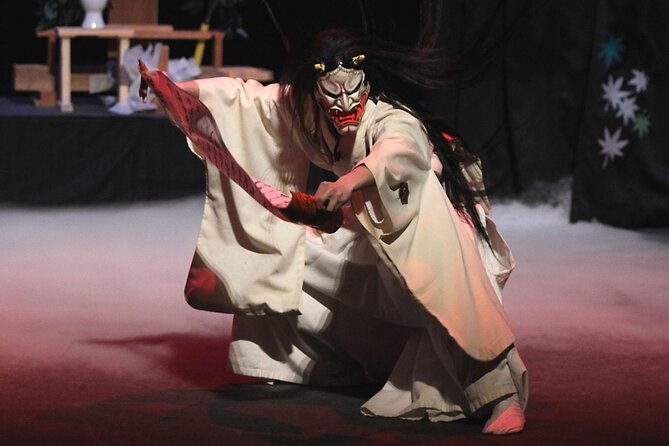
Exploring Viator’s diverse travel experiences requires a thorough review of the terms and conditions to ensure a seamless booking process and understanding of usage guidelines. Before making any purchases, travelers should carefully examine Viator’s refund policies and booking guidelines to be informed about cancellation procedures.
Plus, being aware of any usage restrictions is crucial to avoid any misunderstandings during the travel experience. Following the guidelines for booking and reservations will help travelers secure their desired activities efficiently. Staying updated on any changes to the terms is also essential for a smooth trip.
How Viator Works
To understand how Viator works, travelers can effortlessly browse through a myriad of travel experiences tailored to their preferences and interests. By visiting the platform, users can select their desired destination and explore a wide range of available options for activities and tours.
Through the convenience of online reservations , travelers can securely book their chosen experiences, ensuring a hassle-free booking process. The platform also provides access to reviews and ratings from fellow travelers, offering valuable insights to help make informed decisions.
Upon completing the booking, travelers receive confirmation details, making it easy to manage their itinerary. Viator simplifies the travel booking process, allowing adventurers to plan and reserve their desired activities with ease.
Miyajima Sightseeing
Visitors to Miyajima can marvel at the iconic floating torii gate, a symbol of spiritual significance and architectural beauty. When exploring this enchanting island, they can:
Explore Nature : Wander through the lush forests and hike up Mount Misen for breathtaking panoramic views of the Seto Inland Sea.
Local Cuisine : Indulge in the island’s culinary delights, such as the famous Momiji Manju—a maple leaf-shaped sweet filled with red bean paste.
Ferry Ride : Experience a unique journey to the island by taking a ferry, offering a serene and picturesque passage across the calm waters.
Miyajima promises a harmonious blend of natural wonders and gastronomic pleasures for an unforgettable visit.
Night Kagura in Hiroshima City
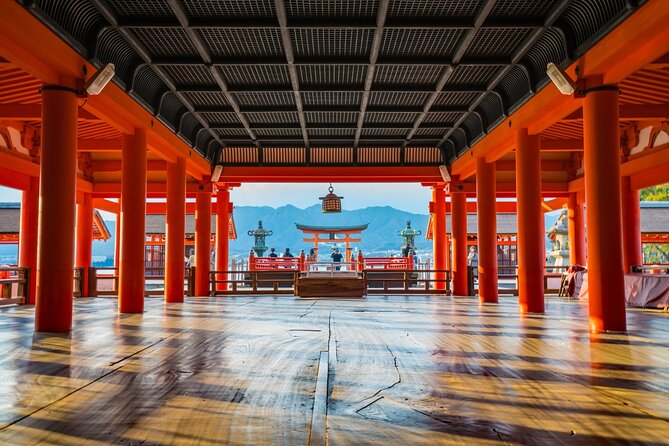
Enjoy the captivating world of traditional Shinto performances with Night Kagura in Hiroshima City, where the art of Kagura dance comes alive under the evening sky.
Night Kagura offers a unique opportunity to witness cultural traditions through mesmerizing performance art . This ancient form of entertainment showcases elaborate costumes, lively music , and intricate choreography that depict mythical stories and legends.
By attending evening shows, visitors can explore the cultural significance of Kagura, gaining insight into Japan’s rich history and traditions.
Experience the magic of Night Kagura in Hiroshima City, where the beauty of the dance and the depth of the narratives intertwine to create a memorable and enlightening experience.
Directions for Visiting Miyajima
For a smooth journey to Miyajima, consider taking the ferry from Hiroshima Port. Once you arrive at this picturesque island, there are several must-visit attractions and delicious local cuisines to enjoy:
Tourist Attractions :
- Visit the famous floating torii gate.
- Explore Itsukushima Shrine on the island.
- Enjoy scenic views of Mount Misen.
Local Cuisine :
- Try local delicacies like Momiji Manju, a sweet maple leaf-shaped cake.
- Sample fresh seafood dishes at the local restaurants.
- Savor Hiroshima-style okonomiyaki, a savory pancake packed with various ingredients.
Make the most of your visit to Miyajima by enjoying its beauty and culinary delights.
Tips for Enjoying Night Kagura
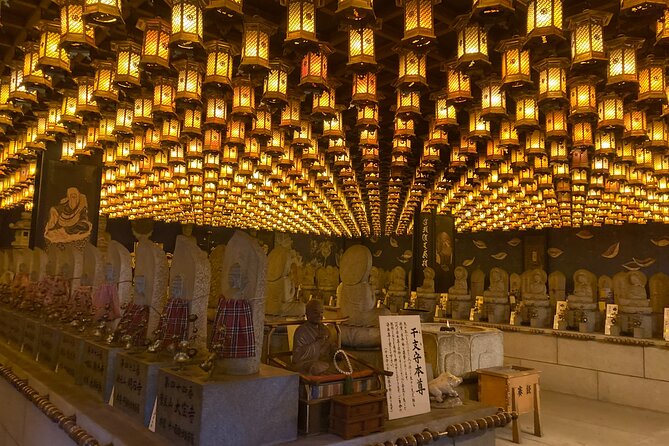
To fully appreciate the enchanting artistry of Night Kagura performances in Hiroshima City, attendees can enhance their experience by understanding the cultural context and significance behind each captivating dance. When attending Night Kagura shows, it’s essential to follow Night Kagura etiquette to show respect for the performers and the traditions they represent. Here are some Kagura performance tips to make the most of your experience:
Cultural Insights: Shinto Performances
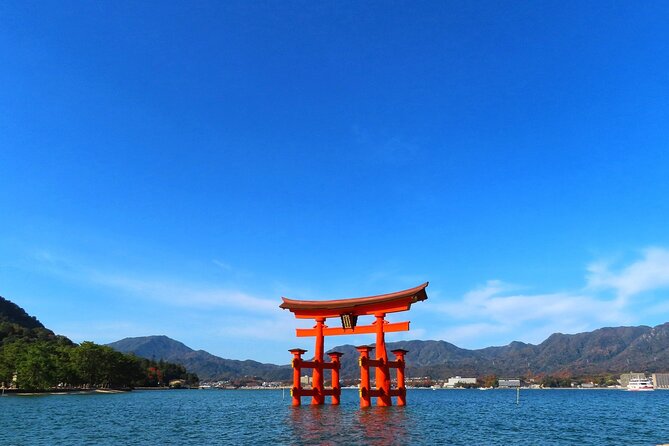
Attendees of Night Kagura performances in Hiroshima City gain profound cultural insights into Shinto traditions through the mesmerizing artistry of the dance. This traditional form of entertainment offers a window into the rich heritage of Japan, showcasing the following:
Shinto Rituals: Witness ancient rituals and ceremonies that have been preserved through the centuries.
Kagura Traditions : Experience the intricate movements and symbolic gestures that are integral to Kagura performances.
Cultural Significance: Learn about the historical context and spiritual beliefs that underpin these mesmerizing displays.
Immersing oneself in the world of Night Kagura allows for a deep appreciation of Japan’s cultural tapestry and the enduring legacy of Shinto practices.
Here's a few more nearby tours and experiences we have reviewed.
- Hiroshima: Peace Walking Tour of World Heritage Sites
- Hiroshima: Morning Hiking Tour With Open-Air Tea Ceremony
- Hiroshima: Full-Day City Highlights Private Guided Tour
- Miyajima: Private Rickshaw Tour to Itsukushima Shrine
- Hiroshima Like a Local: Customized Guided Tour
- Half Day – Oku-Yuki River Trekking!
Common questions
Are there any specific dress code requirements for attending the night kagura performances in hiroshima city.
When attending the night Kagura performances in Hiroshima City, there isn’t a strict dress code, but it’s respectful to wear cultural attire or smart casual outfits. Audience members should observe etiquette, appreciate traditional music , and follow performance expectations for a memorable experience.
What Are the Best Times of Day to Visit Miyajima for Optimal Sightseeing Experiences?
For the best photography spots , mornings and late afternoons offer optimal lighting at Miyajima. Avoid peak tourist times for quieter moments. Capture the floating torii gate and Mount Misen’s beauty during these serene times for memorable sightseeing experiences.
Is There a Preferred Mode of Transportation to Get to Hiroshima City From Miyajima for the Night Kagura Performances?
When heading to Hiroshima City from Miyajima for Night Kagura performances, the preferred mode of transportation is a ferry ride. Dress code for Night Kagura usually includes comfortable attire, although specific requirements may vary.
Are There Any Local Tour Guides Available to Enhance the Miyajima Sightseeing Experience?
Local guides can enhance the experience, providing insights and culture during sightseeing. Their knowledge adds depth to exploring destinations. For a richer understanding, engaging with a local guide can offer unique perspectives and enrich the journey.
Can Visitors Participate in Any Hands-On Cultural Activities During the Night Kagura Events in Hiroshima City?
Visitors can engage in cultural workshops and interactive experiences during night events in Hiroshima City. Participation in hands-on activities enhances the immersive nature of the night kagura, offering a deeper understanding of traditional practices.
Here's more of our most recent tour reviews happening neaby
- Private Transfer From Hiroshima Airport (Hij) to Hiroshima Port
- Witness an Oyster Harvest & Interact With Local Oyster Farmers!
- Visit World Heritage Site Itsukushima Shrine by Sea & Oyster Raft Tour
- Hiroshima City and Miyajima Bus Tour From Osaka and Kyoto
- Hiroshima Food Tour With a Local Foodie, 100% Personalised & Private
- Hiroshima Kagura Dance Show and Roof Top Bar Night Tour
- Sea Kayaking Tour With Lunch! a One-Day Adventure by Sea Kayak in Hiroshima
- Visit Izakaya and Hiroshima Yokogawa District
- Charter Bus 3 Days Tour to Hiroshima via Sanin From Fukuoka
- Lunch Cruise on HANAIKADA (Raft-Type Boat) With Scenic View of Miyajima
- Shared Arrival Transfer : Hiroshima Airport to Hiroshima City
Experience the magic of Miyajima and the captivating Night Kagura in Hiroshima City for a truly unforgettable journey into Japan’s rich cultural heritage.
From the iconic floating torii gate to the mesmerizing Shinto performances, these destinations offer a perfect blend of beauty, history, and traditions.
Enjoy the sights, sounds , and flavors of these enchanting locations, and create memories that will last a lifetime.
Don’t miss out on this unique travel experience!
Similar Posts
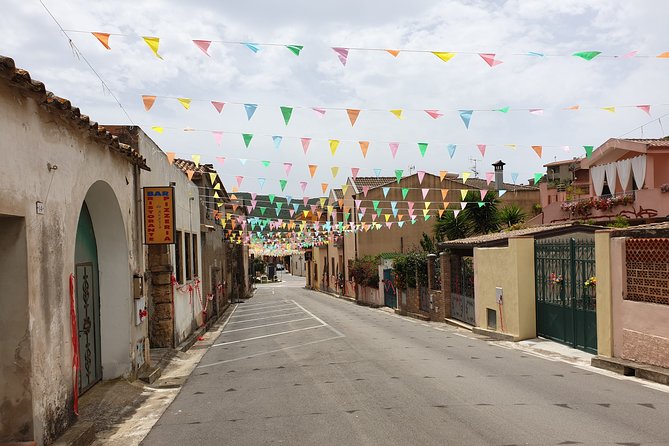
Cagliari Private Shore Excursion: Traditional Cooking Class With Lunch
Set out on a voyage back in time with the Cagliari Private Shore Excursion: Traditional Cooking Class With Lunch. Participants…

Private Transfer From or to Toulouse Airport or City Center, From or to Trèbes.
For travelers seeking a swift and stress-free journey to or from Toulouse Airport or the bustling city center to Trèbes,…

Desert Safari Dubai With Buffet Dinner
As the sun dips below the horizon, the Desert Safari Dubai With Buffet Dinner beckons travelers to a world where…

3 Days Golden Triangle Tour Delhi Agra Jaipur
Travelers from around the globe have raved about the mesmerizing beauty and rich history witnessed during the 3 Days Golden…
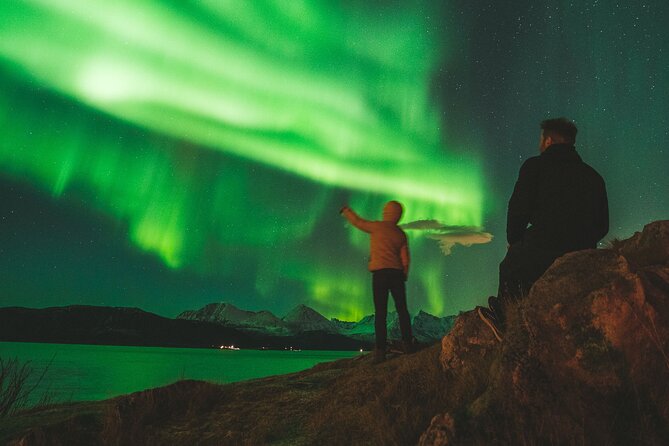
Northern Lights Expedition With David Jensen!
Immerse in the magic of the Northern Lights on an expedition with seasoned guide David Jensen in Tromso. Jensen leads…

Ferrari World Entrance Ticket
Amidst the allure of Ferrari World’s roaring engines and sleek designs, securing an entrance ticket becomes akin to holding the…
- Tours & Experiences
- Tailor-made Trips
- Bahasa Indonesia
We are happy to see you again!
Continue with
Or use email.
No Account? Create one
Create account
Already have an account? Sign in
Quickly Sign up with
I agree to Japan Travel's Terms of Service and Privacy Policy . Terms of--> and acknowledge that Japan Travel's Privacy--> applies to me.-->
Email reset password link
Please check your inbox and click the link we will send to you.
Mysterious Miyajima at Night
Seeing the island with fresh eyes - 4

I strolled the island at night. Warm during the day, it started to cool down after the sun set. There was a mysterious feel to everything in the dark that was also lonely and beautiful. The famous torii gate of Itsukushima Shrine stood by itself, reflecting off the shimmering water. Daisho-in Temple was shone high up on the hill. Lanterns along the shore cast off eerie light. And the number of people out taking photos quickly diminished. Suddenly, I was alone with a gorgeous view all to myself of one of the most iconic scenes anywhere in Japan.
Find out more about Itsukushima Shrine .
- Miyajima Island Series
- Share on Facebook
- Share on Twitter
- Copy link to share
By Larry Knipfing
Community writer
Leave a comment
Explore nearby.

Itsukushima Shrine, Miyajima
By Nicole Bauer

Miyajima Implements Visitor Tax to Tourists
By Serena Kim

Where God & Humans Coexist
By Takako Sakamoto

Miyajima: God's Island
Information.
Itsukushima Shrine
1-1 Miyajimacho, Hatsukaichi, Hiroshima 739-0588 ( Directions )
en.itsukushimajinja.jp
Book your trip
Find a nearby hotel, top articles.
- Recommended

Kurobe Unazuki Canyon Route to Link with Tateyama Kurobe Alpine Route

Tokyo Takes 2nd Place on Top Coffee Cities List

Anime Museums in Tokyo

Sapporo Beer Opens New Brewery in Tokyo’s Ebisu

Mount Omuro

Valley of Witches: a New Ghibli Park Attraction

Tokyo One of the World's Most Walkable Cities

Haneda Airport Ranked World's Cleanest

Guide to Golden Week

2024 Grand Sumo Tournaments

Guide to Bringing Medicines Into Japan

Your Name: Real-Life Locations in Tokyo

Hachiko Statue in Shibuya

Japanese Urban Legends

Iwatayama Monkey Park

Shibuya Crossing

Daikoku Car Meet

Guide to Suica Cards

Sanja Matsuri
Let us know how we can help.
Help us improve JapanTravel.com
We welcome any suggestions regarding this content. Your feedback is confidential and will be used to help improve this page.
Suggest an edit
https://en.japantravel.com/hiroshima/mysterious-miyajima-at-night/19189
Thank you for your support!
Your feedback has been sent.

- WHERE TO GO
- CHERRY BLOSSOMS
- FALL COLORS
One day in Miyajima itinerary ⛩ Things to do in Miyajima as day trip from Hiroshima! ⛩ Backpacking Japan travel blog
Preferably Miyajima is a day trip in which you dedicate the whole day to Miyajima, or close to it!
But, if you are limited on time, then you can do Miyajima and Hiroshima in one day.
I most recently went to Miyajima in June 2023.
It was actually a day trip from Kyoto to Miyajima and Hiroshima!
It was a LONG day!
Once again, you CAN do Miyajima and Hiroshima as a day trip from Kyoto, but preferably you will have more time!
And, if you do a day trip to Miyajima and Hiroshima, be sure to manage your expectations!
The part about it being a long day!
That trip was Miyajima with kids! I was with my cousin’s family, and her kids are age 12 and 8. The whole family had JR passes .
We ended up seeing Miyajima at low tide and high tide!
We were going to go to the Daisho-in Temple, but by the time we got there it was closed. (They block off the stairs.)
Instead, we took a trail nearby and there was a creek and waterfalls!
And of course we saw lots of Miyajima deer!
Miyajima has the distinction of being one of the official 3 most scenic places in Japan.

It’s a part of the nihon sankei , literally meaning 3 views of Japan.

This island definitely deserves a consideration as a part of your overall itinerary for the Japan golden route .
If you’ll be visiting Hiroshima, Osaka, or Kyoto, be sure to give Miyajima island a look.

First, the quick list of the must-visit places in Miyajima.
Then, a more detailed look into how you can fit ALL of these places into your one day Miyajima itinerary.
PLUS: Will you have time to visit Hiroshima and Miyajima in one day? In order to decide that, you’ll also want to know which of these things you want to see at the Hiroshima peace park .

10 best things to do in Miyajima in one day

1. Coastal walk with deer sightings

2. See the floating torii not floating at low tide

3. Walk to the Torii shrine gate at low tide

4. Visit Daisho-in Temple

5. Hike the Mount Misen trail to the highest point on Miyajima island

6. Rest at Mount Misen summit

7. Eat with views at Shishiiwa ropeway station restaurant

8. Take the Mount Misen ropeway back down to sea level

9. See the floating torii shrine gate at high tide

10. Visit Itsukushima Shrine at high tide

More below about a visit to Miyajima island!
- Best places to visit for your first time in Japan (including famous views!)
- Where to go to see cherry blossoms in Japan
- Where to go to see fall colors in Japan
- Where to go for winter in Japan
- Where to go to experience tropical Japan
- Where to go for epic snow-capped Mt Fuji views
Low tide vs high tide

The biggest thing that will determine the exact schedule you follow when you’re on the island is the Miyajima tide times .
The time of high tide and low tide will create 2 very different experiences.
High tide means that you get to see the famous iconic torii gate when it’s “floating.”
Low tide means that you can walk right on up to it!
Both can be worth it, so in an ideal itinerary, you’ll be on the island long enough for both high tide and low tide!
When I went, low tide was in the morning and high tide was in the afternoon, so this Miyajima itinerary is based on that.

So, how to put these into a one day Miyajima itinerary?

Now, here are some details about this itinerary to see if it’s something you want to follow!

Arrive at Miyajima ferry station

No matter if you make a trip to Miyajima as a day trip from Osaka or from Kyoto, or you’re staying in Hiroshima a few nights, you’ll be taking a ferry to get to Miyajima island .
When doing a day trip from Osaka or Kyoto, you’ll be going through Hiroshima. It’s possible to get from Osaka, Kyoto, and Hiroshima to Miyajima island exclusively with your JR pass, and that includes the ferry. You just need to make sure to take the JR ferry.
To catch the ferry to Miyajima from near Hiroshima station, you’ll go from Hiroshima to Miyajimaguchi station. It’s from Miyajimaguchi that you can take a ferry to the island.
Here are more options on getting to Miyajima by ferry from Hiroshima. You can also catch a ferry direct to Miyajima from the Hiroshima peace park near the atomic dome, or from Hiroshima port.
Stop by the information desk
Once you get off the ferry and make it to the waiting area of the terminal, there’s an information desk.
Stop by there to get a map for a better visual of where you’re going on Miyajima island. Also tell the tourism rep there what it is you want to do, and you may get some additional helpful pointers.
There’s also a luggage storage locker at the Miyajima ferry station so you can make plans to come straight to Miyajima island from your previous destination if you want to save a little bit of time.
Okay, now you’re ready to really start exploring Miyajima island!

Coastal walk with deer sightings
Once you make it outside of the ferry terminal, you want to head right.
And your coastal walk will start right away!
Take in the views, stop for some pictures of the deer, and just keep enjoying those coastal views!

As you continue walking along the coast, you’ll pass a bunch of vending machines. If you haven’t packed water, be sure to buy some drinks to stay well hydrated!
Walk to the Torii shrine gate at low tide

While the floating torii at high tide is what has made this shrine famous, there are some reasons that visiting Miyajima at low tide can be worth it too!

It’s only at low tide that you can walk straight up to the gate.
Visit to Daisho-in Temple

Next up is starting to head towards the summit of Mount Misen, the highest point on the island.
There are a few different trails that you can take to get to Mount Misen, and you can find the start of one trail right near the Daisho-in Temple.
So taking the Daishon-in Temple hiking trail to get to the Mount Misen summit gives you a chance to visit the grounds near the temple too.

Wandering around Daisho-in Temple requires some stairs, but you’ll likely find it to be worth it.

So it might be tempting to start the Mount Misen trail right away and skip the temple, but take some extra time to walk around the temple grounds too!
If you want to be quick, you can likely do a walk-through in 15-20 minutes.
Hike the Mount Misen trail

Reaching the Mount Misen summit is one of the top things can make a visit to Miyajima island totally worth it!
There are slightly easier ways to get to the summit besides hiking, but the views just look better when you have to work for it a bit! 😉
This Mount Misen hiking trail that starts near Daishon-in Temple is mostly stone steps to the summit.

It’ll likely take you between 1.5 hours to 2 hours to reach the Mount Misen summit.

Taking the Mount Misen ropeway up and down would be the less strenuous option.
But even if you opt to take the ropeway, it won’t take you to the summit. It’ll still require around an hour of hiking round trip.
Rest at Mount Misen summit

Once you’ve reached the summit, there’s the Mount Misen observatory.
Here you can take a bit of a rest while you enjoy the views!
Bring your own water and snacks.
Once you’re ready to leave the Mount Misen observatory and summit, you have a couple of options to get back down to see level.
You can take the same hiking trail to get back down, or you can take a different trail for a little bit of variety. Alternatively, you can take the ropeway down.
I decided to hike up to the Mount Misen summit, and then take the ropeway back down. That meant heading to the Shishiiwa ropeway station, which is about a 20-30 minute walk from the observatory.
Eat with views at Shishiiwa ropeway station restaurant
Cost: maybe 600 yen (us$5).

So once you are at the Shishiiwa station you can take the next ropeway that’s departing, or you can stop for a meal!

There’s a restaurant located at the ropeway station, so you can take it easy and have a meal with some of the best views in Japan!
Take the Miyajima ropeway down
Cost: 1,000 yen (us$9) one way.

The ropeway departs frequently enough, maybe every 15 minutes or so, so you don’t really need to worry about planning it out too much.
There are actually 2 types of cable cars you’ll be taking. You’re in the first one for about 5 minutes, then you’ll get off at a station part way down. Then you’ll get into another cable car that will take you the rest of the way down.
In all, this journey down the mountain takes about 15 minutes.
So nearly $10 might seem a bit pricey for a 15 minute ride, but you can think of it as taking it for the views, or you can take the free way down the mountain – the hiking trail! 😉
Once you get back down to sea level, there are free shuttles that will take you about a 5 minute drive down the road to Momijidani Park.
These depart every 20 minutes or so, and if you see it when you leave the station you might as well get on and take it, but otherwise, you might as well walk!
It’ll take you 10-15 minutes to walk the distance that the shuttle will take you.
Okay, so GREAT!
Now you’ve finished up one of the absolute BEST things to do in Miyajima – seeing those views from the summit!
Next, it’s another one of the absolute BEST things to do in Miyajima…
See the floating torii shrine gate at high tide
Whether you are walking from the Momijidani Park entrance that the free shuttle dropped you off at, or you are walking from the ropeway station, it’s a nice and easy stroll to get back to seeing the torii gate.
And if you saw the torii at low tide, now it’ll seem to have a different look to it at high tide!
And to see more torii gates, be sure to visit the Fushimi Inari taisha shrine in Kyoto where you can potentially see 5,000 torii gates!
Visit Itsukushima shrine at high tide
Cost: 300 yen (us$3).

You can also walk through the shrine too.

This is probably best done at high tide for the best scenes!
So be sure that you check the Miyajima high tide times before you go.
And there’s your perfect one day on Miyajima island!
If you follow this itinerary, there’s a good chance you’ll leave Miyajima thinking you had a great day!
Is there enough time to visit the Hiroshima peace park?

If you follow this Miyajima itinerary, you can easily stick around Miyajima island until sunset by taking it slowly with everything you do.
But you can also likely make time to have 1 or 2 hours to wander around the Hiroshima Peace Memorial Park.
Basically, after you finish up hiking Mount Misen, you just wouldn’t be taking it too slowly to get back to the ferry station.
It would be ideal if you had more time than just an hour or 2 to dedicate to the Hiroshima peace park and museum.
You can easily spend a half day or even a full day exploring everything the peace park has to offer.
But a couple of hours is better than no visit at all if you won’t be going to Hiroshima otherwise!
So in the case that you’re trying to maximize your time while you’re in the area, it would be reasonable to visit the top spots on Miyajima, followed up by a couple of hours in Hiroshima.
Just be sure to know these things before you go to Hiroshima .
How to get from Miyajima to Hiroshima peace park
When you’re trying to do Hiroshima and Miyajima in one day, try to catch the Miyajima ferry back by 3pm.
Then take the hiroden train to the Hiroshima Peace Memorial Park. The hiroden road tram has a stop right near the atomic bomb dome memorial.

That’ll get you to the park around 4pm, leaving you a couple of hours.
Another option is to take the direct ferry to the peace park , although that’s a slightly more costly option.

The park is an open public park meaning it never closes.

There is also a museum and a hall of remembrance that are both worth visiting.
You won’t have time to appreciate both of these in full, but if you want to catch a glimpse of them, be aware of their closing times. It’s best to confirm it, but it’s probably 6pm.

HAPPY MIYAJIMA ITINERARY PLANNING!
Here are ideas for 5 days in kyoto .
- Day 1: Top tourist spots with one day Kyoto bus pass
- Day 2: Fushimi Inari Shrine hike through 1,000 torii gates
- Day 3: Philosopher's Path walk
- Day 4: Arashiyama and Sagano
- Day 5: Kurama Kibune Ohara with one day pass
PLUS Kyoto cherry blossom itinerary and Kyoto fall colors itinerary !
Is a jr pass worth it.
- Google maps can make it easy to figure out whether or not you should get a JR pass!
- In google maps, type in your departure and arrival city, and choose the transit icon. The route will come up, and so will the estimated cost at the bottom!
- Here is an example of a train route with cost on google maps.
- So do that for all of your long distance routes to figure out how much it might cost.
- Next, go here to see how much a JR pass costs from an official JR pass vendor (and partner of this website).
- And compare!
- Not all forms of public transportation are JR, but long distance shinkansen bullet trains are, and that's where the most cost savings will come.
Best of Kyoto (and Japan!)
- Best temples to visit in Kyoto
- Japanese gardens in Kyoto
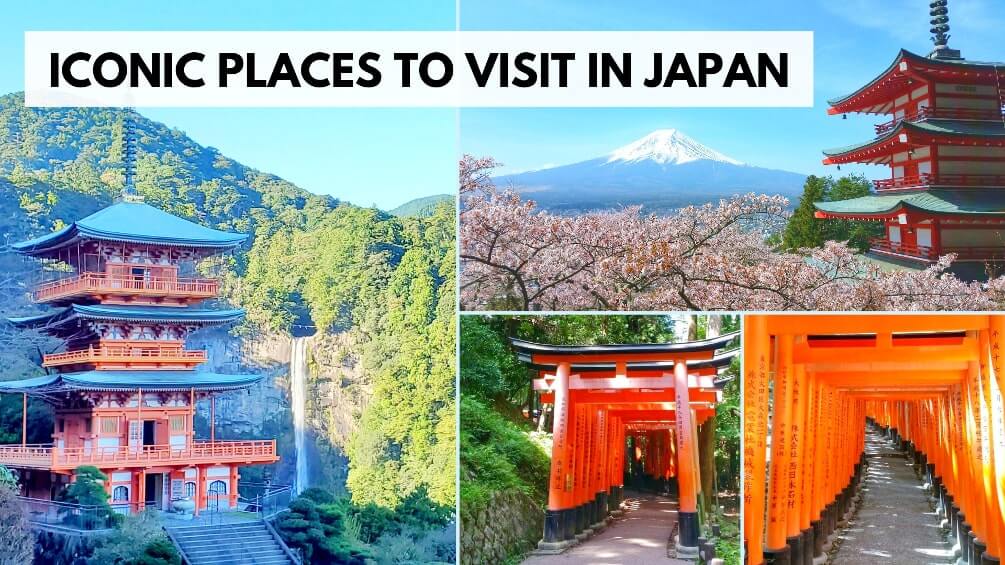
Cruise into Mayfield for a summer of recreational fun
- Updated: May. 09, 2024, 11:32 a.m. |
- Published: May. 09, 2024, 11:00 a.m.

The Village of Mayfield will hold its annual Cruise Night June 8 at Wilson Mills and SOM Center roads. Jeff Piorkowski
- Jeff Piorkowski/special to cleveland.com
MAYFIELD, Ohio -- With the month of June around the corner, the village is gearing up for its annual Cruise Night, as well as the usual variety of concerts at the gazebo and The Grove amphitheater.
Cruise Night, billed by the village as “Northeast Ohio’s premier car show,” will return from 4 to 9 p.m. June 8 at the corner of Wilson Mills and SOM Center roads.
If you purchase a product or register for an account through a link on our site, we may receive compensation. By using this site, you consent to our User Agreement and agree that your clicks, interactions, and personal information may be collected, recorded, and/or stored by us and social media and other third-party partners in accordance with our Privacy Policy.
- Regent Seven Seas Cruises
Best of Moscow by high speed train
By shuguley , February 15, 2014 in Regent Seven Seas Cruises
Recommended Posts

Sure would appreciate someone who has taken "Best of Moscow by high speed train" from St. Petersburg could please share their impressions of this shore excursion. From the description this sounds like a very long day.
Wondering how the 4 hour train trip was in terms of accommodations, etc. Also what time did you leave the ship and what time at night did you return? Were both legs of the trip on the high speed rail (I read that slower trains also travel the same tracks)?
My wife and I are considering this excursion. We thought that if we are making all the effort to go to Russia then how could we pass up going to Moscow, walking in Red Square, seeing St. Basil, etc.
Link to comment
Share on other sites.
If you are considering this on the 2015 June Baltic cruise on Voyager; my suggestion is don't. There is so much to do in St. Petersburg and although a train is one of my favorite ways to travel the time would be far better spent in St. P.
Thanks for the advice. Yes, this would be on the Voyager during the 2015 season but not yet sure exactly which cruise.

We did the Moscow excursion "on a different luxury line", but from your brief description it sounds very much like the same trip, so I will operate on that assumption. It is a VERY long day! We left the ship at 5:30 AM and returned at 12:30 AM. The highspeed train trip is comfortable, and while they call it "Business Class" it does not compare well to the equivalent class on say Rail Europe. When we did it in 2011, we did have highspeed both ways, and the trip back seemed much longer as the adrenaline and excitement had worn off!:D
Moscow itself is not that terribly different from any other big city in the world, but this Cold War kid never thought he would ever stand in Red Square, never mind walk the grounds of The Kremlin, or tour The Kremlin Palace, or see (but not visit) Lenin's Tomb, or visit The Armoury. But he did, and he loved every minute of it! Yes, it is a long day, and you barely scratch a scratch on the surface, but it is worth it. There is a tremendous amount to see in St. Petersburg, but every Baltic cruise goes to St. Petersburg, so you can go back if you choose to. Not every cruiseline offers you the chance to see Moscow.

I have not personally done this tour, but our last time in St Petersburg, the private guide that we hired for a day was leading the regent tour to Moscow on the high speed train the next day. He said it was way better than the previous alternative, which was flying to Moscow and back. He said that you actually got to Moscow faster because you didn't have to deal with airline checkin etc. it did seem like a very long day to me, and there is so much to see and do in st. Petersburg that I didn't consider doing it.
countflorida
We toured to Moscow from St. Petersburg via the hi-speed SAPSAN train last September, from a Baltic cruise on the Oceania Marina. You need to have a two-night, three day port call in St. Petersburg to take this tour because the tour typically leaves the ship around 5:00 - 5:30 AM and doesn't return until after midnight the next day. We didn't take the ship's tour; we made private arrangements with TravelAllRussia for three days of touring, the first and third days in St. Petersburg and the second day the tour to Moscow by train. Our cost for the private tour for three days was about the same as what the ship charged for the excursion to Moscow alone. There are a number of private tour agencies that operate in St. Petersburg and offer the Moscow train tours; we would strongly recommend them over the ship's tours.
All three days had private guides with car and driver. The second day, the driver picked us up at the ship and took us to the train, but we were alone on the train, and met in Moscow by the guide on the station platform. After our tour and dinner, we were brought back to the train and after the return train trip met by the driver and taken back to the ship. Because you are alone on the train you must have your own Russian visas.
If this is your first visit to St. Petersburg, I would agree there is much more to see there. We found Moscow somewhat a disappointment, particularly Red Square. The Kremlin and the cathedral in Red Square were also worth seeing. But the best thing we saw was the Moscow subway! I worked for the Washington Metro system back in the 1980s as it grew from 40 to 80 miles and although I was in the computer area, I learned a lot about the challenges of running a subway system. We used the Moscow system to get across the city from where we had dinner to the train station, and I was amazed at the cleanliness', speed of operation, the short headways maintained, and the courtesy of everyone involved. A very impressive experience!
We had been to St. Petersburg before, and so had the time to take a day and go to Moscow. Also, I really like trains, and the SAPSAN is a German train set running on Russian rails. Seats are like first class domestic air, spacious but not too plush or comfortable, but with enough room. Not too much recline, and almost 8 hours on the train in two shots is a lot for an old man. They come through and sell drinks, candy, etc. but the sellers don't speak English and no one around us helped, so we had just poor coffee once coming, and brought stuff with us for the trip back. Not too much to see from the train either, particularly on the return when it is night the whole way.
If you decide to go, take a private tour and avoid the overly expensive ship's tour. I'm glad we did it, but wouldn't bother to repeat the tour; we've seen Moscow.
Thanks so much to all of you for the thorough and thought insight. Yhe information you have provided is most helpful.
countflorida: Your detailed post is very helpful. We are not quite ready for a Baltic cruise but should do so within a year. Time enough to do our pre travel research, bookings and visa gathering.:) Thank you!

Emperor Norton
Sure would appreciate someone who has taken "Best of Moscow by high speed train" from St. Petersburg could please share their impressions of this shore excursion. From the description this sounds like a very long day. Wondering how the 4 hour train trip was in terms of accommodations, etc. Also what time did you leave the ship and what time at night did you return? Were both legs of the trip on the high speed rail (I read that slower trains also travel the same tracks)? My wife and I are considering this excursion. We thought that if we are making all the effort to go to Russia then how could we pass up going to Moscow, walking in Red Square, seeing St. Basil, etc.
I did this on Seabourn. IMO DONT. Take Aeroflop (er Aeroflot). The train has non folding seats where you are literally knee to knee with your fellow passenger (facing each other). Further they don't believe in air conditioning. It's also the worlds slowed bullet train. I think I would have found more enjoyment wandering around the St. Petersburg and Moscow airports.
Countflorida,
This is a little off topic,, however we had planned a river cruise in Russia but decided we would rather stay on land and have booked about two weeks with Travel-All-Russia using the private guide and driver. I'm curious as to how you found them as a tour company.
The guides they provided were fine. We had a different guide each of the days in St. Petersburg, but both were flexible, pleasant, knowledgeable and spoke English very well, as did the guide in Moscow, incidentally. She was a bit aloof, distant, not too friendly, but otherwise fine. In fact, she was the one who suggested taking the Metro, which unexpectedly became one of the highlights of the Moscow excursion. If I have a complaint with AllTravelRussia, it is with their plan and its execution (more later).
I had requested emphasis on World War II (in Russia, the Great Patriotic War) sites and info. In scheduling us, they weren't careful about dates and a couple of the sites we wanted to see were scheduled on the third day, after we'd been to Moscow. But both sites were closed that day of the week, and that info was readily available, right on web sites describing them. Also, the included meals (lunches in St. Pete, dinner in Moscow) were not what we asked for: light meals with some choices, so we could avoid things we didn't like and choose things we did like. My request was ignored; we were given full Russian meals with a fixed menu, no choice. On the first day, a fish dish was the entre, but I am allergic to fish. Fortunately, I had the e-mail I'd sent with me and showed it to the guide, and she was able to change my entre to chicken, which was very good actually. But we didn't want a 3-4 course lunches or dinner (in Moscow). We had the guide drop the lunch the third day, although we never got any credit or refund. But, particularly in contrast to the ship's tours, the prices were so reasonable we didn't worry too much about it.
The people who were on the ship's tour to Moscow saw us boarding the same train for which they were forced to queue up and wait on the way back, and asked us what we had done. I was candid and open so they were not happy when I explained what we had arranged and particularly what it had cost. Also, when we returned to the ship, we found they had laid on a late supper for those who had gone to Moscow, so up we went and had something. Well, it turns out the late supper was supposed to be just for those on the ship's tour, but we and others on 'independent' tours, there were a dozen or more of us, crashed the party, actually got there first, and they didn't realize it until the larger group arrived and there weren't enough tables/places set. By that time, the 'independents' had all gotten served and were eating; what could they do?
A couple from the larger group sat down with us and asked us about our tour, and they were the ones I told about our arrangement and its cost. They turned to others who’d been with them and announced the details, loudly enough so the whole room heard, which started a lot of bitching and complaining. I gathered they weren't very happy with the ship's tour to begin with, and this was the straw that broke the camel's back. We finished up and beat it out of there, but overheard later that one of the excursion staff came to check on something and ran into a real mess. I caught a cold on the trip, which forced me to bed the second day following in Tallinn, so by the time we reappeared we heard about the contretemps' but apparently no one recalled who started it, thankfully.
Because of what happened to us, I would probably not use AllTravelRussia if I were to go again, or if I did, I would be sure to get confirmation of every detail of the tour. They do have good reviews generally, and we were certainly helped by their visa department and liked the guides and drivers. Their weakness, I say now with full 20:20 hindsight, is that once the sales person who plans the tour, sells it to you and collects your money, he (or she) transfers the plan to their Russia office for implementation; there is no follow-up to make sure it gets done right. And that is where our problems arose; we paid for a custom tour but got a standard package with a few destinations switched, and no one checked them out, even to see when they were open the day we were scheduled to go. If you check every detail that’s important to you, it should be OK, but that’s a hell of a way to have to do business, in my opinion.
Thank you for the 20/20 hindsight observation on your Russian tour operator, and better priced than the ship's excursion cost.
Thanks very much for the feedback.
We had the same experience as you so far as price. We originally booked a Viking Cruise but, hearing some things about the river cruises that made us unhappy, looked into other options. T-A-R cost the same or less than a cruise and had us in hotels for 11 days. We opted for the private tour. They have three tour levels, based on hotels. We originally opted for the four star as it did not cost much more than the three star hotels. Finally we decided to throw it all in and upgraded to five star. In Moscow we will be at the newly opened Kempinsky which is two blocks from Red Square. In St. Petersburg it is the Grand Hotel Europe, one of the most vaunted luxury hotels in Russia. Location is important for us as the tours use up only part of the day so being in the center of everything for our independent touring is important. As with many other cities, the less you pay, the farther out of the center of town you are.
We have been working with our salesman in D.C. and he seems to get back to us with the changes we want. He recently returned from Russia so is up on everything. When I asked they said they paid the full TA commission if I wanted so I got my usual TA on board so he is watching our back and giving us that extra level of comfort. He also set up our air, which I know pays him little or nothing, and got us business class for much less than T-A-R wanted for economy, though it took working for a while with a consolidator. He's happy to get his 10 percent on this trip without having booked it. He also took care of the trip insurance. We've been doing a lot of research on the CC sister site Trip Advisor and will write a report there. We will, I guess, become a source of info for CC members after having spent 5 days in Moscow and 6 in SP.
- 4 months later...

scubacruiserx2
Anybody considering a day trip to Moscow from St. Petersburg on the Sapsan may want to look at our travelogue filled with pictures.
http://boards.cruisecritic.com/showthread.php?t=1927687

Very informative. Thanks dor sharing. Jeff
Please sign in to comment
You will be able to leave a comment after signing in
- Welcome to Cruise Critic
- New Cruisers
- Cruise Lines “A – O”
- Cruise Lines “P – Z”
- River Cruising
- Cruise Critic News & Features
- Digital Photography & Cruise Technology
- Special Interest Cruising
- Cruise Discussion Topics
- UK Cruising
- Australia & New Zealand Cruisers
- Canadian Cruisers
- North American Homeports
- Ports of Call
- Cruise Conversations
Announcements
- New to Cruise Critic? Join our Community!
Write Your Own Amazing Review !

Click this gorgeous photo by member SUPERstar777 to share your review!
Features & News

LauraS · Started 17 hours ago
LauraS · Started 18 hours ago
LauraS · Started 20 hours ago
LauraS · Started May 3
LauraS · Started May 1
.jpg.00c527646bf20dd6c0ff5cba146c8700.jpg)
- Existing user? Sign in OR Create an Account
- Find Your Roll Call
- Meet & Mingle
- Community Help Center
- All Activity
- Member Photo Albums
- Meet & Mingle Photos
- Favorite Cruise Memories
- Cruise Food Photos
- Cruise Ship Photos
- Ports of Call Photos
- Towel Animal Photos
- Amazing, Funny & Totally Awesome Cruise Photos
- Write a Review
- Live Cruise Reports
- Member Cruise Reviews
- Create New...
Search ends for missing crew member who disappeared during around-the-world voyage, report says
- A crew member from an Ambassador Cruise Line ship was reported missing at sea.
- The ship was sailing from Lisbon to Tilbury, England when the crew member disappeared.
- The search has now been called off, the BBC reported.

The search for a missing cruise ship employee who disappeared during an around-the-world voyage has ended, BBC News reported.
The Indian crew member was reported missing after breakfast on Friday morning while the ship was off the coast of Cape Finisterre, northwestern Spain.
The "Ambience" ship had been sailing from Lisbon to Tilbury, England, on the final leg of a 120-night trip when the employee disappeared.
Staff on the Ambassador Cruise Line ship then carried out a sweep of the vessel before it rerouted and sailed back through its previous route.
The ship is now on its way back to the UK, per the BBC.
Related stories
An Ambassador Cruise Line spokesperson told the outlet: "Our immediate priority is to provide full support to all crew members closely affected by this incident."
"Ambassador is committed to the safety and wellbeing of all our crew and guests. The search for the missing person is ongoing and remains our utmost priority," they continued.
"We are deeply saddened by this incident and our thoughts and prayers are with the friends and family of our colleague at this difficult time," they added. "Specialist support will be offered to all crew affected by today's events."
Ambassador Cruise Line, which describes itself on its website as "Britain's premium value no-fly cruise line," is based in Purfleet, Essex, and operates from eight regional UK ports.
Ross Klein, an international authority on the cruise ship industry, previously told Business Insider that he believed cruise ship safety rules were outdated, noting that there had been no substantial changes to safety measures since the Cruise Vessel Security and Safety Act of 2010.
"I think legislation has been dreadfully inadequate," he said.
"Going on a ship today would be like going on a ship in 1990. There have been no improvements. Railing heights are the same," he added.
Business Insider has reached out to Ambassador Cruise Line for comment
Watch: Sub taking tourists to see the Titanic goes missing
- Main content

Ocean Institute Night Cruises Return To Dana Point: What To Know
D ANA POINT, CA — There's a new way to get out after hours in Dana Point, after the Ocean Institute announced the return of Bioluminescence Night Cruises this week.
The night cruises, which are scheduled on select nights during the summer months, offer residents the unforgettable opportunity to witness the mesmerizing phenomenon of bioluminescence along the Southern California coast.
Guests who participate in the night cruises will also hear from knowledgeable marine biologists, who will speak on the remarkable ability of marine animals to produce their own light.
Guests will also experience the deployment of a meter net 600 feet deep, capturing thousands of drifting organisms that create their own light.
For more information on the Bioluminescence Night Cruises, visit the Ocean Institute's website .
The article Ocean Institute Night Cruises Return To Dana Point: What To Know appeared first on Laguna Niguel-Dana Point Patch .

- Election 2024
- Entertainment
- Newsletters
- Photography
- Personal Finance
- AP Investigations
- AP Buyline Personal Finance
- AP Buyline Shopping
- Press Releases
- Israel-Hamas War
- Russia-Ukraine War
- Global elections
- Asia Pacific
- Latin America
- Middle East
- Election Results
- Delegate Tracker
- AP & Elections
- Auto Racing
- 2024 Paris Olympic Games
- Movie reviews
- Book reviews
- Personal finance
- Financial Markets
- Business Highlights
- Financial wellness
- Artificial Intelligence
- Social Media
Turnbull scores twice as Toronto cruises past Minnesota 4-0 in first-ever PWHL playoff game
Toronto’s Emma Maltais, right, celebrates with Jocelyne Larocque after scoring against Minnesota during the second period of Game 1 of a PWHL hockey playoffs semifinal Wednesday, May 8, 2024, in Toronto. (Chris Young/The Canadian Press via AP)
Toronto’s Rebecca Leslie, right, is checked by Minnesota’s Natalie Buchbinder during the second period of Game 1 of a PWHL hockey playoffs semifinal, in Toronto, on Wednesday, May 8, 2024. (Chris Young/The Canadian Press via AP)
Toronto players take to the ice for Game 1 of a PWHL hockey playoffs semifinal against Minnesota on Wednesday, May 8, 2024, in Toronto. (Chris Young/The Canadian Press via AP)
The home crowd celebrates after Toronto scored its third goal against Minnesota, during the second period of Game 1 of a PWHL hockey playoffs semifinal Wednesday, May 8, 2024, in Toronto. (Chris Young/The Canadian Press via AP)
Toronto’s Emma Maltais, second left, celebrates with teammates after scoring against Minnesota during the second period of Game 1 of a PWHL hockey playoffs semifinal Wednesday, May 8, 2024, in Toronto. (Chris Young/The Canadian Press via AP)
Toronto’s Emma Maltais celebrates after scoring against Minnesota during the second period of Game 1 of a PWHL hockey playoffs semifinal Wednesday, May 8, 2024, in Toronto. (Chris Young/The Canadian Press via AP)
Toronto’s Sarah Nurse (20) and Minnesota’s Clair DeGeorge (14) vie for the puck during the second period of Game 1 of a PWHL hockey playoffs semifinal Wednesday, May 8, 2024, in Toronto. (Frank Gunn/The Canadian Press via AP)
Toronto goaltender Kristen Campbell (50) keeps an eye on the play as Toronto’s Kali Flanagan (6) defends against Minnesota’s Grace Zumwinkle (13) during the second period of Game 1 of a PWHL hockey playoffs semifinal Wednesday, May 8, 2024, in Toronto. (Frank Gunn/The Canadian Press via AP)
- Copy Link copied
TORONTO (AP) — Blayre Turnbull scored two goals to lead Toronto to a 4-0 win over Minnesota in the first-ever Professional Women’s Hockey League playoff game on Wednesday night.
Natalie Spooner, with the opening goal and one assist, and Emma Maltais also scored for top-seeded Toronto in front of 8,473 fans at Coca-Cola Coliseum, the home of the American Hockey League’s Toronto Marlies.
Kristen Campbell posted a 26-save shutout. Nicole Hensley stopped 16 shots for fourth-seeded Minnesota.
Game 2 in the best-of-five semifinal is set for Friday in Toronto.
The hosts entered Wednesday winners of four straight to close the regular season, including a 4-1 win over Minnesota last Wednesday.
Toronto went 2-1-0-1 against Minnesota in the regular season. Minnesota earned a 3-1 victory on Jan. 10 .
Spooner opened the scoring at 9:47 of the first period to the delight of the deafening home crowd. The PWHL scoring champion took a pass from Hannah Miller and fired a wrister that went top corner past Hensley’s glove.
Maltais made it 2-0 at the 55-second mark of the second period. Nurse drew the attention of two defenders approaching the slot and found a streaking Maltais who backhanded it between Hensley’s pads.
Turnbull got in on the action with 4:55 remaining in the middle frame. She took the puck up ice, sent it off to Spooner who dished it back and Turnbull tapped it in.
Turnbull netted her second of the contest with 37.8 seconds left in the game. She buried home a rebound from a Miller miss.
Minnesota ended with a 26-20 edge in shots.
AP women’s hockey: https://apnews.com/hub/womens-hockey

IMAGES
VIDEO
COMMENTS
Fare. You need to make a reservation for Miyajima Light-up Cruise by 2hours before departure. Night cruise. Adult (More than 12 years old) 1,600yen. Children (+5~12 years old) 800yen. One infant (under 5years old) who accompanied one adult has no charge. [email protected] Reservation for Miyajima Light-up Cruise and Inquiry.
A cruise to capture the beauty of Miyajima by night. This cruise takes you off Miyajima Island at night to enjoy the beauty of the illuminations. The Miyajima Torii (the gateway to the shrine), which stands majestically in the middle of the water, also called the "floating torii", has become a symbolic image of Japan.
Miyajima is famous for its floating torii gate and sprawling vermillion shrine that kisses the water's edge. The tori gate stands about 16 meters tall and is one of the biggest wooden torii gates in Japan. Itsukushima Shrine is a designated World Heritage site and offers iconic Japanese views of water, mountains, and shrine.
MIYAJIMA NIGHT CRUISE - Beautiful Torii Gate Light Up Seen From The Water. 056 / 100. The Red Torii Gate is the symbol of Hiroshima, and one of the three most beautiful spots in Japan, officially. Even now, under repair and renovation as it is, it is still one of the major tourist draws of the region. So finding new, unique and special ways ...
Miyajima Light-up Night Cruise: You can also take a night cruise to Miyajima and see the torii gate all lit up. The cost is ¥1,600 (US$15/€13/£12) but I don't know if that is one way or round trip. The first cruise leaves at 5:55 pm arriving at 6:25, and the last cruise leaves at 9:15 pm arriving at 9:45
The crowds of tourists on Miyajima tend to have left by the time the sun sets. But for those who stay late, the Island takes on a slightly different character. ... we highly recommend that you hop onboard one of the many night cruises that are organized by local transport companies every evening. These usually take around 30 minutes and cost ...
Miyajima is a small island in Hiroshima Bay known for its forests, temples and giant orange Grand Torii Gate that is partially submerged at high tide. Considered the most spectacular way to view the gate, treat yourself to a night cruise with the gate all lit up.
The Miyajima Night Cruise, where you can see the light up of Miyajima's Otorii gates on the houseboat "Mori Maru," and "Miyajima Morning Cruise," which departs from the Miyahama Grand Hotel. With a sightseeing guide, you can enjoy plenty of scenery that can only be seen from the sea, centering on Miyajima. ...
This is a night cruise departing from Miyajima No. 3 pier on a Yakatabune (pleasure boat), made as a pleasure cruise for worshippers, called Dai-san Mikasa Maru. It cruises to the illuminated Great Torii at Itsukushima Shrine. Visitors can experience a majestic and mysterious atmosphere, different to the daytime experience.
Miyajima is a scenic island near Hiroshima, famous for its iconic floating torii gate and the UNESCO World Heritage Site of Itsukushima Shrine. Miyajima Travel Guide Miyajima introduces the best attractions, activities, and cultural experiences on this charming island, as well as practical information on how to get there and around. Whether you want to explore the history, nature, or cuisine ...
The island of Miyajima is one of the most popular attractions in all of Japan. Located to the west of Hiroshima city, the island welcomes boatloads of tourists every day (and even its own Starbucks as of 2017). The island was listed as a UNESCO World Heritage Site in 1996 and its iconic "floating" torii is one of the most picturesque views ...
4 A comprehensive Miyajima Itinerary for an Amazing Day Trip. 5 The orange "floating" Torii. 6 Itsukushima-Shrine. 6.1 Itsukushima Shrine Treasure Hall. 7 Goju-no-to - the 5-storied pagoda of Miyajima. 8 Senjokaku - The Hall of a Thousand Tatami Mats. 9 Daisho-in Temple. 10 Mount Misen.
Open 24 hr./day, year-round. Parking fees. The first hour is free. Every 30 min. thereafter is 100 yen. After exceeding 1,000 yen, a flat sum of 1,000 yen will be charged up to 24 hr. From the 2nd day, every 30 min. will be 100 yen. After 24 hr. have passed, fees will be repeatedly incurred as above.
When heading to Hiroshima City from Miyajima for Night Kagura performances, the preferred mode of transportation is a ferry ride. Dress code for Night Kagura usually includes comfortable attire, although specific requirements may vary. ... Luxor to Aswan Three-Night Nile Cruise With Flight From Cairo; Longwood: Guided Wekiva River ...
Warm during the day, it started to cool down after the sun set. There was a mysterious feel to everything in the dark that was also lonely and beautiful. The famous torii gate of Itsukushima Shrine stood by itself, reflecting off the shimmering water. Daisho-in Temple was shone high up on the hill. Lanterns along the shore cast off eerie light.
Preferably Miyajima is a day trip in which you dedicate the whole day to Miyajima, or close to it! But, if you are limited on time, then you can do Miyajima and Hiroshima in one day. I most recently went to Miyajima in June 2023. It was actually a day trip from Kyoto to Miyajima and Hiroshima! It was a LONG day!
See details and pricing for the Scenic Tsar 14 Night Imperial Russia Cruise sailing September 26, 2021 from Moscow. Book Scenic Cruises online or call 1-800-427-8473 - iCruise.com
Cruise Night, billed by the village as "Northeast Ohio's premier car show," will return from 4 to 9 p.m. June 8 at the corner of Wilson Mills and SOM Center roads.
Sure would appreciate someone who has taken Best of Moscow by high speed train from St. Petersburg could please share their impressions of this shore excursion. From the description this sounds like a very long day. Wondering how the 4 hour train trip was in terms of accommodations, etc. Also wha...
Here is pianist Stephen Hough performing his own arrangement of the well-known Russian song "Moscow Nights". From a concert in Helsinki in 2012.Link to my S...
The Ambassador Cruise Line "Ambience" ship had been sailing from Lisbon, on the final leg of a 120-night trip when the employee disappeared. A vertical stack of three evenly spaced horizontal ...
The night cruises, which are scheduled on select nights during the summer months, offer residents the unforgettable opportunity to witness the mesmerizing phenomenon of bioluminescence along the ...
12-Night Cruise Moscow to St. Petersburg (or reverse) 2020 Departure Dates & Pricing : Moscow to St. Petersburg (or reverse) - 13 days : For further assistance call 1-800-526-8539 . Ship - River Victoria : Ask about our Travel Insurance . Detailed Itinerary: Moscow to St. Petersburg .
TORONTO (AP) — Blayre Turnbull scored two goals to lead Toronto to a 4-0 win over Minnesota in the first-ever Professional Women's Hockey League playoff game on Wednesday night. Natalie Spooner, with the opening goal and one assist, and Emma Maltais also scored for top-seeded Toronto in front of 8,473 fans at Coca-Cola Coliseum, the home of ...